
Table of Contents
Artificer
Archivist
For centuries chroniclers have sought the best way to store vast amounts of information. Where most are satisfied with scrolls, Archivists strove for something greater. They have learned to store libraries worth of information in a single object, awakening the first Artificial Minds. Working in tandem with these wondrous Minds, Archivists wield the potentially limitless power of these arcane intelligences. How will you use your ability to create artificial intelligence?
Archivist Specialization Features
| Artificer Level | Feature |
|---|---|
| 3rd | Archivist Spells, Tools of the Trade, Artificial Mind |
| 5th | Acute Overload |
| 9th | Improved Consciousness |
| 15th | Master Archivist |
Archivist Specialization Spells
| Artificer Level | Spells |
|---|---|
| 3rd | comprehend languages, dissonant whispers |
| 5th | detect thoughts, mind spikeXGtE |
| 9th | hypnotic pattern, tongues |
| 13th | locate creature, phantasmal killer |
| 17th | modify memory, synaptic staticXGtE |
Tools of the Trade
When you become an Archivist Specialist at 3rd level, you gain proficiency with calligrapher's supplies. If you are already proficient in calligrapher's supplies you instead gain proficiency with another type of artisan's tools of your choice.
Artificial Mind
Beginning at 3rd level, you learn to awaken Artificial Minds within objects. At the end of a long rest, you can touch a Tiny, non-magical object, and use your calligrapher's supplies to awaken an Artificial Mind within it. While the Artificial Mind is awakened within an object, it is considered a magic item that requires attunement, and it can be used as a spellcasting focus for your artificer spells. If you attempt to rouse a second Artificial Mind while you already have one from this feature, the first Artificial Mind ceases to exist. While attuned to your Artificial Mind, you gain the following abilities:
Information Overload. You can cause your Artificial Mind to overload the mind's of your foes by channeling information at them. As an action, you can force a creature that you can see within 30 feet to make an Intelligence saving throw. On a failed save, it takes 1d8 psychic damage and disadvantage on the next attack roll it makes before the start of your next turn.
The damage of Information Overload increases when you reach 5th level (2d8), 11th level (3d8), and 17th level (4d8).
Magical Telephony. You can communicate telepathically with any creature carrying one of your infused items within a 1-mile radius. The creature can respond telepathically.
Skill Proficiencies. You gain proficiency in two skills of your choice from the column on the Artificial Mind table. The material of the object determines the skills you choose from, as the object's nature affects the mind's knowledge.
| Material | Examples | Skill Proficiencies |
|---|---|---|
| Animal | parchment, leather, bone | Animal Handling, Insight, Perception, Survival |
| Mineral | gems, glass, metal, stone | Deception, Intimidation Performance, Persuasion |
| Plant | paper, wood, vegetable | Arcana, History Nature, Religion |
Acute Overload
Starting at 5th level, you can expend a spell slot to increase the psychic damage of Information Overload. The damage increases by 2d8 for a 1st-level spell slot, and an additional 1d8 for each spell level higher than 1st-level.
Also, when you deal psychic damage using your Artificial Mind as a spellcasting focus, you gain a bonus to the damage roll equal to your Intelligence modifier (minimum of +1).
Improved Consciousness
Starting at 9th level, when you are forced to make a Constitution saving throw to maintain concentration on a spell, you gain a bonus to your roll equal to your Intelligence modifier (minimum of +1).
Master Archivist
Starting at 15th level, you can use an action on your turn to transform into pure information and teleport to an unoccupied space that you can see within 60 feet, or an unoccupied space within 5 feet of a creature or object bearing one of your artificer Infusions.
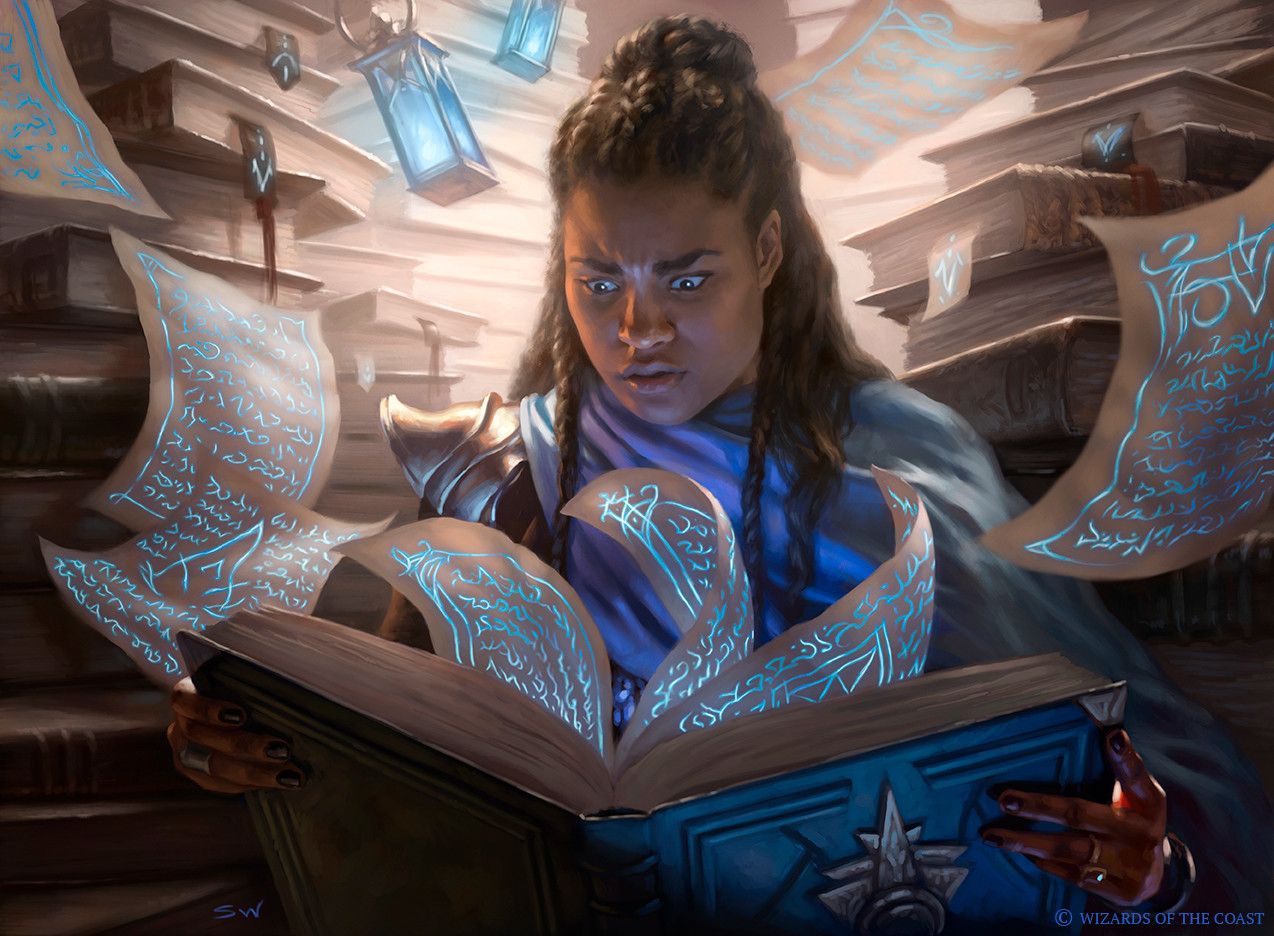


Stitcher
While most artificers are content with mechanical innovation, some see biology, the science of living things, as an area rife with potential. Stitchers are those who use their talents to supplement their own anatomy and create life. Combining necromancy and transmutation magic, Stitchers see all living things as prototypes that can be magically evolved.
Stitcher Specialization Features
| Artificer Level | Feature |
|---|---|
| 3rd | Stitcher Spells, Tools of the Trade, Stitcher's Graft |
| 5th | Augmented Flesh, Extra Attack |
| 9th | Strange Evolution |
| 15th | Master Stitcher |
Stitcher Specialization Spells
| Artificer Level | Spells |
|---|---|
| 3rd | false life, find familiar |
| 5th | alter self, dragon's breath XGtE |
| 9th | haste, life transference |
| 13th | giant insect, polymorph |
| 17th | insect plague, reincarnate |
Tools of the Trade
At 3rd level, you gain proficiency with leatherworker's tools. If you are already proficient with leatherworker's tools, you gain proficiency with another set of artisan's tools of your choice.
Stitcher's Graft
Starting at 3rd level, you enhance bodies by crafting or mutating a new part through grotesque experimentation. Using 10 minutes of time and 1 pound of organic matter, you can give a willing creature temporary hit points equal to your Intelligence modifier + your artificer level. Once a creature has gained temporary hit points this way, they cannot benefit from it again until they finish a short or long rest.
While you have temporary hit points, you can use your Intelligence score instead of Strength for attack rolls, ability checks, or saving throws that use your Strength.
Whenever you give yourself or another creature temporary hit points with a spell or ability, you may also grant them the benefits of one of the Grafted Traits below, which lasts as long as they have those temporary hit points.
Amphibious Physiology. You can breathe both air and water, and gains a 30 foot swim speed.
Resilient Hide. While you are not wearing any armor or using a shield, your Armor Class is equal to 10 + your Intelligence modifier + your Constitution modifier.
Extra Limb. You grow an additional limb which resembles your own limbs. It has a reach of 10 feet, and can lift a number of pounds equal to your Intelligence score. The limb can attack, but can't use weapons or shields nor can it do anything that requires manual precision.
Augmented Flesh
Starting at 5th level, you gain the following benefits:
- As a bonus action, you can expend a spell slot to grant yourself temporary hit points equal to five times the level of the spell slot + your Intelligence modifier.
- You may touch another creature as an action and sacrifice any amount of your temporary hit points, healing the target for the same amount by grafting your flesh to theirs. You can use this ability a number of times equal to your Intelligence modifier, and you regain all expended uses after you finish a long rest.
Extra Attack
Also starting at 5th level, you can attack twice, rather than once, whenever you take the Attack action on your turn.
Strange Evolution
At 9th level, you have enhanced your own physiology with strange magic. You permanently gain one Grafted Trait of your choice. You also gain a climbing speed equal to your movement speed, and you can climb difficult surfaces, including upside down on ceilings, without making an ability check.
When you reach 15th level in this class, you gain a second permanent Grafted Trait of your choice (for a total of two).
Master Stitcher
Beginning at 15th level, you have become a master amongst Stitcher artificers. When you target a creature with a spell of 1st-level or higher, you can grant a single target temporary hit points equal to your artificer level.
In addition, while you have temporary hit points, you are resistant to bludgeoning, piercing, and slashing damage.




Timethief
For those that pursue the magic of artifice, no area of study is too dangerous. Perhaps against their better judgment, some artificers choose to experiment with Chronomancy, the magic of time. Known as a Timethief, these bold artificers are marked by their signature Unwinding Clocks, a wondrous object which they use to steal moments of time.
Timethief Specialization Features
| Artificer Level | Feature |
|---|---|
| 3rd | Tools of the Trade, Timethief Spells, Unwinding Clock |
| 5th | Stolen Moments |
| 9th | Empowered Timethief |
| 15th | Master Timethief |
Timethief Specialization Spells
| Artificer Level | Spells |
|---|---|
| 3rd | expeditious retreat, featherfall |
| 5th | hold person, misty step |
| 9th | haste, slow |
| 13th | banishment, dimension door |
| 17th | hold monster, modify memory |
Tools of the Trade
At 3rd level, you gain proficiency with jeweler's tools. If you are already proficient with jeweler's tools, you instead gain proficiency with another set of artisan's tools of your choice.
Unwinding Clock
At 3rd level, at the end of a long rest, you can use your jeweler's tools to construct an Unwinding Clock. This is can be a watch, hourglass, or small sun dial, which can be used as a spellcasting focus by you for your artificer spells.
You can only have one Clock at a time, and creating another causes the magic within the first to dissipate.
Your Clock has a number of charges equal to twice your Intelligence modifier. It regains all expended charges when you finish a long rest. While your Chronometer is in hand, you can expend a charge to use the following abilities:
Accelerate. As an action, you increase the speed of a creature within 60 feet by a number feet equal to 5 times your Intelligence modifier until the end of their next turn.
Decelerate. As an action, you force a creature that within 60 feet to make a Charisma saving throw. On a failed save, its movement speed is reduced by a number feet equal to 5 times your Intelligence modifier until the end of its next turn.
Slip. As a reaction when a creature within 60 feet makes an attack roll or ability check, you can force them to have disadvantage on the roll.
Warp. As an action, you can switch places with a creature within 60 feet, each instantly teleporting to the other's space. An unwilling creature must succeed on a Charisma saving throw or be forced to switch places with you.
Stolen Moments
Beginning at 5th level, you gain a bonus to your damage rolls equal to your Intelligence modifier (minimum of +1) on creatures that are paralyzed, stunned, or has their movement speed reduced to 0.
Also, any of your Unwinding Clock abilities that require an action to use can also be used as a bonus action on your turn.
Empowered Chronomancy
At 9th level in this class, the magic of your Unwinding Clock improves in the following ways:
Accelerate. Opportunity attacks against the target creature have disadvantage until the end of their next turn.
Decelerate. You can spend an additional charge to double the movement speed reduction. If this feature reduces a target's speed to 0, it must succeed on a Constitution saving throw or be stunned until the end of its next turn.
Slip. You can spend two charges to use this reaction after the creature makes its attack roll or ability check, but before the DM determines whether the roll succeeds or fails, and force them to reroll it.
Warp. You can spend additional charges to increase the range by an additional 30 feet for each extra charge you expend.
Master Timethief
Starting at 15th level, when you successfully paralyze, stun, or reduce a creature's movement speed to 0 with a spell or Timethief ability, your Unwinding Clock regains one of its expended charges.
Also, you can overload your Unwinding Clock to cast time stop, expending any remaining charges. When you do so this way, you instead take extra turns equal to half the number of charges expended (rounded up).
Once you cast time stop in this way, you must finish a long rest before you can do so again.
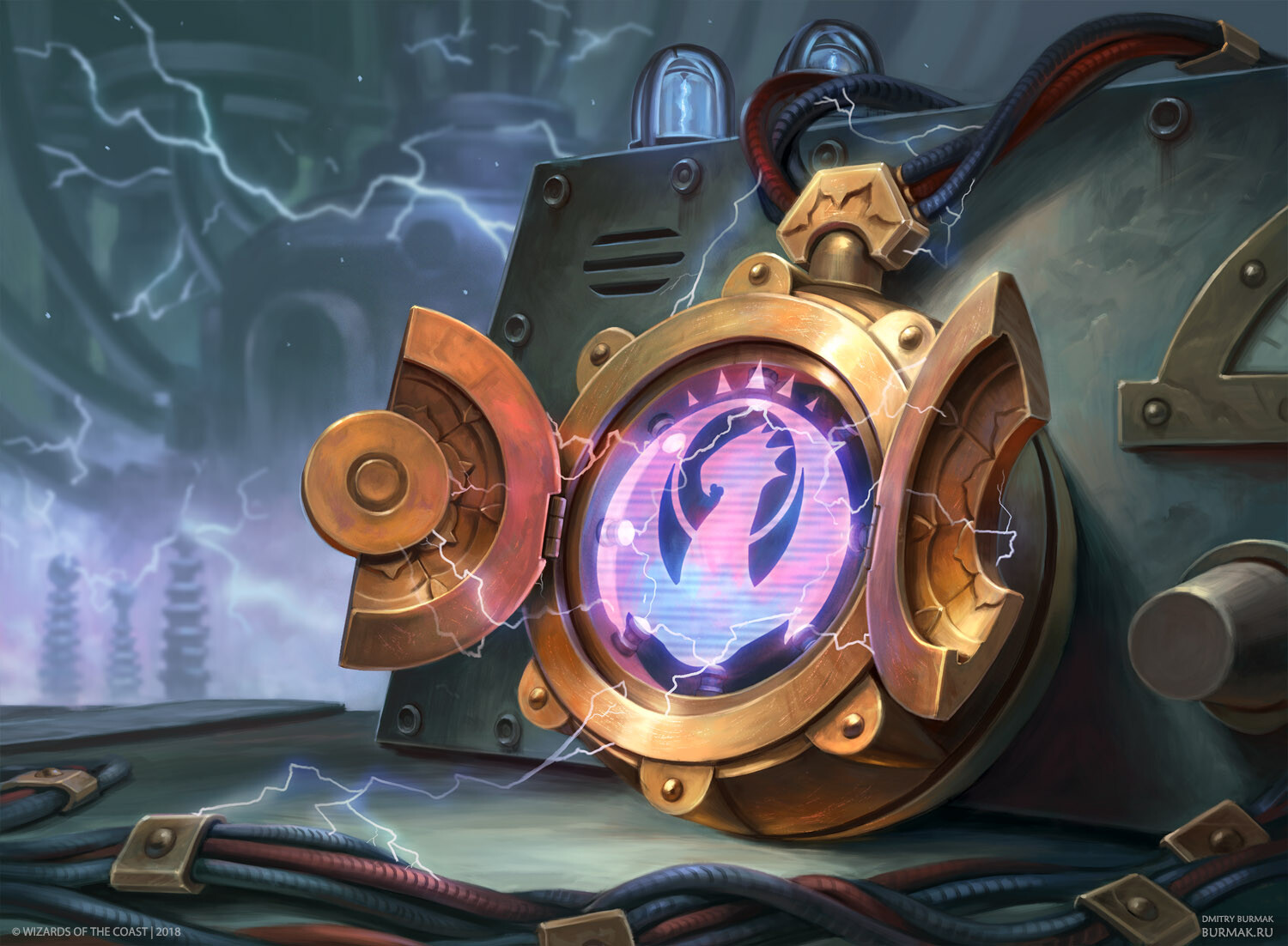


Barbarian
Path of the Bladestorm
Barbarians are notorious for being engines of destruction on the battlefield, and for none is this more apt a description than those that have chosen the Path of the Bladestorm. They are barbarians whose rage is such a transcendent force that their very weapons are restless embodiments of their destructive wrath.
When a Path of the Bladestorm Barbarian walks onto a battlefield, those unprepared to withstand the rain of sharp steel ought to hide until the storm passes. The ones who stay will have to face the winds of destruction as the barbarian at the center of the maelstrom smashes, hacks and slashes with the strength the of primal winds.
Path of the Bladestorm Features
| Barbarian Level | Feature |
|---|---|
| 3rd | Walking Armory, Furious Hurl |
| 6th | Whirling Death, Endless Blades |
| 10th | Winds of Rage |
| 14th | Bladestorm |
Walking Armory
Starting when you choose this path at 3rd level, all melee weapons with the light property also gain the thrown (20/60) property for you. Additionally, when you make an attack to throw a weapon, you can draw a weapon, either drawing a weapon before throwing it, or drawing a new weapon immediately after throwing the weapon if you have another weapon available.
Furious Hurl
Additionally at 3rd level, you can add your Rage bonus damage to thrown weapons, as well as use your Reckless Attack feature when you make a ranged weapon attack with a light melee weapon. Additionally, being within 5 feet of a hostile creature doesn't impose disadvantage on your ranged attack rolls.
Whirling Death
Starting at 6th level, when you throw a weapon while raging it becomes animated with your fury. A whirling weapon stays spinning where it was thrown until the end of your next turn, and automatically attacks the first hostile creature that ends its turn within 5 feet of it. A creature can only take damage from this feature once per turn. You can use your reaction to make an attack of opportunity with any weapon animated by this feature if a target moves out of its reach.
Endless Blades
Additionally at 6th level, while raging your rage suffuses any weapon within 20 feet of you that is not being worn or carried. As a bonus action, you can call one or more such weapons to your open hands. Any blade you throw counts as magical for the purpose of overcoming resistance and immunity to nonmagical attacks and damage.
Winds of Rage
Beginning at 10th level, the winds around you are tied to your anger. You learn the spell gust. Strength is your spellcasting stat for this spell. While you are raging, you can cast gust as a bonus action, and the range you can pick up weapons with Endless Blades increases to 60 feet.
Bladestorm
Starting at 14th level, as an action when you are raging, you can start a Bladestorm. You can fling out up two light melee weapons you are carrying and whip any weapons animated by Whirling Death into it. All creatures of your choosing within 20 feet of you must make a Dexterity saving throw with a DC of 8 + your proficiency modifier + your strength modifier. On failure, they take 1d6 damage for each blade that is part of the bladestorm (up to 4d6) + your Strength modifier + your rage bonus damage.
On subsequent turns while raging, you can use your action to keep the Bladestorm going, forcing all creatures of your choice within 20 feet to make the save again. You can keep a Bladestorm going for a number of turns equal to your Strength modifier. You can use this feature once per rage. When a bladestorm ends, all included weapons fall to the ground around you.
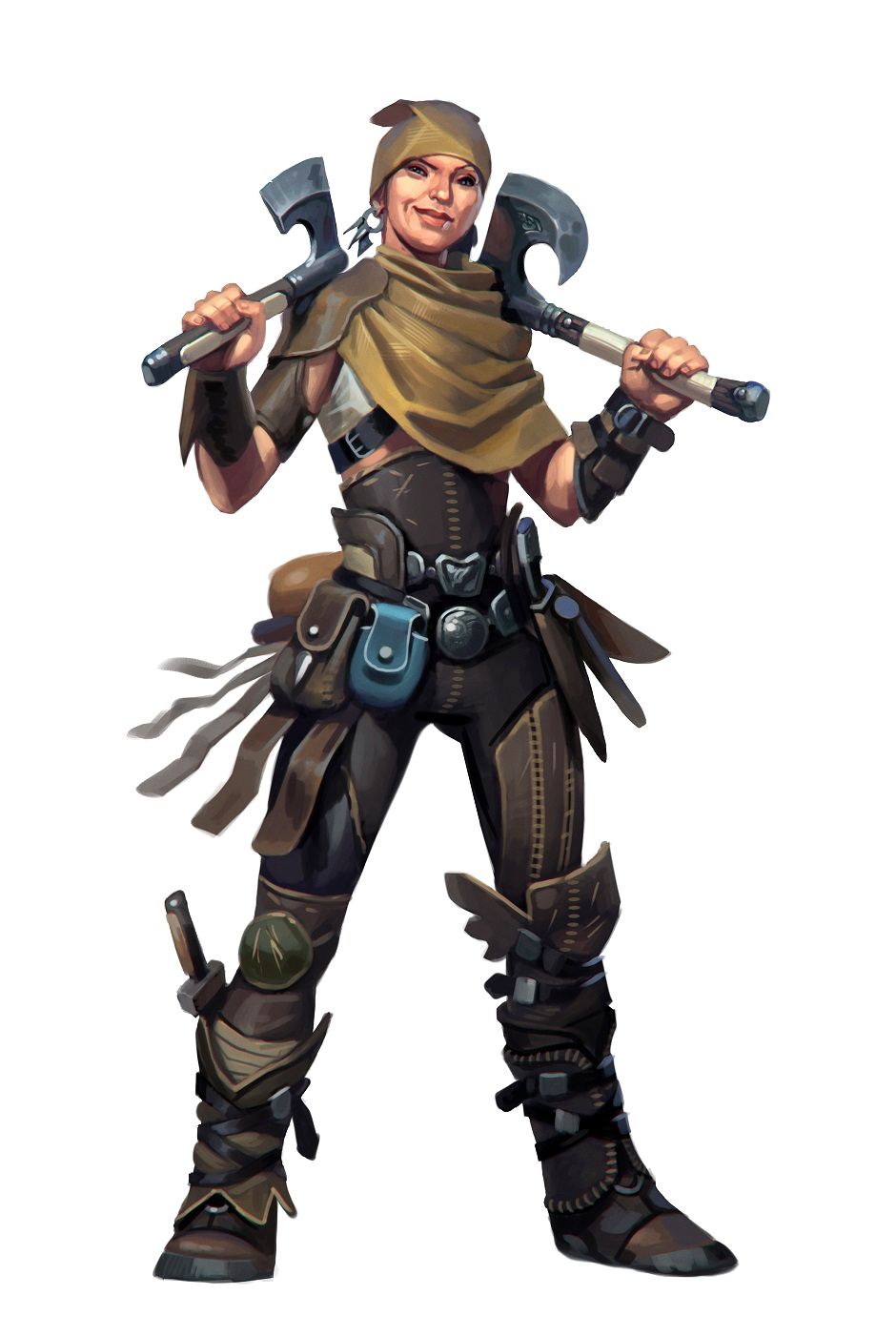
Path of Blood
The Path of Blood is a path taken by only the most ruthless and battle-hungry barbarians. Perhaps it is the evil influence of a demon, devil, or a haunting ghost that drives them to delight in bloodshed. Perhaps they are attuned to the joyful brutality of the mad gods of war. These barbarians do not care when they shed their own blood—in fact, they use that energy to empower their rage even farther, using their suffering and sacrifice to inflict wounds upon their foes.
Path of Blood Features
| Barbarian Level | Feature |
|---|---|
| 3rd | Bloodrage, Blood Rush |
| 6th | Scent of Death |
| 10th | Red in Tooth and Claw |
| 14th | Blood Drinker |
Bloodrage
Starting when you select this path at 3rd level, you learn to channel blood magic through your rage, allowing you to imbue dark power into your weaponry and drain the life of those that dare to strike you. While you rage, your speed is increased by 10 feet, and when a creature within 10 feet of you deals damage to you of a damage type that you have resistance to, you can choose to take that damage as if you had no resistance to it (no action required). If you choose to do so, the creature that damaged you takes necrotic or poison damage (your choice) equal to half the damage you took.
Blood Rush
At 3rd level, on your turn while raging, you may use a bonus action to spend a hit die to heal yourself. If you choose to do so, roll the die, add your Constitution modifier, and regain a number of hit points equal to the total (minimum of 1).
Deathly Resistance
At 6th level, choose poison or necrotic. While you rage, you gain resistance to the chosen damage type, and starting at 10th level you also gain resistance to the other damage type while you rage.
Scent of Death
At 6th level, you gain the ability to smell the scent of the injured from up to a mile away. You know scent's direction and the injured creature's type. Once you get within 1000 feet of the source, you can make a Wisdom (Perception) check against the creature's Dexterity (Stealth) check to pinpoint its location and identity. On a success, while you remain within 1000 feet, you know the exact distance and direction to the injured creature, the severity of its injury, and you determine its identity if you have encountered the creature before. On a failure, you cannot attempt this check again on the same scent for 1 hour.
Red in Tooth and Claw
At 10th level your body takes on a demonic change as your affinity for blood grows stronger. You can survive on meals of rotting meat, blood or bones and suffer no ill effects.
Additionally, your magic also allows you to regenerate more quickly. At the end of each long rest, you regain additional expended Hit Dice equal to your Constitution modifier (minimum of 1).
Blood Drinker
Beginning at 14th level, spilled blood bolsters your strength. Whenever a creature within 15 feet of you is struck by a critical hit or reduced to 0 hit points while you’re raging, you can use your reaction to move up to half your speed without provoking opportunity attacks, and make a single melee weapon attack.
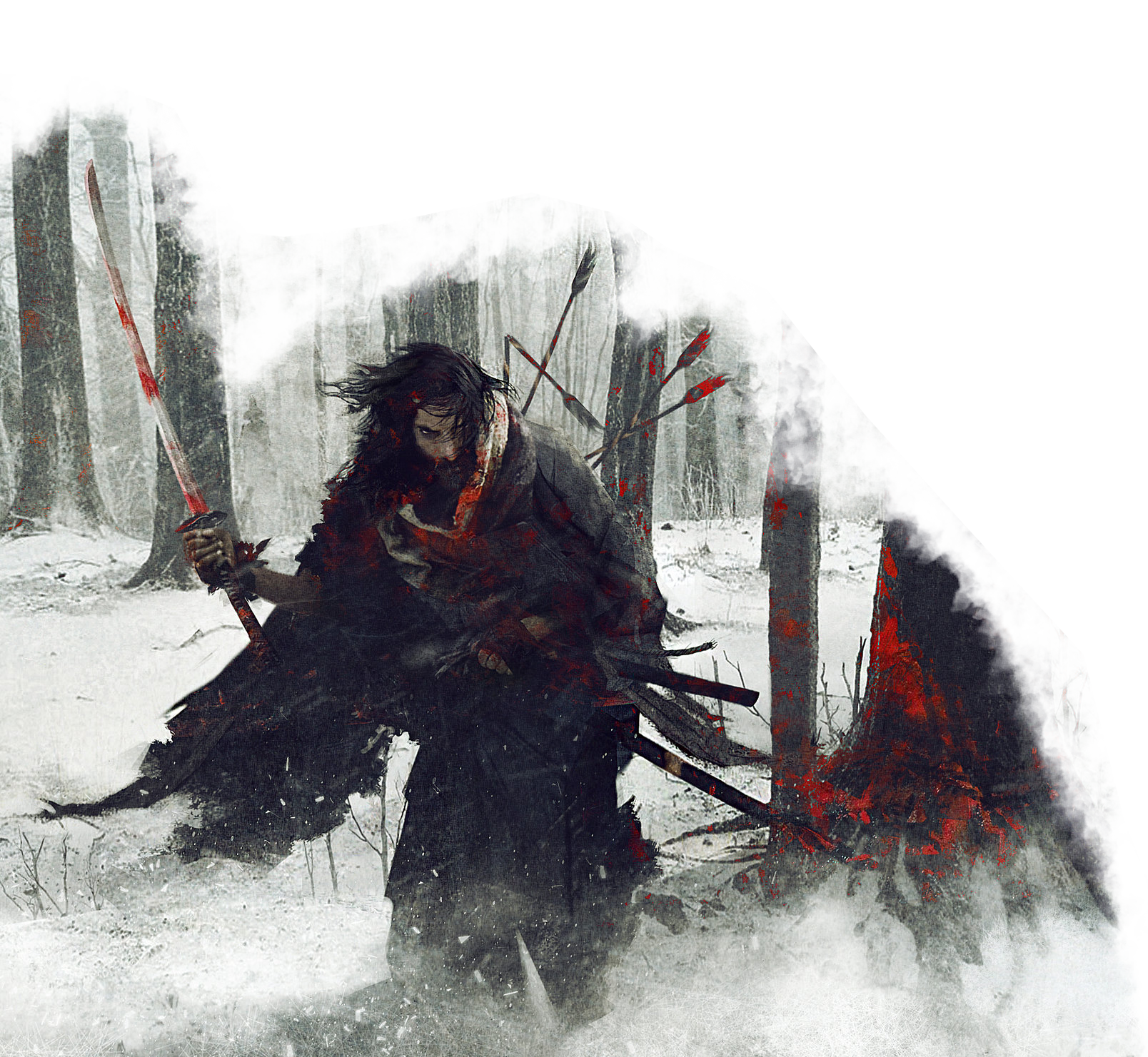


Path of Dread
There are places beyond time, filled with malignant intelligence and ruinous intent. The Far Realm is one such reality beyond the Material Plane, beyond the Elemental Chaos, even beyond the Upper Planes of the gods and the Outer Planes such as the Outlands. The Far Realm is entirely separate from the known multiverse, and it is believed that aberrations such as mind flayers and beholders either originated from this plane or were shaped by its strange influence.
You stepped through the door to nowhere that led to the Far Realms at some point in your past, yet your mind cracked under the horrible vistas of forgotten power that stood just within your feeble mortal grasp. Now you have finally realized that the true source of your furious rage is both defiance and acceptance of the madness that lies in the darkness between the stars.
Path of Dread Features
| Barbarian Level | Feature |
|---|---|
| 3rd | The Lurking Fear |
| 6th | From Beyond |
| 10th | The Thing on the Doorstep |
| 14th | What the Moon Brings |
The Lurking Fear
At 3rd level, in your bouts of rage you ramble about twisted things. You gain resistance to all damage inflicted by frightened creatures while you are raging.
Whenever you are raging, each creature that starts its turn within 10 feet of you must succeed on a Wisdom saving throw with DC equal to 8 + your proficiency bonus + your Charisma modifier or be frightened of you until the end of your next turn. Once a creature fails this saving throw, it can’t be frightened by this feature again for 1 minute.
Additionally, you can use your Charisma modifier in place of your Intelligence modifier when making skill checks and saving throws.
From Beyond
Starting at 6th level, your words seem to cut at the minds of those who listen even more horribly than before.
As an action, you whisper into the mind of a creature within 60 feet of you that can see and hear you. Until the end of your next turn, you have advantage on all ability checks, attack rolls, and saving throws involving your target or actions it has taken. During this time, the target has disadvantage on all ability checks and attack rolls involving you or actions you have taken. Targets that are immune to being frightened are immune to this effect.
You can use this ability once, and you recover your use of this ability whenever you enter a rage.
The Thing on the Doorstep
At 10th level, your hallucinations slowly enter reality. Whenever you enter a rage, you can choose to unleash the horrors that dwell within your mind upon the world.
Choose a number of creatures up to your Charisma modifier within 30 feet of you. Each one that is Large or smaller is pulled to the nearest open space within 5 feet of you, or the nearest available space by massive tendrils that spawn from the air around you.
Until the end of your turn, when the tendrils disappear, you cannot suffer disadvantage from any source on any check made to grapple one of these creatures.
What the Moon Brings
At 14th level, the tendrils of the Old Ones constantly lurk at the corners of your vision. Whenever you reduce a creature to 0 hit points, you can choose to allow an Old One to lash out from within your skin.
Choose a creature within 30 feet of you. The target must make a Strength (Athletics) or Dexterity (Acrobatics) check contested by your own Strength (Athletics) check. If the target fails, the tendril snares them and drags them into the closest open space near you, and the creature gains one level of exhaustion. A creature cannot be affected by this feature more than once per turn.




Path of Growth
The Path of the Blighted is a path of unholy origin, traced back to the same origin of the Blights: the Gulthias Tree. By gaining power from this evil source, you can channel your rage to shift your physical form, becoming a monstrous abomination of vines and branches. While transformed, you engulf and constrict your enemies as you tear them apart.
Path of Growth Features
| Barbarian Level | Feature |
|---|---|
| 3rd | Verdant Transformation |
| 6th | False Appearance |
| 10th | Unnatural Growth |
| 14th | Reactive Tendrils |
Verdant Transformation
When you choose this path at 3rd level, you take on a sprouting, bark-like form when you rage. For the duration of your rage, when you hit a creature with a weapon attack on your turn, you can use a bonus action to attempt to grapple the target with vines that sprout out of your body. This grapple does not require a free hand, but otherwise follows all of the rules for grappling. You can only have 1 creature grappled with this feature at a time.
If you already have a creature grappled with this feature, this bonus action instead constricts the target, causing them to take bludgeoning damage equal to half your barbarian level, rounded up.
False Appearance
Beginning at 6th level, your body is now able to become temporarily plantlike to hide from foes. You can attempt the Hide action against the surface of a plant, such as the bark of a tree, a large bush, or an area of thick vines. When you do so, you make a Dexterity (Stealth) check with advantage, remaining camouflaged until you move or take an action.
Unnatural Growth
At 10th level, you can cast the plant growth spell once with this feature, and you regain the ability to cast it this way once you finish a long rest.
Reactive Tendrils
Starting at 14th level, whenever you take damage from a creature within 5 feet of you while you're raging, you can use your reaction to release grasping vines at the attacker, attempting to grapple the target if you are not already grappling them, or injuring them if you are as if using your Verdant Transformation feature.
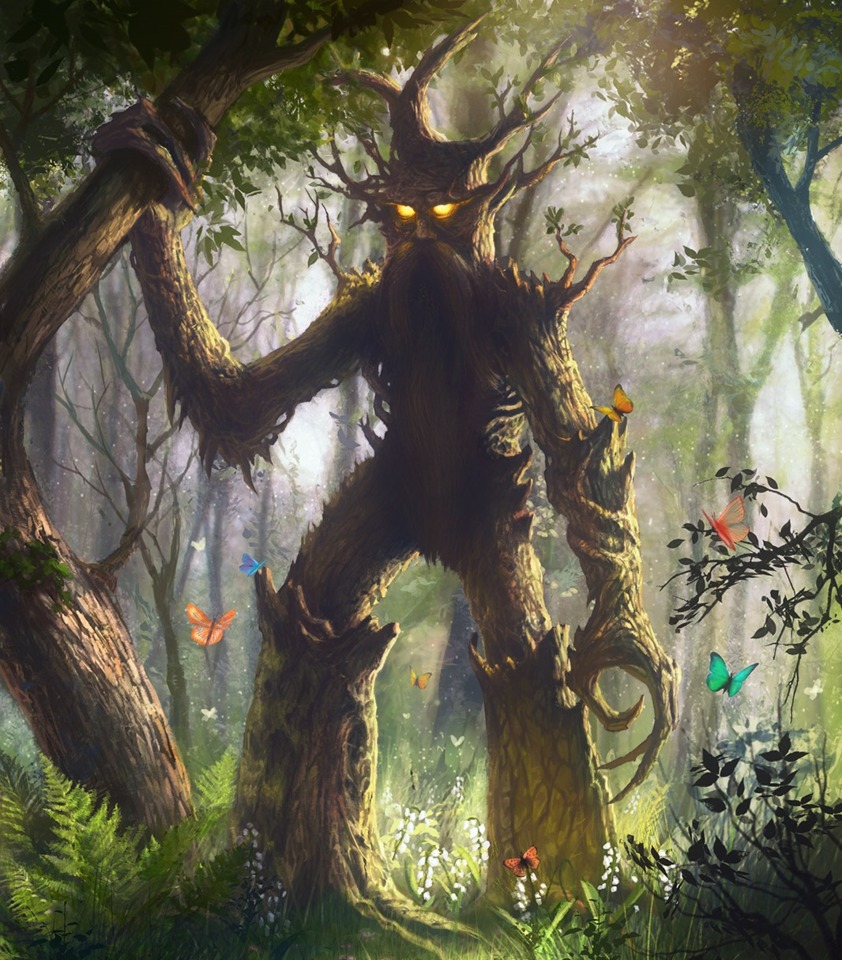



Path of the Primordials
Barbarians tap into primal powers, and a Barbarian of this path taps into one of the most ancient and primeval of them all. Those that walk the path of the primordials have learned to draw upon the fury of the elemental planes in the heat of battle, becoming one with the elemental chaos. Whether granted a boon of power by a primordial, suffused by the might of the elemental planes, or born with a fiery rage; whatever their origins, these barbarians can bend the very elements themselves to their will.
Path of the Primordials Features
| Barbarian Level | Feature |
|---|---|
| 3rd | Ancient Tongues, Elemental Affinity |
| 6th | Elements Unleashed |
| 10th | Primordial Resilience |
| 14th | One with the Elements |
Ancient Tongues
When choosing this path at 3rd level, you learn to read and write Primordial, and you have advantage on Charisma checks when interacting with elemental creatures.
Elemental Affinity
At 3rd level, you gain magical benefits based on your preferred element. Choose one of the following elemental heritages. If you spend at least 30 minutes meditating during the course of a long rest, you can change your elemental affinity to a different element on the list.
| Element Heritage | Element Type | Cantrip |
|---|---|---|
| Air | Lightning | gust |
| Earth | Acid | mold earth |
| Fire | Fire | control flames |
| Water | Cold | shape water |
You learn a cantrip associated with your chosen heritage, which you can cast even while raging.
In addition, your elemental affinity manifests when you enter a rage. While raging, your melee attacks gain the reach property, you gain resistance to your chosen element type, and your rage damage changes to that type.
Elements Unleashed
Starting at 6th level, once during a rage, you can unleash your rage into pure elemental energy and exhale a blast of elemental power as an action. Creatures within a 15-foot cone must make a Dexterity saving throw with DC of 8 + your proficiency modifier + your Strength modifier. A creature takes 6d6 damage of the Element Type of your Elemental Affinity on a failed save.
This damage increases by 2d6 at 9th level (8d6), 12th level (10d6), 15th level (12d6), and 18th level (14d6).
Primordial Resilience
Starting at 10th level, your primordial might grant you resistance to your Element Type and to bludgeoning, piercing, and slashing damage from nonmagical sources even when you are not raging.
One with the Elements
At 14th level, you have learned to unleash even more power from one of the elemental forces you wield. You gain additional benefits depending on your Elemental Affinity.
Air. Breathtaking wind whirls around you in a vortex. You have a flying speed of 30 feet, but you fall at the end of a turn if you are airborne and the only thing holding you aloft is your flying speed. For the duration of your rage, the area within a 10-foot radius of you is difficult terrain for hostile creatures, and ranged weapon attacks against you have disadvantage.
Earth. Your body becomes encased with a thick crust of elemental earth. You gain a burrowing speed of 30 feet, allowing you to pass through nonmagical earth and stone, leaving no hole behind you. If you would end your turn inside of earth or stone, you are pushed back to where you entered the earth or stone's surface. For the duration of your rage, your AC increases by 2 if you aren't wearing armor, and you have advantage on saving throws against being poisoned, stunned, forcefully moved, or knocked prone.
Fire. You can wreathe your body in a swirl of flame, burning any that would dare get close. Your movement speed is increased by 10 feet. For the duration of your rage, your rage damage becomes equal to your proficiency bonus.
Water. You embody the unstoppable power of a crushing wave. You have a swimming speed of 30 feet, and you can breath in both air and water. For the duration of your rage, you can take the Dash and Disengage actions as bonus actions, and you have advantage on Dexterity (Acrobatics) checks and on saving throws against becoming grappled or restrained. In addition, you can spend 5 feet on your turn when you are grappled or restrained to end that effect.
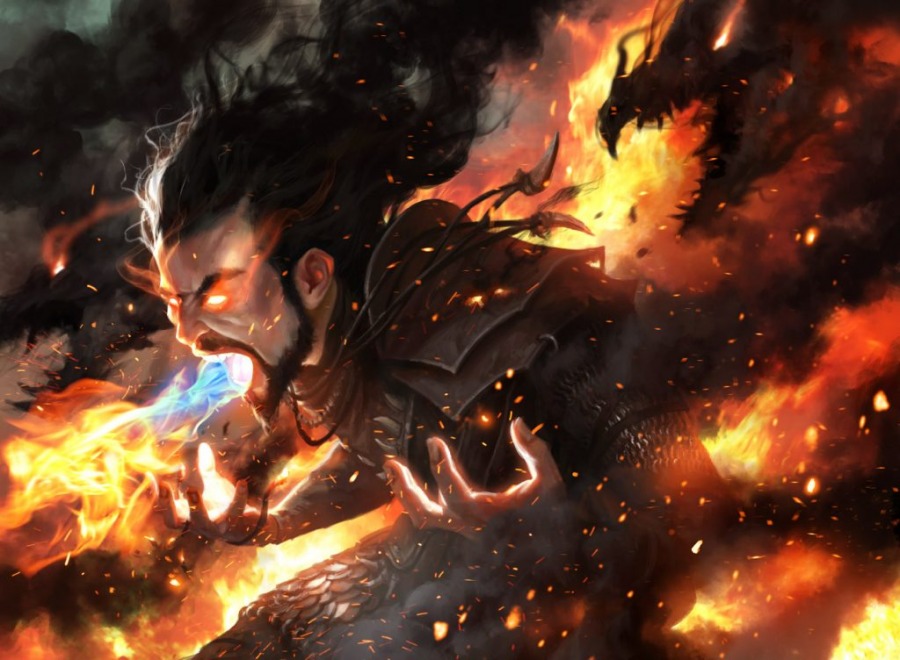
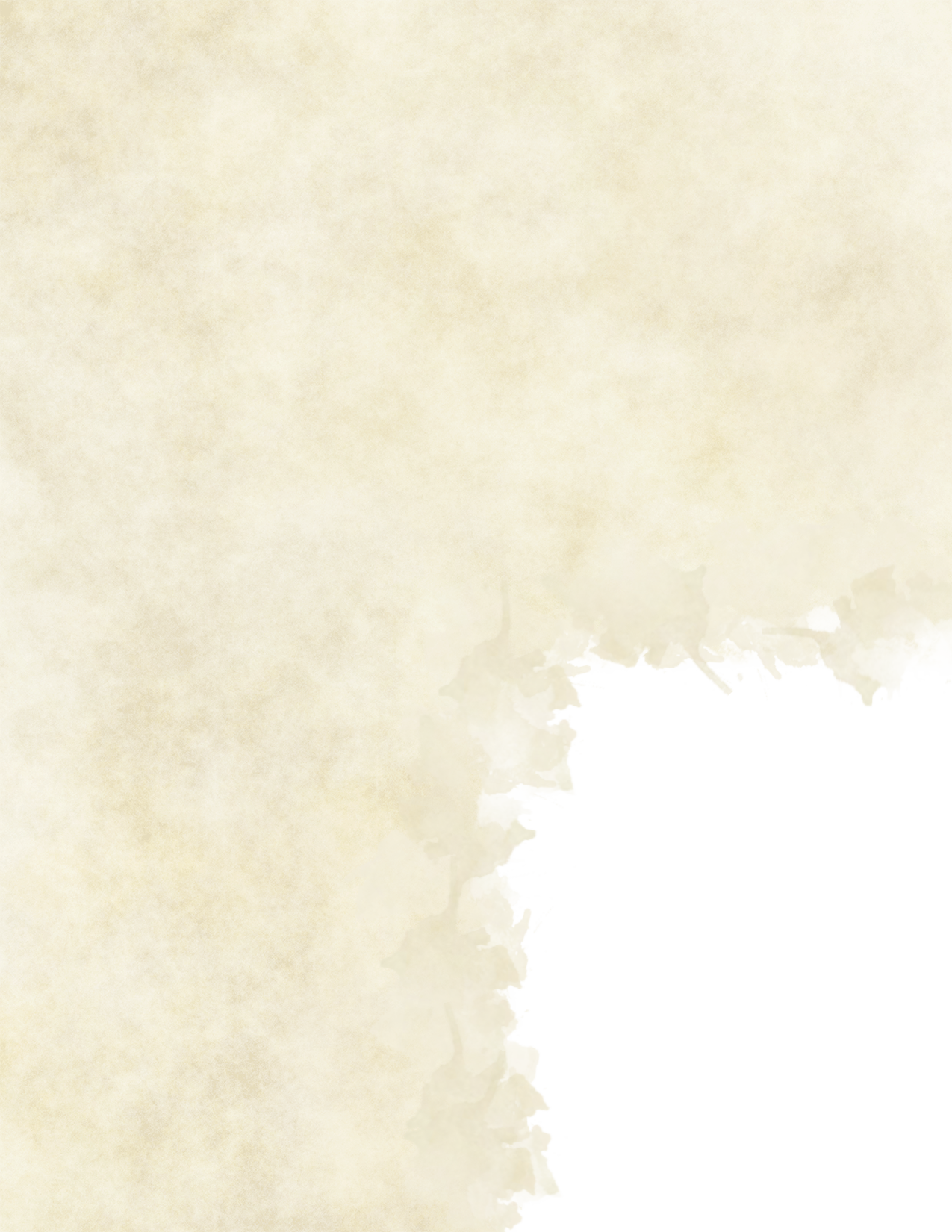

Bard
College of Color
Where other bards channel their creativity through an instrument, some choose to express themselves through painting. They attune to the colors of the world, becoming able to shape reality in ways few would think possible. Bards of the College of color also gain different abilities depending on which colors they favor, and as varied as a painter's palette.
College of Color Features
| Bard Level | Feature |
|---|---|
| 3rd | Bonus Proficiencies, Palette |
| 6th | Life Imitates Art |
| 14th | Chromatic Explosion |
Bonus proficiencies
When you join the College of color at 3rd level, you gain proficiency with Painter's supplies. You can use these supplies as your spellcasting focus, and your proficiency bonus is doubled for any ability check you make with it.
Palette
Also at 3rd level, you learn to temporarily attune to a set of colors. Select a number of colors equal to your proficiency bonus. You can expend one use of Bardic Inspiration as an action to target a creature you can see within 10 feet of you, including yourself. An unwilling target must succeed on a Wisdom saving throw against your spell save DC or be affected by one of the colors you selected. You can change your selection after a short or long rest.
- Black. The target is overwhelmed by horror and dread. For 1 minute, the target becomes frightened of you or one creature or object you designate within range that it can see. The target may repeat the saving throw at the end of each of its turns, ending the condition on a success.
- Red: The target is struck by sudden anger. For 10 minutes, they add a roll of your Bardic Inspiration die to all Strength ability checks and saving throws.
- Orange: The target is consumed by a surge of willpower. The target may immediately reroll a saving throw to end an effect causing them to be frightened, adding a roll of your Bardic Inspiration die to the roll and to all saving throws against being frightened for the next 10 minutes.
- Yellow: The target experiences spontaneous feelings of joy. For 10 minutes, the target adds a roll your Bardic Inspiration die to all its Charisma ability checks and saving throws.
- Green: The target is painted with a mixture of greens. For 10 minutes, the target adds a roll of your Bardic Inspiration die to all their Dexterity (Stealth) checks.
- Blue. The target experiences a moment of elucidating clarity. The target may immediately reroll a saving throw to end an effect causing them to be charmed, adding a roll of your Bardic Inspiration die to the roll and to all saving throws against being charmed for the next 10 minutes.
- Purple: The target is consumed by feelings of pride and superiority. They gain temporary hit points equal to your Bard level plus the number you roll on the Bardic Inspiration die until the end of your next turn.
- White: The target is enveloped by feelings of pleasant serenity. For 1 minute, the target cannot be hostile to other creatures. If the target was hostile before you used this feature, they become indifferent for the duration. This effect ends early if the target is attacked or harmed by a spell or if it witnesses its friends being harmed.
Life Imitates Art
At 6th level, your paintings become almost perfect copies of reality. You can cast alter self without expending a spell slot or providing material components. You can use this feature a number of times equal to your Charisma modifier (minimum of once), regaining expended uses on a long rest.
Furthermore, as part of your action when you cast a spell of the Illusion school, you can expend one use of your Bardic Inspiration. The DC of the check to detect it as an illusion is increased by the number you roll on the Bardic Inspiration die.
Chromatic Explosion
Starting at 14th level, as an action you can paint an evershifting cascade of color in the air. All creatures of your choice within 30 feet that can see the shifting colored shapes must make a Wisdom saving throw against your spell save DC. On a failure, a creature becomes stunned for 1 minute. At the end of each of their turns, creatures stunned by this feature can attempt to make the save again, ending the effect on a success. Once you have used this feature you cannot use it again until you have finished a short or long rest.
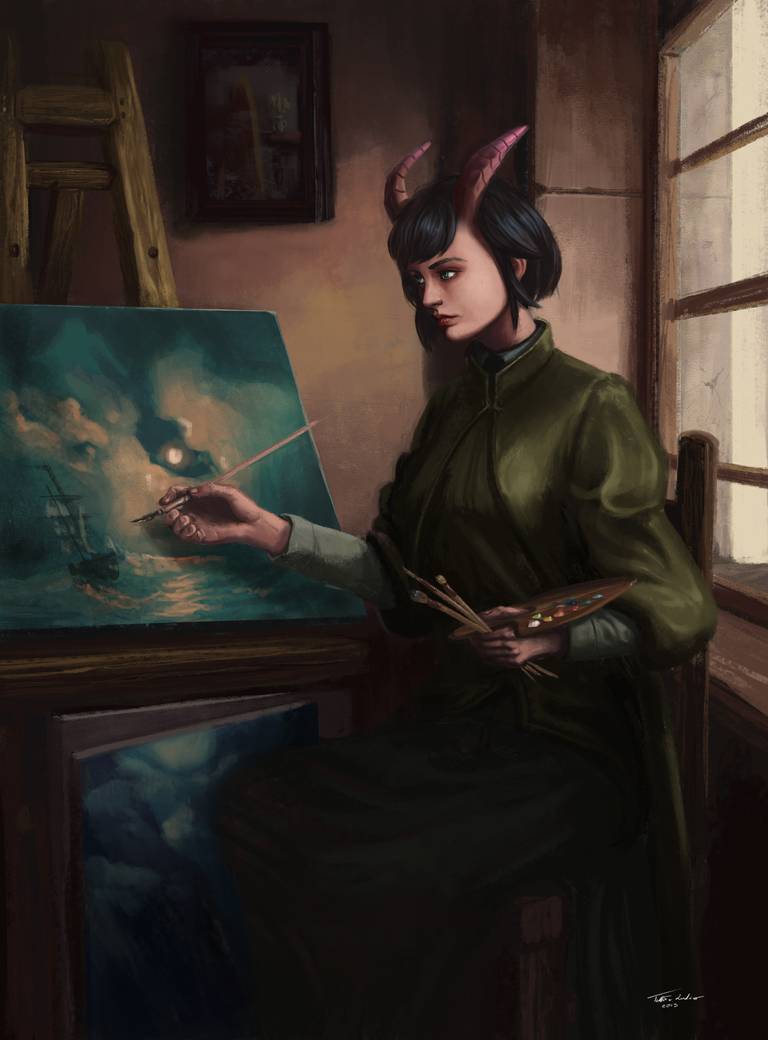




College of Diplomacy
Bards of the College of Diplomacy understand that statecraft, like music or drama, is a complicated artform. Formally trained as couriers, aides, stewards, geishas, and ambassadors, these performers use civility and social protocol to open doors where others cannot. In mastering their craft, these individuals also learn to see the connections between magical and social networks, and recognize how each can influence the other.
College of Diplomacy Features
| Bard Level | Feature |
|---|---|
| 3rd | Foreign Relations, Tactical Alliance |
| 6th | Secret Communique |
| 14th | Magical Networking |
Foreign Relations
When you join the College of Diplomacy at 3rd level, you learn the proper etiquette for handling those from other cultures. You learn three languages of your choice.
In addition, whenever you interact socially with a creature in a language other than Common. you have advantage on your Charisma (Deception), Charisma (Persuasion), and Wisdom (Insight) checks against it, but only if the creature can understand that language.
Tactical Alliance
Also at 3rd level, you can utilize your web of personal connections to extend your reach through the Weave. By expending a use of your Bardic Inspiration when you cast a bard spell, you can choose to cast the spell as if you were located in the space of a willing creature within 60 feet of you that can see or hear you. If the spell requires you to see a creature, you must be able to see them when you cast a spell in this way. When you cast a spell in this way, the willing creature also gains an amount of temporary hit points equal to the number rolled on the Bardic Inspiration die + your Charisma modifier (minimum of 1).
Secret Communique
From 6th level, your mastery of statecraft allows you to use a bonus action to communicate with but a meaningful look. Until the end of your next turn, you and any friendly creatures within 60 feet of you have advantage on their Charisma, Intelligence, and Wisdom saving throws, and can also communicate telepathically with any other affected targets they can see, regardless of their language.
After you use this feature, you cant do so again until you finish a short or long rest.
In addition, the ranges of both your Countercharm and Bardic Inspiration features are doubled, and if an ally can see you, it doesn't need to hear you to be affected by either of those features.
Magical Networking
Starting at 14th level, you can magically compel even your enemies to act cordially towards you.
As an action, you can force up to 5 creatures of your choice within 60 feet of you that can see and hear you to make a Wisdom saving throw against your spell save DC. A target automatically succeeds if it can't understand your language, but if it shares more than one language with you, it makes this save with disadvantage.
If a target fails its save, it becomes charmed by you and all of your allies it can see within 60 feet of you. This effect lasts until the end of your next turn if you are fighting the target or if you begin to fight it, or for 1 hour otherwise. This effect ends on a target if it notices you or your allies harm it or a creature it is friendly towards.
While charmed in this way, each affected target is convinced you are representing an individual, group, or power offering them fealty, an alliance, or a trade deal in its best interests. They will treat you hospitably, rationalize any of your hostile behaviors as unusual quirks, and try to persuade their allies to welcome you and your 'entourage.'
Once you use this feature, you can't do so again until you finish a long rest.
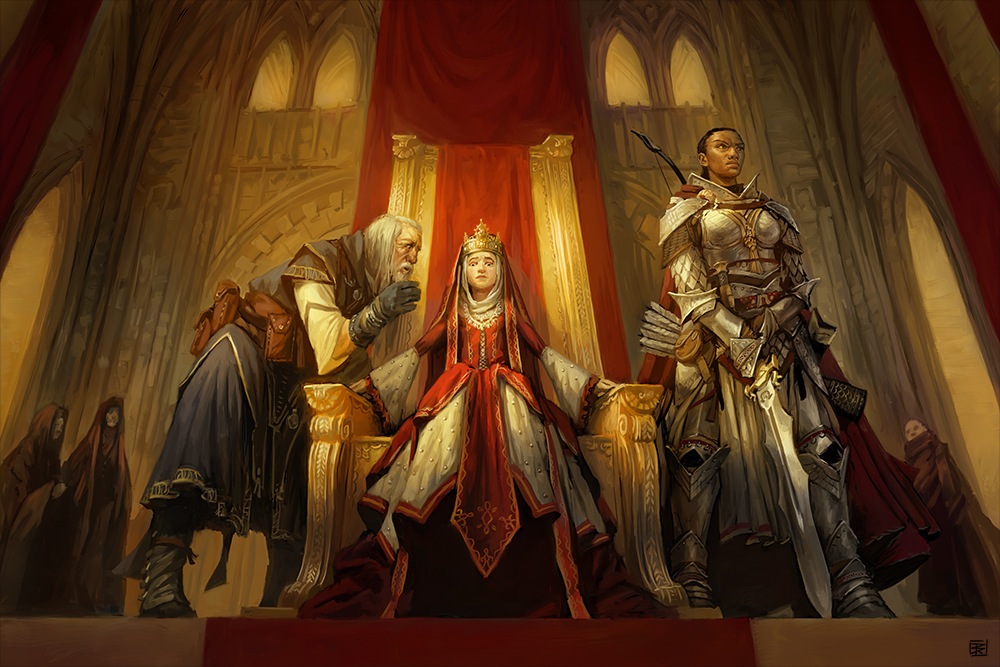

College of Marionettes
The College of Marionettes are a guild of puppeteers that turn the movement of wooden dolls into a masterpiece of animation. Using their nimble fingers and magic string, they can even control the bodies of the living and animate the dead to follow their precise instructions.
College of Marionettes Features
| Bard Level | Feature |
|---|---|
| 3rd | Bonus Proficiencies, Puppet Familiar |
| 6th | Soul Strings |
| 14th | Master of Puppets |
Bonus Proficiencies
When you join the College of Marionettes at 3rd level, you gain proficiency in weaver's tools and Sleight of Hand.
Puppet Familiar
At 3rd level, you learn find familiar if you didn't already know it. This spell does not count against your number of spells known. The spirit of your familiar summoned with this spell can occupy a puppet or marionette doll, which in turn can move of its own volition as your familiar, using the Living Puppet stats found below.
Additionally, when you take the Attack action, you can forgo one of your own attacks to allow your familiar to make one attack of its own. When your familiar makes an attack, it uses your spell attack bonus instead of its own attack bonus on attack rolls, and you may add your proficiency bonus to its damage rolls.
When you communicate with your familiar telepathically, you can also take precise control of its actions, allowing your puppet to use your ability or skill modifier for an ability check.
Soul Strings
By 6th level, as an action expending a Bardic Inspiration die, you can project from your fingertips barely noticeable strands of energy which can attach to creatures. Choose a living creature you can see within 30 feet to make a Wisdom saving throw against your spell save DC. On a failed save, your strings attach to the creature, bringing it under your complete control for up to 1 minute.
You can use your action each turn to maintain precise control of the target. It takes only the actions you choose, and doesn't do anything that you don't allow it to do. You cannot command an activity that is directly harmful to it.
At the end of each of its turns, an affected creature can make another Wisdom saving throw against this effect, ending it on a success.
While your strings are attached, you can take no other actions or move further than 30 feet from your target without you breaking the strings and ending the effect. A creature that successfully saves against the effect, or if the effect on it ends, is immune to the effects of this feature for the next 24 hours.
Master of Puppets
Beginning at 14th level, as an action, you can cast the irresistible dance or animate objects spell at its lowest level without expending a spell slot. Once you use this feature, you can't use it again until you finish a long rest.
Living Puppet
Tiny construct, neutral
- Armor Class 13 (natural armor)
- Hit Points 10 (4d4)
- Speed 20 ft.
STR DEX CON INT WIS CHA 4 (-3) 15 (+2) 11 (+0) 10 (+0) 10 (+0) 7 (-2)
- Damage Immunities poison
- Condition Immunities charmed, poisoned
- Senses darkvision 60 ft., passive Perception 10
- Languages understands the languages of its creator but can't speak
False Appearance. While the puppet remains motionless, it is indistinguishable from a mundane puppet or doll.
Telepathic Bond. While the puppet is on the same plane of existence as its master, it can magically convey what it senses to its master, and the two can communicate telepathically.
Ventriloquism. While the puppet is on the same plane of existence as its master, the master can telepathically command the puppet to speak, imitating his master's voice.
Actions
Bite. Melee Weapon Attack: +4 to hit, reach 5 ft., one target. Hit: 2 (1d4) slashing damage.
Scare (1/day). One creature of the living puppet's choice within 20 feet of it must succeed on a DC 10 Wisdom saving throw or be frightened for 1 minute. The target can repeat the saving throw at the end of each of its turns, with disadvantage if the living puppet is within line of sight, ending the effect on itself on a success.
College of Rhyme
Bards of the College of Rhyme are experts in the spoken word, able to compose verse and prose almost effortlessly. Some bards of this college compose epic ballads and sonnets, creating masterpieces of epic poetry. Others perform by improvising rhythmic poetry accompanied by music in taverns and mead halls, competing in contests of wit and verbal mastery.
Whether practicing language to capture the splendor of great deeds or to spit out 'sick burns', the bards of this college are prepared for a life of excitement and epic verses.
College of Rhyme Features
| Bard Level | Feature |
|---|---|
| 3rd | Student of Diction, Epic Verses |
| 6th | Battle Poetry, Master Linguist |
| 14th | Rapid Epithets |
Student of Diction
When you join the College of Rhyme at 3rd level, you gain proficiency with Deception and Persuasion. You learn the vicious mockery cantrip if you don't already know it, or another bard cantrip of your choice if you do.
Epic Verses
Starting at 3rd level, when you cast vicious mockery, if the target fails their saving throw you can expend a Bardic Inspiration to compose a verse of...
Hubris: You gain temporary hit points equal the number rolled on the Bardic Inspiration die + the damage dealt by vicious mockery.
Tragedy: The target takes additional damage equal to amount rolled on the inspiration die, and has disadvantage for an additional attack from vicious mockery.
Comedy: If the target attempts to attack anyone other than you before the start of their next turn, you can roll a die equal to your inspiration die and subtract it from their attack roll.
Battle Poetry
Starting at 6th level, when you cast a spell that deals Psychic damage, you can add your Charisma modifier to one damage roll of that spell.
Additionally, as a reaction to the end of an incapacitation effect another creature suffered form one of your spells, or to them missing an attack that had disadvantage caused by your vicious mockery, you can deal a verbal follow up dealing Psychic damage equal to your Charisma modifier.
Master Linguist
Additionally at 6th level, your ability to communicate transcends barriers of language. You can communicate basic concepts to creatures that don't share a language with you as long that creature speaks at least one language through intonation, body language, gestures, and attitude.
Using this method you can get information such as how much something should cost, where a notable locations are, what might be edible, and which paths or alleyways should be avoided, as well other things your DM might find appropriate for you to be able to learn from them.
You also gain the ability to read these basic concepts from written thieves' cant.
Rapid Epithets
Starting at 14th level, your can deliver verbal components to spells with blinding speed and precision. You can expend a use of Bardic Inspiration to cast a spell with the cast time of one action as a bonus action as long as it only has verbal components.


Cleric
Beauty Domain
Beauty can both bend minds and inspire hearts. It is the force that compels others to lose control and give in to their impulses, but it can also awaken strength and determination to steel a forlorn heart. Aphrodite, Sune, Myhriss, Sheela Peryroyl, Eilistraee, Freya, Hanali Celanil and Branchala all include beauty, love and romance in their portfolios. These gods are patrons of bards, musicians, artists and all who dedicate themselves to instill beauty in the hearts of others.
The Gods of Beauty and their clerics officiate weddings, arrange dates, and counsel those who have lost sight of what made them fall in love in the first place, all in the hopes that more people will be able to experience the wonder of true love and championing the pursuit of beauty itself.
Beauty Domain Features
| Cleric Level | Feature |
|---|---|
| 1st | Domain Spells, Bonus Proficiencies, Graceful |
| 2nd | Channel Divinity: Inner Beauty |
| 6th | Channel Divinity: Blinding Beauty |
| 8th | Potent Spellcasting |
| 17th | Unearthly Beauty |
Beauty Domain Spells
| Cleric Level | Spells |
|---|---|
| 1st | charm person, disguise self |
| 3rd | enthrall, lesser restoration |
| 5th | beacon of hope, hypnotic pattern |
| 7th | aura of purity, compulsion |
| 9th | greater restoration, seeming |
Bonus Proficiencies
When you choose this domain at 1st level, you gain proficiency in the Persuasion skill. Additionally, you gain proficiency with the Disguise kit and two musical instruments of your choice.
Graceful
Beginning at 1st level, your inner and outer beauty makes you harder to hit. While you are wearing no armor and not wielding a shield, your AC equals 10 + your Wisdom modifier + your Charisma modifier.
Channel Divinity: Inner Beauty
Starting at 2nd level, you can use your action to change the physical appearance and self-image of a creature you see within 30 feet of you, revealing its true grace or exposing its ugliness for 10 minutes. Choose one of the following effects:
- The creature must succeed on a Charisma saving throw or become insecure and have its body and visage slightly twisted and deformed, gaining disadvantage on Dexterity and Charisma ability checks for the duration.
- The creature is filled with confidence and it becomes lovelier and more elegant, gaining advantage on Dexterity and Charisma ability checks for the duration.
Channel Divinity: Blinding Beauty
Starting at 6th level, you can use your Channel Divinity to take on a form so beautiful that mortal eyes cannot stand. As an action, you present your holy symbol. Choose a number of creatures up to your Wisdom modifier within 30 feet of you that can see you. Each creature must succeed on a Wisdom saving throw or be blinded until the end of your next turn.
Potent Spellcasting
Starting at 8th level, you add your Wisdom modifier to the damage you deal with any cleric cantrip.
Unearthly Beauty
Starting at 17th level, creatures failing their saving throw against your Channel Divinity options take 5d10 psychic damage and have their speed reduced to 0 until the end of their next turn.
Additionally, you can use your action to transform yourself into a vision of perfect beauty for 1 minute or until you dismiss the effect. During that time, creatures that can see you have disadvantage on attack rolls against you. Creatures immune to being charmed are immune to these effects.
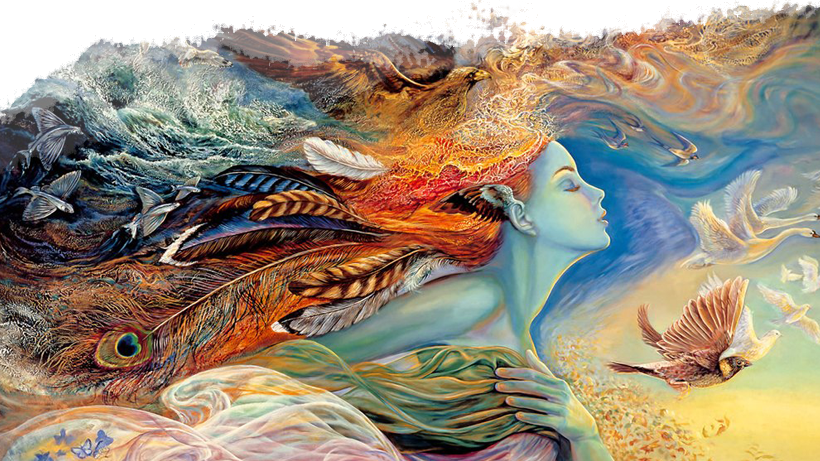
Fate Domain
Clerics of the fate domain peer through the corridors of time and manipulate the threads of destiny that bind the lives of mortals. Tyche, Saturn, Chronos, Kali, Urd, and other deities of death, time, luck and prophecy call upon their clerics to act as oracles and seers of the future — and to intervene when the time is right. Oracles of benevolent pantheons often guide heroes to their destinies, while others may lead them astray or foretell prophecies of ruin, destruction, and endless chaos.
Fate Domain Features
| Cleric Level | Feature |
|---|---|
| 1st | Domain Spells, Bonus Proficiencies, Glimpse the Future |
| 2nd | Channel Divinity: Tip the Scales |
| 6th | Fortune's Favor |
| 8th | Divine Strike |
| 17th | Fate Foretold |
Fate Domain Spells
| Cleric Level | Spells |
|---|---|
| 1st | bane, bless |
| 3rd | augury, gentle repose |
| 5th | bestow curse, remove curse |
| 7th | death ward, divination |
| 9th | legend lore, reincarnate |
Bonus Proficiencies
At 1st level, you gain proficiency with heavy armor and the History skill.
Glimpse the Future
From 1st level, you can protect yourself and others by seeing misfortune before it happens. If you or an allied creature you can see within 30 feet is hit by an attack from an attacker you can see, you can use your reaction to add 1d4 to the creature's AC until the end of turn, potentially causing the attack to miss.
You can use this feature a number of times equal to your Wisdom modifier (a minimum of once). You regain all expended uses when you finish a short or long rest.
Channel Divinity: Tip the Scales
Starting at 2nd level, you can use your Channel Divinity to tug on the strings of fate. As an action, you can present your holy symbol and select a creature you can see within 60 feet. Until the end of your next turn, the target makes all attack rolls and saving throws with advantage.
Fortune's Favor
Starting at 6th level, when an attack roll is made against you and misses you, you can choose to gain temporary hit points equal to twice your cleric level. These temporary hit points last until the beginning of your next turn.
Once you use this feature, you cannot do so again until you finish a short or long rest.
Divine Strike
At 8th level, you gain the ability to infuse your weapon strikes with divine energy. Once on each of your turns when you hit a creature with a weapon attack, you can cause the attack to deal an extra 1d8 radiant damage to the target. When you reach 14th level, the extra damage increases to 2d8.
Fate Foretold
Starting at 17th level, when you or an ally you can see within 30 feet of you fails a saving throw, you can replace the roll with a 20, potentially changing the outcome. Once you use this feature, you can’t use it again until you finish a short or long rest.
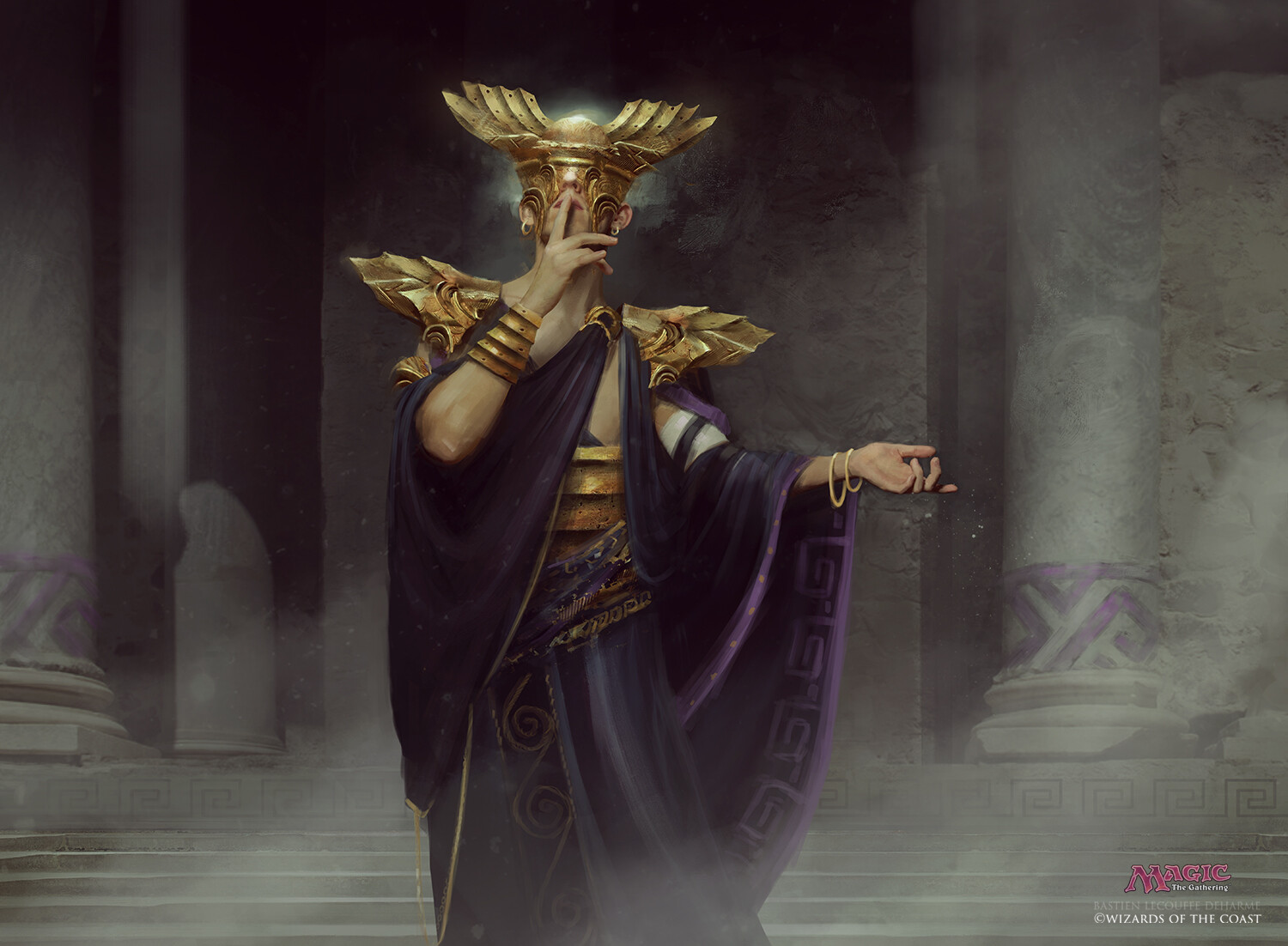


Judgment Domain
A Judgment Domain cleric is a cleric who oversees the distribution of law and order. They may do so in the name Justice itself, at the behest of an institution of justice in the land, or in service to a particular face of justice. Gods of the Judgement Domain exemplify order and lawfulness, and the pursuit of reparations and retributions. This includes Tyr, Forseti, Helm, Torm, or even Asmodeus and Bane for those that dispense the Iron Fist of Tyranny upon the world.
Some Judgement clerics are ruthless in their pursuit of the higher ideal of justice, while others are more forgiving. Clerics of this domain often act as judges, lawyers, and investigators.
Judgement Domain Features
| Cleric Level | Feature |
|---|---|
| 1st | Domain Spells, Bonus Cantrip, Divine Retribution |
| 2nd | Channel Divinity: Chains of Reckoning |
| 6th | Vengeful Retaliation |
| 8th | Potent Cantrip |
| 17th | Eternal Judgement |
Judgment Domain Spells
| Cleric Level | Spells |
|---|---|
| 1st | sanctuary, hellish rebuke |
| 3rd | detect thoughts, zone of truth |
| 5th | counterspell, fear |
| 7th | banishment, locate creature |
| 9th | dispel good and evil, geas |
Bonus Cantrip
When you choose this domain at 1st level, you gain the sacred flame cantrip if you don't already know it.
Divine Retribution
Starting at 1st level, when you deal damage to a creature with a cleric spell, you can apply additional damage to a creature equal to your Wisdom modifier if that target has dealt damage to another creature since the end of your last turn.
You use this feature a number of times equal to your Wisdom modifier, regaining all expended uses on a long rest. If a spell effects multiple creatures, you can apply Divine Retribution to multiple targets, but each application counts as a separate use of the ability.
Channel Divinity: Chains of Reckoning
Starting at 2nd level, you can use your Channel Divinity to invoke judgement upon your enemies. As an action, you present your holy symbol, invoking sacred judgement on a creature you can see within 60 feet of you. For 1 minute, you can apply the bonus damage of Divine Retribution to that creature when dealing damage with a cleric spell.
The chosen creature must also make a Wisdom saving throw. On a failed save, the creature is knocked prone and their movement speed becomes 0 for 1 minute as they are restrained by divine chains. The creature can repeat their saving throw at the end of each of their turns. If the creature has dealt damage since the start of their turn, they make this save at disadvantage.
Vengeful Retaliation
Starting at 6th level, when an allied creature within 60 feet of you takes damage from another creature while under the effect of a sanctuary spell you cast, or if they are reduced to 0 hit points, you can cast hellish rebuke against the attacker at its lowest level without expending a spell slot.
You can do this a number of times equal to your Wisdom modifier, and regain all uses on a long rest.
Potent Cantrip
Starting at 8th level, you add your Wisdom modifier to the damage you deal with any cleric cantrip.
Eternal Judgement
Starting at 17th level, your Divine Retribution can be used an unlimited number of times.
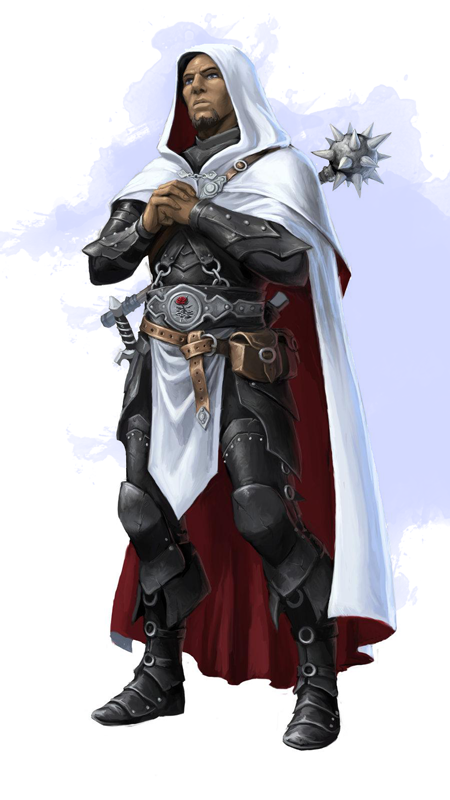
Madness Domain
Clerics who follow the Madness Domain pursue the deities and god-like beings of foreign realms governed by utterly alien and incomprehensible laws of magic and physics that would send most mortal minds spiraling into delusion and hysteria.
Madness Domain Features
| Cleric Level | Feature |
|---|---|
| 1st | Domain Spells, Aberrant Gift, Phase Step |
| 2nd | Channel Divinity: Far Rift |
| 6th | Channel Divinity: Bend Space |
| 8th | Potent Spellcasting |
| 17th | Impart Madness |
Madness Domain Spells
| Cleric Level | Spells |
|---|---|
| 1st | arms of Hadar, cause fear |
| 3rd | crown of madness, phantasmal force |
| 5th | enemies abound, hunger of Hadar |
| 7th | confusion, Evard's black tentacles |
| 9th | enervation, legend lore |
Aberrant Gift
At 1st level, you learn to speak and understand Deep Speech, and you learn the minor illusion cantrip. For you, this cantrip counts as a cleric cantrip.
Phase Step
Also at 1st level, you gain the ability to move through other creatures as if they were difficult terrain. If you end your turn in another creature's space, you take 1d10 force damage and are pushed to the nearest unoccupied space.
When you move through a hostile creature's space in this way, you can use your bonus action to pierce the creature's mind with imagery of terrifying eyes and inky, black tentacles. If the target is not an aberration, it must make a Wisdom saving throw or take 2d8 psychic damage. Whether your target succeeds or fails on this saving throw, it can't make opportunity attacks against you for the rest of your turn.
You can use this bonus action a number of times equal to your Wisdom modifier (a minimum of once). You regain all expended uses when you finish a long rest.
Channel Divinity: Far Rift
Starting at 2nd level, you can use your Channel Divinity as an action to present your holy symbol and open up a rift in space. Choose a point centered on an unoccupied 10-foot cube within 60 feet of you. The rift appears as a 5-foot radius sphere of blackness with long, lashing tendrils.
Choose a number of creatures you can see up to your Wisdom modifier within 30 feet of the sphere. Each target must succeed on a Dexterity saving throw or be pulled 20 feet toward the sphere. A creature that is pulled into the sphere's space takes psychic damage equal to 2d8 + your cleric level. The rift then closes.
Channel Divinity: Bend Space
When you reach 6th level, you can use your Channel Divinity to manipulate the fabric of space itself. Whenever you or a friendly creature within 30 feet of you would be hit by an attack, you can use your reaction to warp the space between the target of the attack and another willing creature you can see within 30 feet of you. If both chosen creatures are Large or smaller, you teleport the two creatures, exchanging their positions and forcing the attack to target the other creature. The new target of the attack gains a +2 bonus to AC against the attack, as the sudden swap confounds the attacker.
Potent Spellcasting
Starting at 8th level, you add your Wisdom modifier to the damage you deal with any cleric cantrip.
Impart Madness
Starting at 17th level, whenever a creature takes damage from your Phase Step or Far Rift, you can bestow an effect of madness on that creature which lasts for 1 minute or until you lose your concentration (as if you were concentrating on a spell). At the end of each of its turns, and each time it takes damage, it can make an Intelligence saving throw against your cleric spell save DC, ending the effect on a success.
Roll on the table below to determine the effect the madness has on the creature.
Madness Effects
| d10 | Effect |
|---|---|
| 1 | The creature retreats into its mind and becomes paralyzed. |
| 2 | The creature becomes incapacitated, and uses its movement on each of its turns to move in a random direction. |
| 3 | The creature becomes frightened of you and, as long as it has line of sight to you, must take the Dash action and move away from you by the safest available route on each of its turns, unless there is nowhere to move. |
| 4 | The creature begins babbling, can't understand what other creatures say, and is incapable of coherent speech or casting spells with a verbal component. |
| 5 | The creature must use its action each round to attack the nearest creature, using its movement if necessary to do so. If it is incapable of attacking the nearest creature, it wastes its action doing nothing. |
| 6 | The creature experiences vivid hallucinations and has disadvantage on all ability checks. |
| 7 | The creature is charmed by you and, if it can hear and understand you, does whatever you tell it to do that isn't obviously harmful to it. |
| 8 | The creature becomes incapacitated and begins uncontrollably screaming, laughing, or weeping. |
| 9 | The creature falls prone and is stunned. |
| 10 | The creature falls unconscious. |
Pain Domain
The world is filled with pain and torment, and the best that one can do is to endure and deal as much pain back to those who offend. The gods of suffering teach that suffering is a real, inescapable part of life. Pain tests all, but gives strength of spirit to the hardy and the true.
The gods of suffering are patrons of those who undergo great hardship, torment, or persecution. Clerics of these deities can use their magic to take the burdens from others and return agony to the guilty. Deities of this domain include gods of pain such as Iuz the Old, Ilmater the Crying God and Loviatar the Maiden of Pain, as well as gods of vengeance like Nemesis.
Pain Domain Features
| Cleric Level | Feature |
|---|---|
| 1st | Domain Spells, Bonus Proficiencies, Shared Suffering |
| 2nd | Channel Divinity: Tendrils of Agony |
| 6th | Hardened By Pain |
| 8th | Divine Strike |
| 17th | Decree of Pain |
Pain Domain Spells
| Cleric Level | Spells |
|---|---|
| 1st | cause fear, compelled duel |
| 3rd | branding smite, warding bond |
| 5th | life transference, vampiric touch |
| 7th | blight, death ward |
| 9th | enervation, modify memory |
Bonus Proficiencies
Starting at 1st level you gain proficiency with martial weapons.
Channel Divinity: Tendrils of Agony
Starting at 2nd level, as an action, you can present your holy symbol and expend a use of your Channel Divinity to unleash a wave of agony that ripples outward from you. Choose a number of creatures up to your Wisdom modifier within 30 feet of you. These creatures must succeed on a Wisdom saving throw against your cleric spell save DC. On a failed save, a creature takes psychic damage equal to 2d6 + your cleric level and the creature is incapacitated for 1 minute. On a successful save, a creature takes half as much damage and suffers no other effects.
An affected creature can repeat the saving throw at the end of each of its turns, ending the effect on itself on a success.
Hardened by Pain
Starting at 6th level your experiences with pain has hardened you against life's misery and stress, granting you the following benefits:
- You gain resistance to psychic damage.
- You have advantage on saving throws against being charmed or frightened as well as against short-term or long-term madness effects.
Divine Strike
Starting at 8th level you gain the ability to infuse your weapon strikes. Once on each of your turns when you hit a creature with a weapon attack, you can cause the attack to deal an extra 1d8 psychic damage to the target. When you reach 14th level the extra damage increases to 2d8.
Decree of Pain
Beginning at 17th level, you may use your Shared Suffering feature an unlimited number of times, including as a reaction when you would take damage.
When you use your Shared Suffering feature to redirect damage, you can redirect the damage to another creature you can see within 30 feet of you instead of yourself. An unwilling creature can resist the effect by making a Wisdom saving throw against your spell save DC, preventing the damage redirection on a successful save.
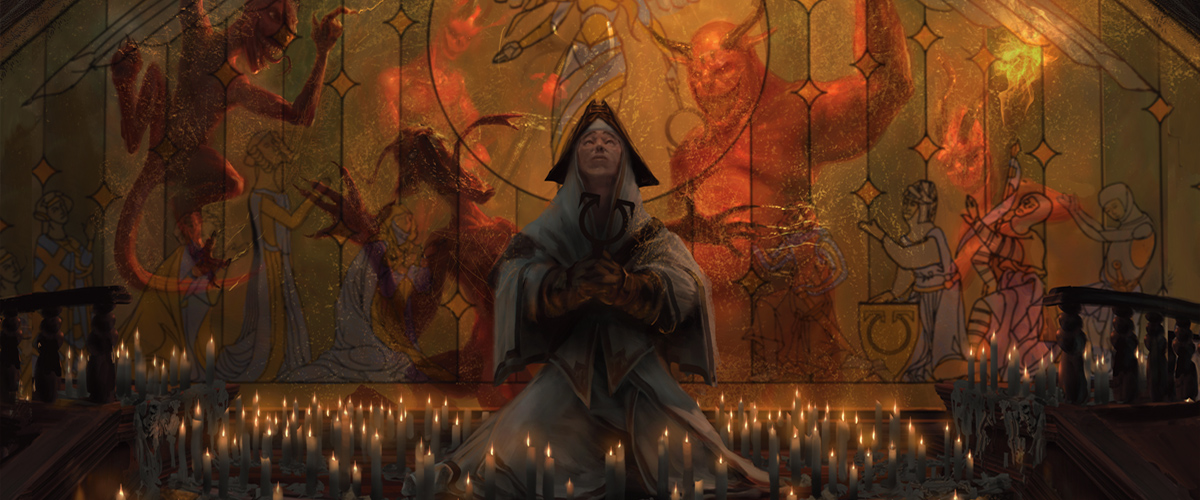


Shadow Domain
Followers of Shadow worship many gods. Some are gods of twilight and dusk that work in tandem with the forces of the natural world. Others are sinister gods worshiped by those that live deep underground, who fear and despise the light of day above all else. Whether good or evil, clerics of Shadow wield the darkness as an extension of themselves, using its power to sow fear and confusion. They blot out the light and instill terror in any who work against the will of their gods.
Shadow Domain Features
| Cleric Level | Feature |
|---|---|
| 1st | Domain Spells, Bonus Proficiencies, Creeping Death |
| 2nd | Channel Divinity: Cloying Darkness |
| 6th | Shadow's Scorn |
| 8th | Divine Strike |
| 17th | Nightstalker |
Shadow Domain Spells
| Cleric Level | Spells |
|---|---|
| 1st | sleep, cause fear |
| 3rd | darkness, moonbeam |
| 5th | fear, feign death |
| 7th | greater invisibility, shadow of moil |
| 9th | dream, mislead |
Bonus Proficiencies
At 1st level, you gain proficiency with martial weapons and the Stealth skill.
Creeping Death
Also at 1st level, once per turn when you hit a creature with a melee weapon attack, you can call on death to edge ever closer. The next attack roll made against this target before the end of your next turn has advantage, and deals an additional 1d6 necrotic damage on a hit.
You can use this feature a number of times equal to your Wisdom modifier (a minimum of once). You regain all expended uses when you finish a long rest.
Channel Divinity: Cloying Darkness
Starting at 2nd level, you can use your Channel Divinity to conjure a cloud of darkness to billow around you, banishing light and draining the life of your foes. As an action, you present your holy symbol and all light sources within 30 feet are extinguished, and magical lights produced by a spell of a level equal to half your cleric level or lower are dispelled.
In addition, creatures of your choice within 30 feet must make a Constitution saving throw. A creature takes necrotic damage equal to 2d6 + your cleric level on a failed saving throw, and loses any darkvision they have for 1 minute.
On a successful save, they take half as much damage and suffer no other effects. A creature can repeat this saving throw at the start of each of its turns, regaining their darkvision on a success.
Shadow's Scorn
Starting at 6th level, when you deal damage to a creature you may choose to dispel any shadows that conceal it. The affected creature can’t benefit from being invisible, has its speed reduced by 10 feet, and if the creature is a shapeshifter it immediately shifts to its original form and can’t assume a different form for 1 minute.
Divine Strike
At 8th level, you gain the ability to infuse your weapon strikes with divine energy. Once on each of your turns when you hit a creature with a weapon attack, you can cause the attack to deal an extra 1d8 necrotic damage to the target. When you reach 14th level, the extra damage increases to 2d8.
Nightstalker
Beginning at 17th level, when you are in an area of dim light or darkness, you can use your action to become invisible. You remain invisible until you make an attack, cast a spell, or are in an area of bright light.
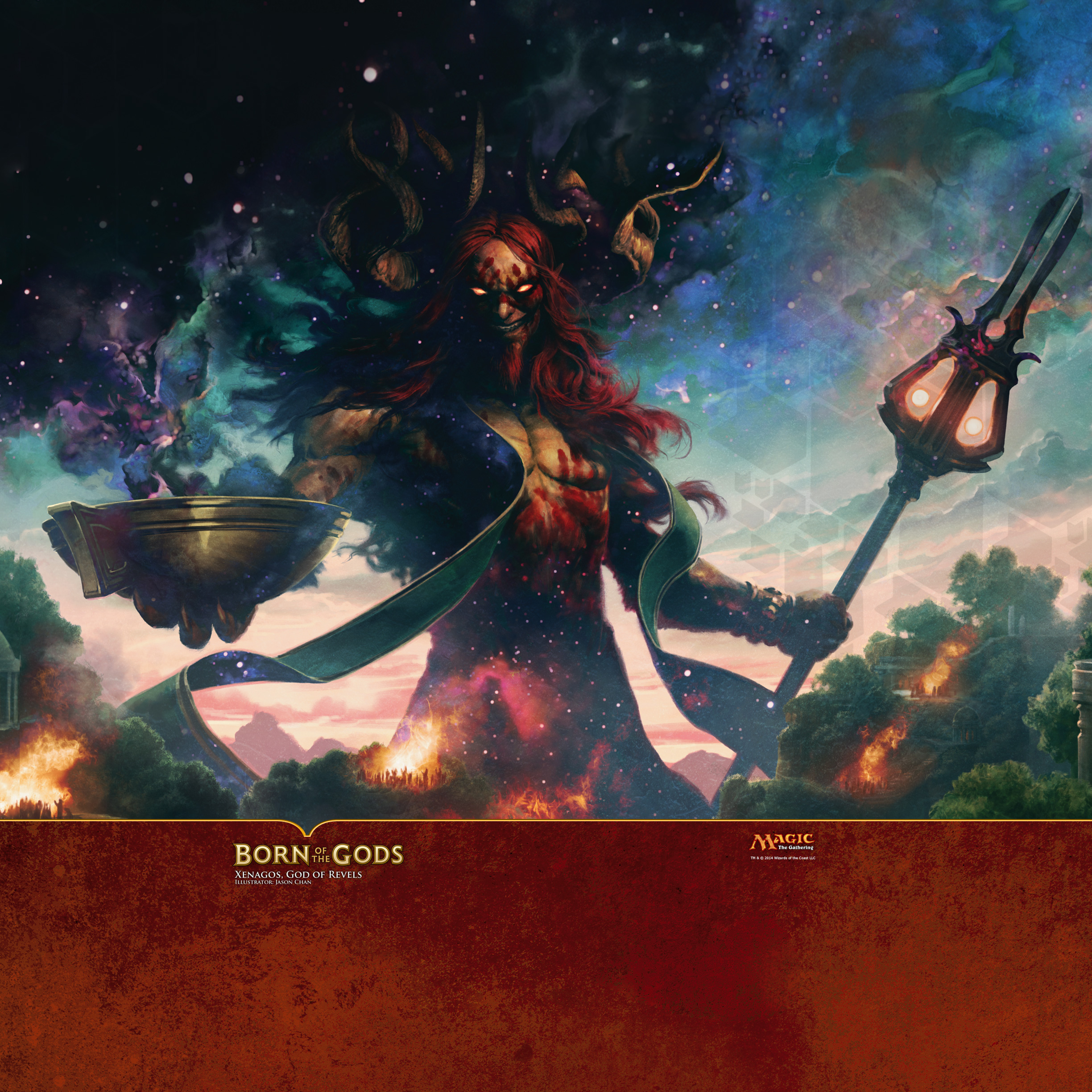


Sky Domain
The gods that govern the sky are held in high regard by many religions. Deities of the sky include Zeus and Tyr, among various others. Followers of these deities often travel far to sate their wanderlust and feel the beauty of the open sky
Sky Domain Features
| Cleric Level | Feature |
|---|---|
| 1st | Domain Spells, Forceful Gale, Tailwind |
| 2nd | Channel Divinity: Updraft |
| 6th | Channel Divinity: Protection of the Wind |
| 8th | Potent Spellcasting |
| 17th | Blessed Wings |
Sky Domain Spells
| Cleric Level | Spells |
|---|---|
| 1st | faerie fire, feather fall |
| 3rd | moonbeam, skywriteXGE |
| 5th | fly, wind wall |
| 7th | freedom of movement, storm sphereXGE |
| 9th | control windsXGE, maelstromXGE |
Forceful Gale
At 1st level, you gain the ability to manipulate the winds. You learn the gust cantrip, which doesn't count against the number of cleric cantrips you know. For you, it gains the following changes:
- One Large or smaller creature that you choose must succeed on a Strength saving throw or be flung up 20 feet directly away from you and knocked prone. If a thrown target strikes an object, such as a wall or floor, the target takes 1d6 bludgeoning damage for every 10 feet it was thrown. If the target is thrown at another creature, that creature must succeed on a Dexterity saving throw or take the same damage and be knocked prone.
- You create a blast of air capable of moving one object that weighs no more than 100 pounds. If the object is being held or carried, the holder must make a Strength saving throw or lose hold of it. The object is pushed up to 60 feet away from you.
Tailwind
Also at 1st level, the blessing of your god grants you unmatched grace and mobility. Your movement speed increases by 10 feet if you are not wearing medium or heavy armor.
Channel Divinity: Updraft
Starting at 2nd level, you can use your Channel Divinity to create a powerful blast of wind. As an action, you present your holy symbol and invoke the name of your deity. Choose a Large or smaller creature within 60 feet of you. The target must succeed on a Strength saving throw or be blown upwards up to 30 feet. A target can choose to automatically fail this saving throw. If the target doesn't have a hover or fly speed, it immediately falls afterwards, taking fall damage and landing prone.
Channel Divinity: Protection of Wind
At 6th level, the gusts and breezes protect you from harm. As a reaction when you are hit by a ranged weapon attack you can see, you can use your Channel Divinity to create a gust of wind around you, causing the attack to miss.
Potent Spellcasting
Starting at 8th level, you add your Wisdom modifier to the damage you deal with any cleric cantrip.
Blessed Wings
At 17th level, your god places upon you the blessing of true flight. You grow a pair of wings, which grant you a flying speed of 60 feet. If you already have a flying speed, it increases to 90 feet, unless it is already higher. You can't use these wings while wearing medium or heavy armor.



Winter Domain
The gods of winter are powerful forces of nature. Some of these deities, such as Auril and Thrym, use their power to spread icy death and famine across the land and freezing all life in their path. Yet others, like Ulutiu and Rellavar Danuvien, seek champions to protect the cycle of nature and to guide their followers through harsh winters and icy terrain.
Whether to bring destruction or guard the defenseless, clerics of this domain channel the power of the unyielding winter. Where many fear the bite of winter, they embrace the blessings of ice and cold to slow their enemies and protect their allies from harm.
Winter Domain Features
| Cleric Level | Feature |
|---|---|
| 1st | Domain Spells, Bonus Proficiency, Winter's Protection |
| 2nd | Channel Divinity: Ice Prison |
| 6th | Glacial Soul |
| 8th | Divine Strike |
| 17th | Wrath of Winter |
Winter Domain Spells
| Cleric Level | Spells |
|---|---|
| 1st | armor of agathys, frost fingers |
| 3rd | snilloc’s snowball swarm, warding bond |
| 5th | sleet storm, leomond's tiny hut |
| 7th | ice storm, death ward |
| 9th | circle of power, cone of cold |
Bonus Proficiency
When you choose this domain at 1st level, you gain proficiency with heavy armor.
Winter's Protection
Beginning at 1st level, when you cast the armor of agathys spell, it has a range of touch instead of self. Additionally, the temporary hit points granted by the spell increases by a number equal to your Wisdom modifier.
Channel Divinity: Ice Prison
Starting at 2nd level, you can use your Channel Divinity to encase a creature in ice. As an action, you brandish your holy symbol, and force a creature you can see within 30 feet of you to make a Strength saving throw. A willing creature can choose to fail their saving throws against this feature.
On a failed saving throw, the creature is encased in ice for 1 minute, or until you dispel it with an action. While encased in this way, the creature is immune to all damage, is incapacitated, and its speed becomes 0. At the end of each of its turn it can repeat the Strength saving throw, breaking free of the ice on a success.
Glacial Soul
At 6th level, the divine ice shines through you. You gain resistance to cold damage.
Additionally, whenever you deal cold damage to a creature, you can also reduce its movement speed by 10 feet until the start of your next turn.
Divine Strike
At 8th level, you gain the ability to infuse your weapon strikes with divine energy. Once on each of your turns when you hit a creature with a weapon attack, you can cause the attack to deal an extra 1d8 cold damage to the target. When you reach 14th level, the extra damage increases to 2d8.
Wrath of Winter
Upon reaching 17th level, you can momentarily summon a blinding blizzard that obscures you from others. As an action, you summon an icy aura that emanates from you in a 30-foot radius. You become heavily obscured to other creatures, and creatures of your choice within the aura have disadvantage on saving throws against spells that deal cold damage.
This aura of cold lasts for 1 minute, or until you are incapacitated or choose to end it as an action on your turn.



Druid
Circle of the Hybrid
Druids of the Circle of the Hybrid are natural innovators. They mark the thin line between humanoid and beast,
daring to combine the finest qualities of each and
striving to push that boundary as far as possible.
Circle of the Hybrid Features
| Druid Level | Feature |
|---|---|
| 2nd | Hybrid Shape |
| 6th | Forced Adaptation, Primal Strike |
| 10th | Lusus Nature |
| 14th | Master of Two Worlds |
Hybrid Shape
Beginning at 2nd level, you learn to measure the influence of the natural world on your body. When you use your Wild Shape, you can partially transform into a beast instead of magically assuming its shape.
While partially transformed, you gain the benefit of the beast's senses, speeds, and special traits, except for any flying speed the beast has. If the beast is larger than you, you grow to its size. Anything you are wearing or carrying grows with you. None of your other statistics change, and you retain the ability to speak, cast spells, and use any features from your class, race, or other source.
For the duration, you can use your action to take one of the actions in the beast's stat block. You are proficient with the beast's natural weapons. You can use your Wisdom, instead of the beast's attack modifier, for the attack and damage rolls of attacks you make with them, and can use your druid spell save DC instead of any of the beast's DCs. In addition, whenever you make an ability check or a saving throw, you can use the beast's statistics or your own (your choice).
Forced Adaptation
At 6th level, you gain the ability to force your body to adapt to new environments. When you finish a short or long rest, you can choose one type of terrain from the Forced Evolution table, adapting to that terrain until you choose a different one with this feature.
You have advantage on Wisdom (Survival) checks you make within the terrain you chose, and you're naturally adapted to the environment associated with it, as described in chapter 5 of the Dungeon Master's Guide.
Forced Evolution
| Terrain | Environment |
|---|---|
| Arctic | Extreme Cold |
| Coast | Frigid Water |
| Desert | Extreme Heat |
| Forest | — |
Forced Evolution
| Terrain | Environment |
|---|---|
| Grassland | — |
| Mountain | High Altitude |
| Swamp | — |
| Underdark | — |
Primal Strike
Starting at 6th level, your attacks with a beast's natural weapons count as magical for the purpose of overcoming resistance and immunity to nonmagical attacks and damage.
Lusus Naturae
Starting at 10th level, you can expend two uses of your Wild Shape at the same time to partially transform into two beasts using your Hybrid Shape.
You gain the benefit of both beast's senses, speeds, and special traits. If both beasts have the same type of speed, use whichever is higher. If both beasts have flying speed, you also gain the faster of the two flying speeds. If either beast is larger than you, you become the size of the largest beast. You can take the actions in either beast's stat block, and you can make ability checks and saving throws using either beast's statistics.
Master of Two Worlds
Beginning at 14th level, you master the balance between humanoid and beast. When you use your action to cast a druid spell while partially transformed by your Hybrid Shape, you can use your bonus action to take one of the actions in the beast's stat block.


Circle of Souls
Druids of the Circle of the Souls, also known as shamans, are mystics who summon forth the spirits of dead mortals to converse with the living. These shamans serve as a link between the living and the dead, and unlike other mystics, commune with forces that are not strictly benevolent.
These druids will gather at sacred sites, often in caves or high on mountain slopes where the walls between the planes wear thin to maintain their traditional ceremonies and channel the power of their elders. Their rituals call on the spirits of ages past to inhabit their bodies, allowing heroes and villains alike thought long dead to exert their influence anew in the waking world. By invoking their magic to part the ethereal veil, these druids draw power from ancient kings, regretful commoners, or even mystical monstrosities.
Circle of Souls Features
| Druid Level | Feature |
|---|---|
| 2nd | Soul Shape |
| 6th | Chimeric Soul |
| 10th | Spiritual Conduit |
| 14th | Spiritual Wings |
Circle Spells
At 2nd level, you learn the primal savagery cantrip, and at 3rd 5th, 7th, and 9th level you gain access to spells listed in the following table, which counts as druid spells for you. Once you gain to a certain spell, you always have it prepared and it doesn't count the number of you can prepare each day.
| Druid Level | Circle Spells |
|---|---|
| 3rd | mirror image, shadow blade |
| 5th | speak with dead, spirit guardians |
| 7th | guardian of faith, shadow of moil |
| 9th | contact other plane, steel wind strike |
Soul Shape
When you choose this circle at 2nd level, you gain an alternate use for Wild Shape. As a bonus action, you can expend a use of Wild Shape to harness the will and strength of the spirits to provide you with guidance.
While your body remains unchanged, the magical essence fills you, granting potent abilities for 10 minutes. When you use Soul Shape, chose one of the following Aspects:
- Aspect of the Warrior: You gain supernatural strength and your magic impacts with staggering force. Your Strength ability score becomes equal to your Wisdom ability score (if it was lower), and you can add your Strength modifier to the damage of your melee spell attacks. You gain proficiency in Strength saving throws while manifesting this aspect.
- Aspect of the Trickster: You gain a supernatural agility and cunning weaving your magic and attacks together. When you make a melee spell attack or cast a spell as part of your action, you can make one melee weapon attack as a bonus action. You gain proficiency in Dexterity saving throws while in this manifesting this aspect.
- Aspect of the Pilgrim: You gain supernatural endurance and perseverance. At the start of each of your turns, you gain temporary hit points equal to your Wisdom modifier. You gain proficiency in Constitution saving throws while manifesting this aspect.
Chimeric Soul
Starting at 6th level, you have developed a rapport with denizens of various planes, allowing you to more easily call on them for aid. When you use your Soul shape, you can assume two Aspects at the same time.
Spiritual Conduit
Starting at 10th level, your frequent contacts with the spirit world have gifted you with uncommon fortitude, causing the power of the spirits to rejuvenate you. Whenever you cast a spell while Soul Shaped, you recover hit points equal to twice the spell level of the spell cast.
Spiritual Wings
Starting at 14th level, you can weave wings of the heavenly realms that keep you aloft. When you use your Soul Shape, you can assume three different aspects at the same time and you gain a flying speed of 30 feet.


Circle of the Sun
Druids revere aspects aspects of nature, and none is more central the cycle of life than the sun, origin of light and life. Druids of this circle are not clerics of the god of the sun, but represent it's aspect in the cycle of life, the light and heat and it brings, the fiery radiance with which it reigns over the world. They draw directly from the Elemental Plane of Fire and from the upper planes.
Druids of the Circle often stand in opposition that with crawls through the dark, that which corrupts in the absence of light, and while still inclined to the neutrality many Druids uphold, they tend to swing further the extremes of passion and action. They aren't afraid to leave the wilderness they call home and go on vast journeys to achieve their goals.
Circle of the Sun Features
| Druid Level | Feature |
|---|---|
| 2nd | Circle Spells, Unleash Radiance |
| 6th | Burning Light |
| 10th | Cleansing Fire |
| 14th | Emissary of the Sun |
Circle Spells
At 2nd level, you learn the light and create bonfire cantrips. At 3rd, 5th, 7th, and 9th level you gain access to the spells listed for that level in the Circle of the Sun Spells table. Once you gain access to a circle spell, you always have it prepared, and it doesn't count against the number of spells you can prepare each day.
| Druid Level | Circle Spells |
|---|---|
| 3rd | flame blade, flaming sphere |
| 5th | daylight, fireball |
| 7th | fire shield, wall of fire |
| 9th | dawn, flame strike |
Unleash Radiance
When you choose this circle at 2nd level, you gain an alternate use for Wild Shape. You absorb sunlight and as a bonus action, you can unleash the radiance within. When you transform with this ability, creatures within 15 feet of you must make a Constitution saving throw or be blinded until the start of your next turn. You gain the following effects for 1 minute:
- You shed bright light in a radius of 15 feet, and dim light for another 15 feet. The bright light is sunlight.
- You gain resistance to fire and radiant damage.
- Once per turn, when you deal fire or radiant damage on your turn, you can deal an addition 1d4 fire or radiant damage to that enemy.
As an action while you are transformed, you can end the effect early, releasing your energy in a beam of light a 60 feet long and 5 wide. Each creature in the line must make a Dexterity saving throw, or take 1d12 radiant damage. You can enhance this damage further by expending a 1st level spell slot (to 2d12), and by an additional 1d12 per level of spell slot spent up to 6d12 for a 5th level spell slot.
Burning Light
Starting at 6th level, once per turn on your turn, when you roll fire or radiant damage against a creature that is in bright light, you can add your Wisdom modifier to one roll of that damage. Additionally some of your fire spells are enhanced in the following ways:
- When make a spell attack with flame blade, you can make a second spell attack as part of the same action.
- You can concentrate on multiple create bonfire spells at the same time, up to your Wisdom modifier spells.
Cleansing Light
Beginning at 10th level, you can cast remove curse or lesser restoration without expending a spell slot. You can do this a number of times equal to your Wisdom modifier, regaining all uses when you complete a long rest.
Emissary of the Sun
Starting at 14th level, when you use Unleash Radiance, you can expend two uses of wildshape to partially become fire itself. You are under the effect of investiture of flame in addition to the rest of the effects.
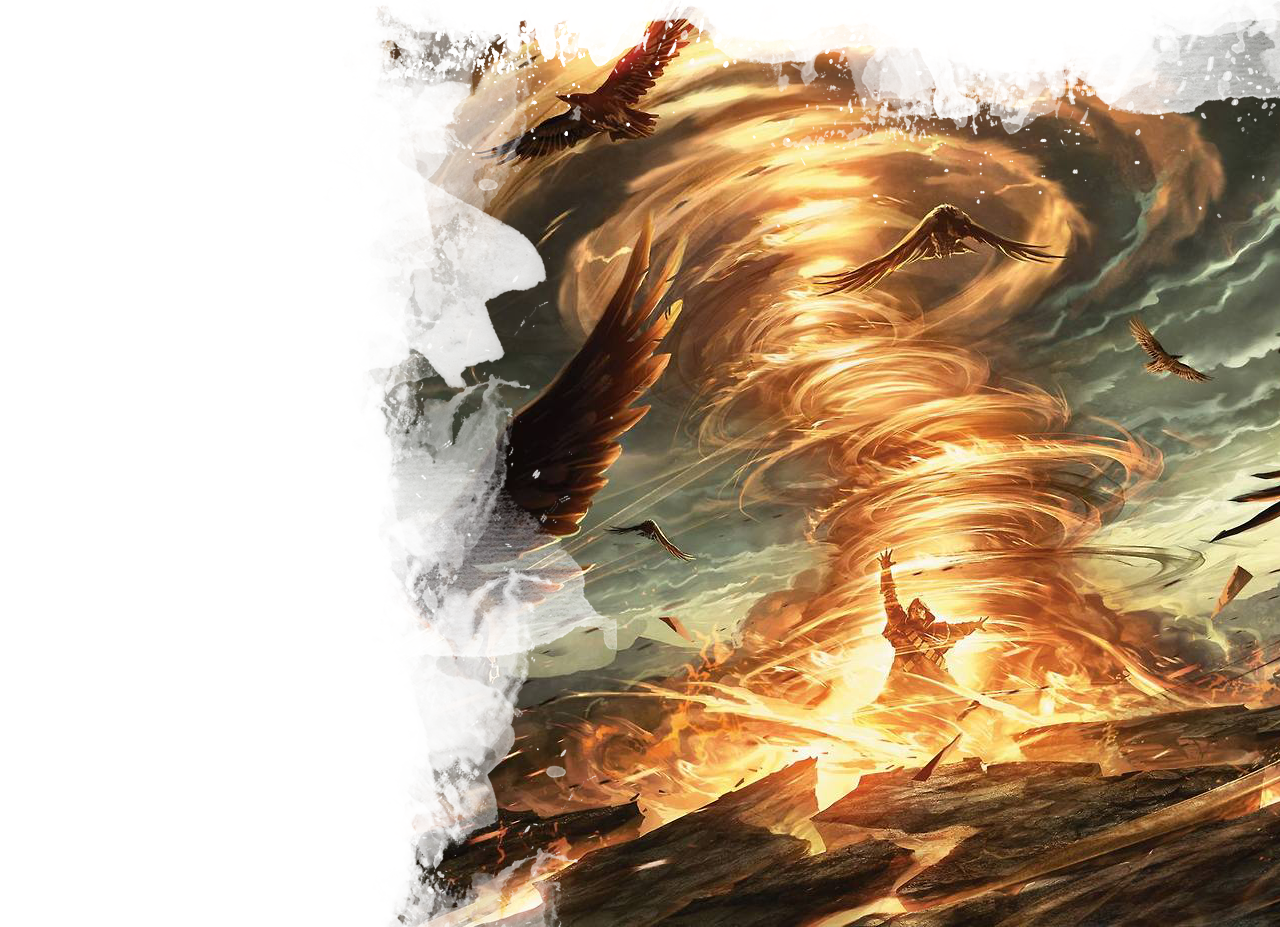
Circle of the Thickets
While many druids have a kinshape with the deep woods of nature, a Circle of the Thickets Druid has a connection that goes much deeper. Legends say that the first of these druids were trees who took human form, rather than humans that took tree form, but such things are lost to legend.
Frequently, regardless of the nature of their connection, these druids will feel most comfortable deep in nature, and place great value in its unspoiled form, sharing a world view more in common with dyrads and treants than other mortals.
Circle of the Thickets Features
| Druid Level | Feature |
|---|---|
| 2nd | Tree Form |
| 6th | Extra Attack |
| 10th | Ancient Fortitude |
| 14th | Guardian's Grasp |
Circle Spells
At 2nd level, you learn the shillelagh cantrip. At 3rd, 5th, 7th, and 9th level you gain access to the spells listed for that level in the Circle of the Wood Spells table. Once you gain access to a circle spell, you always have it prepared, and it doesn't count against the number of spells you can prepare each day.
| Druid Level | Circle Spells |
|---|---|
| 3rd | barkskin, locate animal or plants |
| 5th | erupting earth, plant growth |
| 7th | grasping vine, guardian of nature |
| 9th | tree stride, wrath of nature |
Tree Form
When you choose this circle at 2nd level, you gain an alternate use for Wild Shape. As a bonus action, you assume a treelike form, covered in leaves and bark, which lasts up to one hour, or until you end it as a bonus action or until you are incapacitated.
You gain the following properties when you transform:
- You can make yourself Large and gain reach of 10 feet.
- You gain a natural weapon that is a club under the effect of shillelagh. While in this form, you can cast shillelagh on any weapon you are carrying.
- You can make a Wisdom (Athletics) check to initiate, maintain, or contest a grapple, and have a number of grappling appendages equal to your Wisdom modifier.
- Your AC is 10 + your Constitution modifier + your Wisdom modifier. You cannot benefit from the AC of armor or shields while in this form.
- You gain temporary hit points equal to your Wisdom modifier + twice your Druid level when you transform into tree form. When the form ends, you lose any temporary hit points you have from it.
- Any speed you have becomes 15 feet, unless the speed was lower. If you don't move during your turn, you have advantage on Ability Checks and Saving Throws against effects that would move you or knock you prone.
You choose whether your equipment falls to the ground in your space, merges into your new form, or is worn by it. The GM decides whether it is practical for the new form to wear a piece of equipment. Any equipment that the new form can't wear must either fall to the ground or merge with it. Equipment that merges with the form has no effect until you leave the form.
Extra Attack
Starting at 6th level, you can attack twice, instead of once, whenever you take the Attack action on your turn.
Ancient Fortitude
Beginning at 10th level, you gain the endurance of the of the ancient forests. While in Tree Form, if you have no temporary hit points at the start of your turn, you gain temporary hit points equal to your Wisdom modifier.
Additionally, if you have any temporary hit points when you take damage that forces you to make a Constitution saving throw to maintain Concentration on a spell, you can make the check with advantage.
Guardian's Grasp
Starting at 14th level, any creature grappled or restrained by you (by a grapple or a spell such as entangle) takes 2d6 bludgeoning damage at the start of their turn as your grasp crushes it.
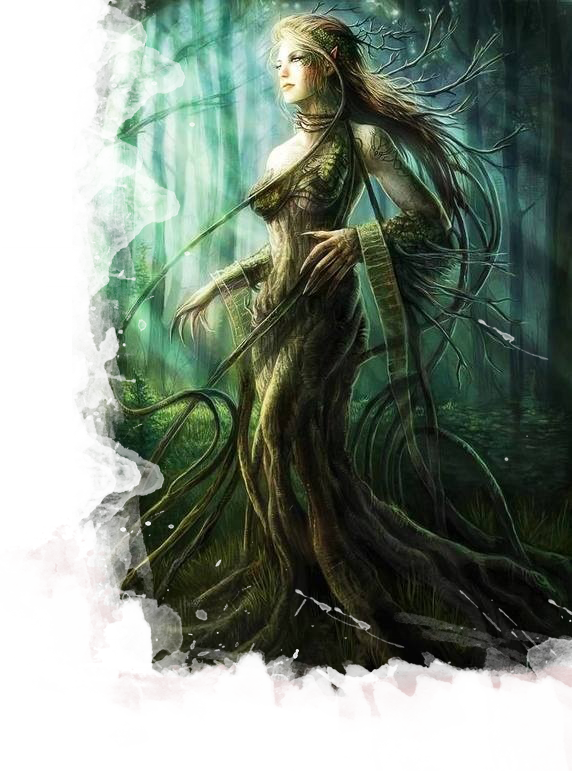
Fighter
Brawler Archetype
Brawler are warriors without creed or code, the sellswords and the savages. No knightly apprenticeship or combat academy taught them battle, for they rise from the humblest origins and earn prestige though luck, wit and strength of arms. A brawler seizes the advantage at the moment it presents itself, knowing that to falter or gloat before the enemy is finished is to risk death oneself.
Brawler Archetype Features
| Fighter Level | Feature |
|---|---|
| 3rd | Combat Pragmatics, Street Smarts |
| 7th | Not Today |
| 10th | Cut Your Losses |
| 15th | Cheap Shot Artist |
| 18th | Murder Brigade |
Combat Pragmatics
Beginning at 3rd level when you choose this archetype, you master a few tricks, techniques and quirks of fighting that work for you, if not for anyone else.
- Dirty Trick. When you take the Attack action, you can replace one of your weapon attacks with an underhanded maneuver. Make a Dexterity (Sleight of Hand) or Charisma (Deception) check against the Passive Wisdom (Perception) of a creature within 5 feet of you. If you win this check, the creature's next attack roll has disadvantage and it cannot take reactions until the end of its next turn.
- Brutish Brawling. You are particularly deadly in the chaos of close quarters. When you are grappling a creature, your attacks against it have advantage.
- Counter Attack. You bait your enemies into wild swings, always ready for the opportune moment. When a creature has disadvantage on its attack roll and misses you with an attack, you can use your reaction to make a melee weapon attack against it.
Street Smarts
Also at 3rd level, your mean upbringing grants you proficiency in either Sleight of Hand or Deception.
Not Today
At 7th level, you protect yourself in unconventional ways. You can use one of the following options as a reaction when you would be hit by an attack, but before the damage is rolled:
- Meat Shield. If you are grappling a creature other than your attacker and it is size medium or smaller, you can move 5 feet into an unoccupied space without provoking opportunity attacks and pull the grappled creature into your vacated space. The creature becomes the target of the triggering attack instead of you.
- Brace the Blow. You know the strengths of your armor, redirecting strikes to where they do little harm. You reduce the attack's damage by the amount your AC exceeds 10, to a minimum of zero.
You can use these abilities a number of times, combined, equal to your Constitution modifier (minimum once) and regain all uses when you finish a long rest.
Cut Your Losses
Beginning at 10th level, you are adept at catching your breath and repositioning even in the heat of combat. When you use your Second Wind or Action Surge feature, you also gain the benefit of a Disengage action.
Cheap Shot Artist
At 15th level, when you hit with an attack that was made at advantage, add 1d6 to your damage roll.
Murder Brigade
Beginning at 18th level, when a creature you can see is hit by a critical hit, you can use your reaction to move up to your speed without provoking opportunity attacks and make one attack against that creature.
If this attack reduces the creature to 0 hit points, you gain temporary hit points equal to your fighter level.


Fencer Archetype
Fencers are highly skilled duelists and swordmasters with a flair for style and panache. For a Fencer, fighting is an art form. Renown comes from fame, and it is a desire for that recognition that drives them to be inventive and resourceful on the battlefield. Though they deal in combat, a true Fencer is a performer at heart. The battlefield is their stage and their enemy is an audience to be beguiled. Some Fencers are rumored to be unsavory scoundrels, while others are featured in songs and chronicles as heroes.
Fencer Archetype Features
| Fighter Level | Feature |
|---|---|
| 3rd | Bonus Proficiency, Flourishes, Unarmored Defense |
| 7th | Dramatic Finale |
| 10th | Fast Movement, Expertise |
| 15th | Precise Parry |
| 18th | Audacious |
Bonus Proficiency
When you choose this archetype at 3rd level, you gain proficiency in either the Acrobatics or the Performance skill. If you are already proficient in both skills, you instead gain proficiency with one of the following tools: calligrapher's supplies, painter's supplies, disguise kit, or any musical instrument.
Flourishes
At 3rd level, you learn to use a variety of techniques to dance upon the battlefield. You gain the benefits of these flourishes as long as you are not wearing armor and not wielding a shield.
You learn two flourishes of your choice, which are detailed under "Flourishes" below. You learn one additional flourish of your choice at 7th, 10th, and 15th level. Each time you gain a level in this class, you can also replace one flourish you know with a different one.
Unfettered Defense
You can avoid incoming attacks with speed and cunning. Beginning at 3rd level, while you are wearing no armor and not wielding a shield, your AC equals 11 + your Dexterity modifier + your Charisma modifier.
Dramatic Finale
Starting at 7th level, you can end your turn with a dazzling display. You can make an additional attack using any weapon you are holding (no action required). This attack uses your Charisma modifier, instead of Strength or Dexterity, for the attack and damage rolls. After you make this attack, your turn immediately ends.
You can use this feature a number of times equal to your Charisma modifier (minimum of once) and you regain all expended uses of it when you finish a long rest.
Expertise
At 10th level, choose either Acrobatics or Performance. Alternatively, choose one of the tools specified in the Bonus Proficiency feature. Your proficiency bonus is doubled for any ability check you make that uses the chosen proficiency.
Fast Movement
Starting at 10th level, your movement speed increases by 10 feet while you aren't wearing armor.
Precise Parry
Starting at 15th level, when a creature makes an attack against you, you can briefly distract them. Before the attack roll is made, you can use your reaction to impose disadvantage on the attack roll. If the attack still hits, you can reduce the damage by an amount equal to twice your Charisma modifier.
You can use this feature a number of times equal to your Charisma modifier (minimum of once) and you regain all expended uses of it when you finish a long rest.
Audacious
At 18th level, even when you miss your mark, you can quickly shift into a new position and try again.
Once on each of your turns when you miss a creature with a weapon attack, you can immediately move up to 10 feet without provoking opportunity attacks from the creature and choose to make another weapon attack against a different creature as part of the same action.

Flourishes
The flourishes are presented in alphabetical order.
Artful Avoidance. When you use your Second Wind, you can immediately move up to half your speed without provoking opportunity attacks.
Circle Step. When you take the Attack action and hit a creature with a melee weapon attack, you can immediately move up to 5 feet, as long as the creature remains within your reach. You can make this movement for each attack you make using the Attack action.
Crafty Escape. You can use a bonus action to attempt to escape a grapple where it would normally require an action.
Dance of Blades. When you take the Attack action and you have the Extra Attack feature, you can forgo one of your attacks to move up to 10 feet. This can be done for multiple attacks, but not all of them.
Expert Throw. Once on each of your turns, when you make a ranged weapon attack using a weapon with the thrown property, you can immediately move up to 10 feet in a straight line toward or away from the target of the attack. In addition, your range with such weapons is increased by 20 feet.
Flowing Performance. When you use your Action Surge, you can take one additional bonus action.
Fluid Motion. When you are prone, standing up uses only 5 feet of your movement. In addition, mounting or dismounting a creature costs you only 5 feet of movement.
Flying Pirouette. Your jump distance is doubled. In addition, you have resistance to damage from falling and you do not land prone after falling.
Heroic Charge. You can give yourself a bonus to initiative rolls equal to your proficiency bonus. At the start of your first turn of each combat, your walking speed increases by 5 feet, which lasts until the end of that turn.
Interposing Strike. When a creature provokes an opportunity attack from you, you can immediately move up to 10 feet before making the attack, as long as the creature remains within your reach.
Masterful Bladework. You can use Dexterity instead of Strength for the attack and damage rolls of the following weapons when you wield them: glaive, handaxe, javelin, longsword, pike, quarterstaff, and spear.
Perfect Balance. You ignore nonmagical difficult terrain.
Quick Defense. When a creature misses you with an attack, you can immediately use your reaction to move up to 10 feet without provoking opportunity attacks.
Sustained Momentum. You can use a bonus action on your turn to move up to 10 feet.
Leaping Strike. When you use your Action Surge, and you are wielding a melee weapon with both hands, you can increase your reach with that weapon by 5 feet until the end of your next turn.
Thousand Cuts. When you make an opportunity attack and you are using Two-Weapon Fighting, you can make one additional attack with the weapon in the other hand, as per the rules of Two-Weapon Fighting.
Uncanny Accuracy. Being within 5 feet of a hostile creature doesn’t impose disadvantage on your ranged weapon attack rolls.
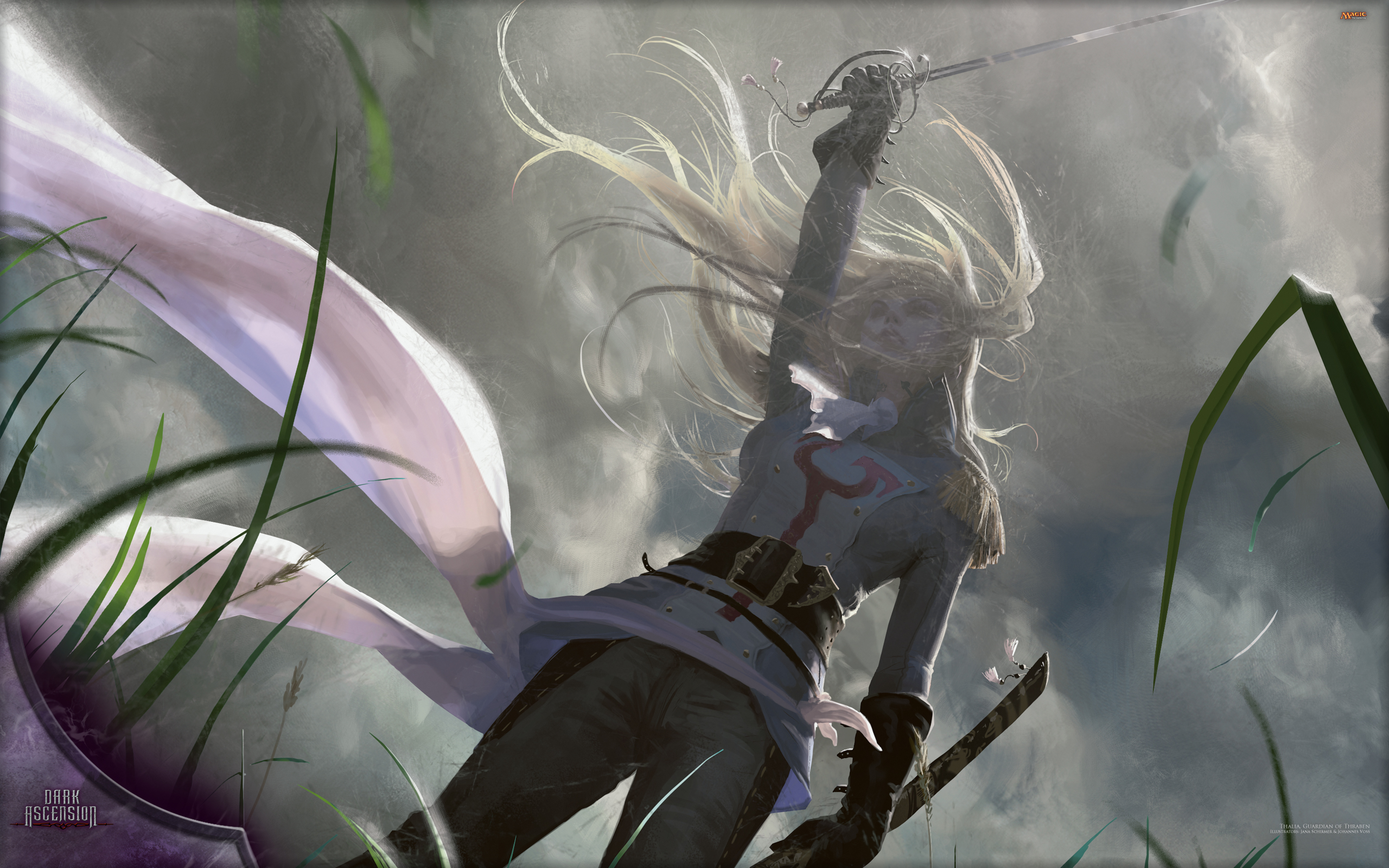
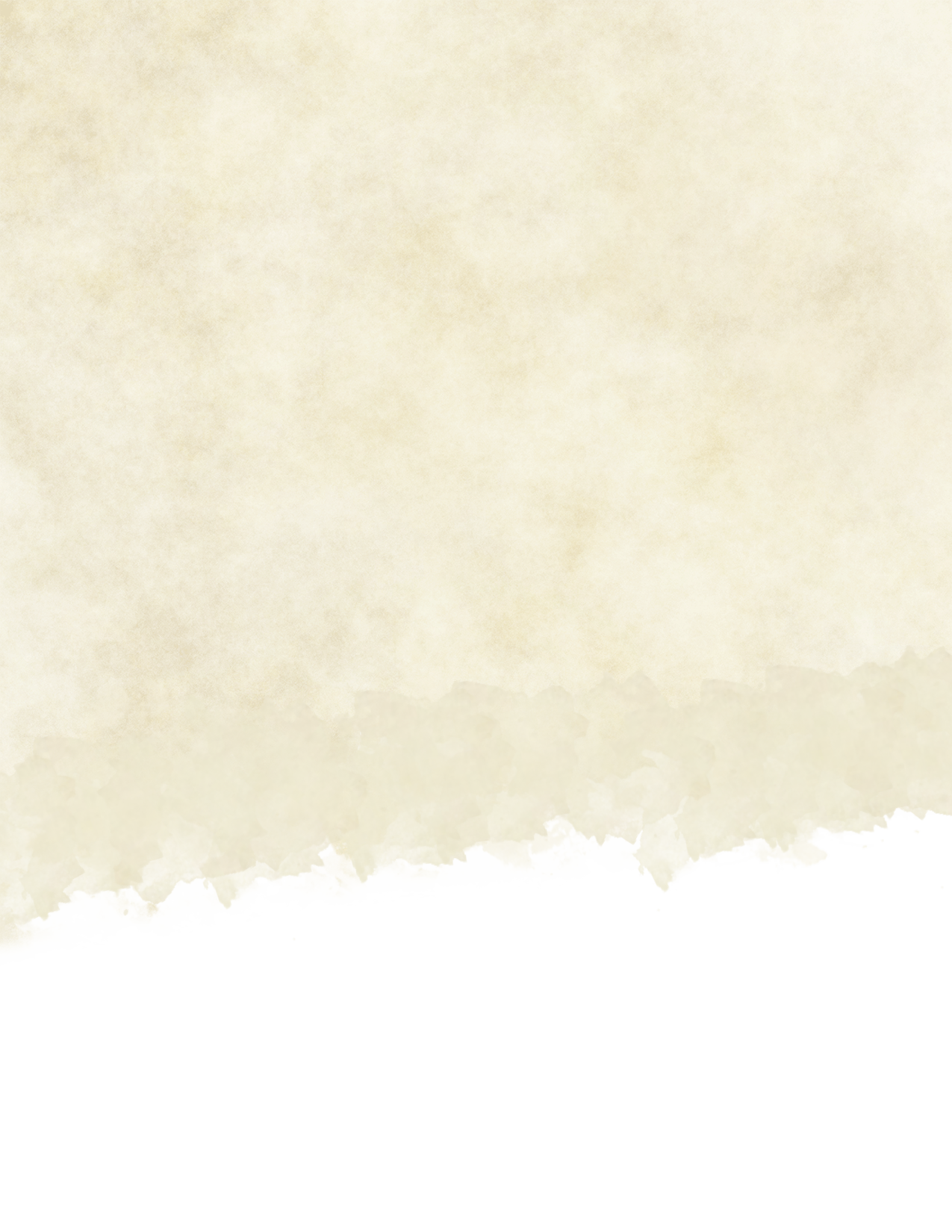
Juggernaut Archetype
Juggernauts are simple warriors who rely on their own durability to overcome their enemies. Some juggernauts combine this physical might with tactical cunning. Others just hit things until those things stop hitting back.
Juggernaut Archetype Features
| Fighter Level | Feature |
|---|---|
| 3rd | Brutish Weapons, Push Forward |
| 7th | Unyielding Mind |
| 10th | Shrug It Off |
| 15th | Death Dealer |
| 18th | Hero of Legend |
Brutish Weapons
At 3rd level, any melee weapon you wield gains the Reach property if it does not already have it. Additionally, you can ignore the Heavy property of weapons.
Push Forward
Also at 3rd level, you are able to push yourself on pure adrenaline when you are badly injured. If your current hit points are less than half of your maximum hit points, your base movement speed increases by 5 feet and, once per turn, when you roll damage for a weapon attack, you can add your proficiency bonus to the roll.
Unyielding Mind
By the time you reach 7th level, your mind is as hardened as your body. Your thoughts cannot be read by any means, including magic or telepathy, unless you allow it.
Shrug It Off
At 10th level, you can function through conditions that cripple lesser beings. You ignore the effect of exhaustion up to level 5, suffering no ill effects until that point.
Death Dealer
By 15th level, you can deal devastating blows to your enemies while they are most vulnerable. When you use your Action Surge, you can choose to use this feature and gain two additional actions instead of one. Once you have used this feature, you must finish a long rest before you can do so again.
Hero of Legend
When you reach 18th level, you have become a true legend like the heroes told of in stories. Chose any one ability score. You gain a +2 to that ability score and your maximum for that score is now 22.


Templar Archetype
An archetypical Knight Templar bears a distinct resemblance to paladins and clerics, particularly in the way they present themselves. While they lack the divine magic offered by these classes, their divine fervor and unshakeable devotion to their gods are far from lacking.
A Templar fights for their deity, commonly acting as crusaders or, less commonly, inquisitors of the faith. These fighters come from all walks of life, united by their zealotry and unbreakable faith. In their training, they become capable combatants, devoted friends, and learned scholars of their faith. A Templar’s way of life is arduous—they are always fighting for something, whether for their god, their companions, or a moral cause.
Templar Archetype Features
| Fighter Level | Feature |
|---|---|
| 3rd | Bonus Proficiency, Zealot's Devotion |
| 7th | Scholar of Evil and Good |
| 10th | Surge of Faith |
| 15th | Endless Fervor |
| 18th | Deus Ex Machina |
Bonus Proficiency
At 3rd level, you gain proficiency in the Religion skill. If you already have this proficiency, you instead gain proficiency in another skill of your choice.
Zealot’s Devotion
Also at 3rd level, you can devote yourself to a cause. This uses your zealotry die, which starts as a d6 and increases in size as you level. It becomes a d8 at 7th level, d10 at 10th level, and a d12 at 15th level. Starting at 18th level, you roll your zealotry die twice and take the higher of the two rolls.
As a bonus action, you can devote yourself towards either defender of kin or slayer of foes. Both choices use your zealotry die as part of their effects, and your choice lasts until you choose a different one or are incapacitated.
Defender of Kin. You devote yourself towards defending your allies. While this feature lasts, you can use your bonus action to rally a creature other than you that is within 5 feet of you. You roll your zealotry die, and the targeted creature gains temporary hit points equal to the number rolled. These temporary hit points last until the start of your next turn.
Slayer of Foes. You devote yourself towards slaying your enemies. If you hit a creature with an attack while this feature lasts, you can use your bonus action to empower that attack. You roll your zealotry die, and add it to the attack’s damage roll.
Scholar of Evil and Good
By 7th level, you have learned much about the creatures of evil and good—aberrations, celestials, elementals, fey, fiends, and undead—granting you advantage on any Charisma checks you make while interacting with them, and allowing you to add your proficiency bonus to any Wisdom, Charisma, or Intelligence save imposed by one of these creatures if you don't add your proficiency to that save already.
Surge of Faith
Starting at 10th level, using your Action Surge also allows you to take an additional bonus action on your turn, and increases your speed by 15 feet until the end of turn.
Endless Fervor
Beginning at 15th level, your Zealot's Devotion feature is improved. You gain a +1 bonus to your AC while defender of kin is active, and a +1 bonus to your weapon attack rolls while slayer of foes is active.
Deus Ex Machina
By 18th level, the gods have noticed your ceaseless devotion, and have taken interest in your fate. You have advantage on death saving throws. You may cast the augury spell at will, without requiring any material components.
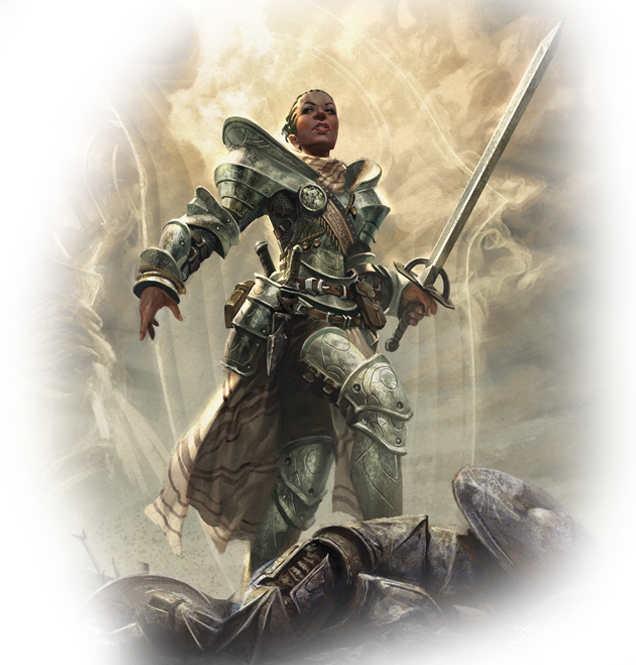




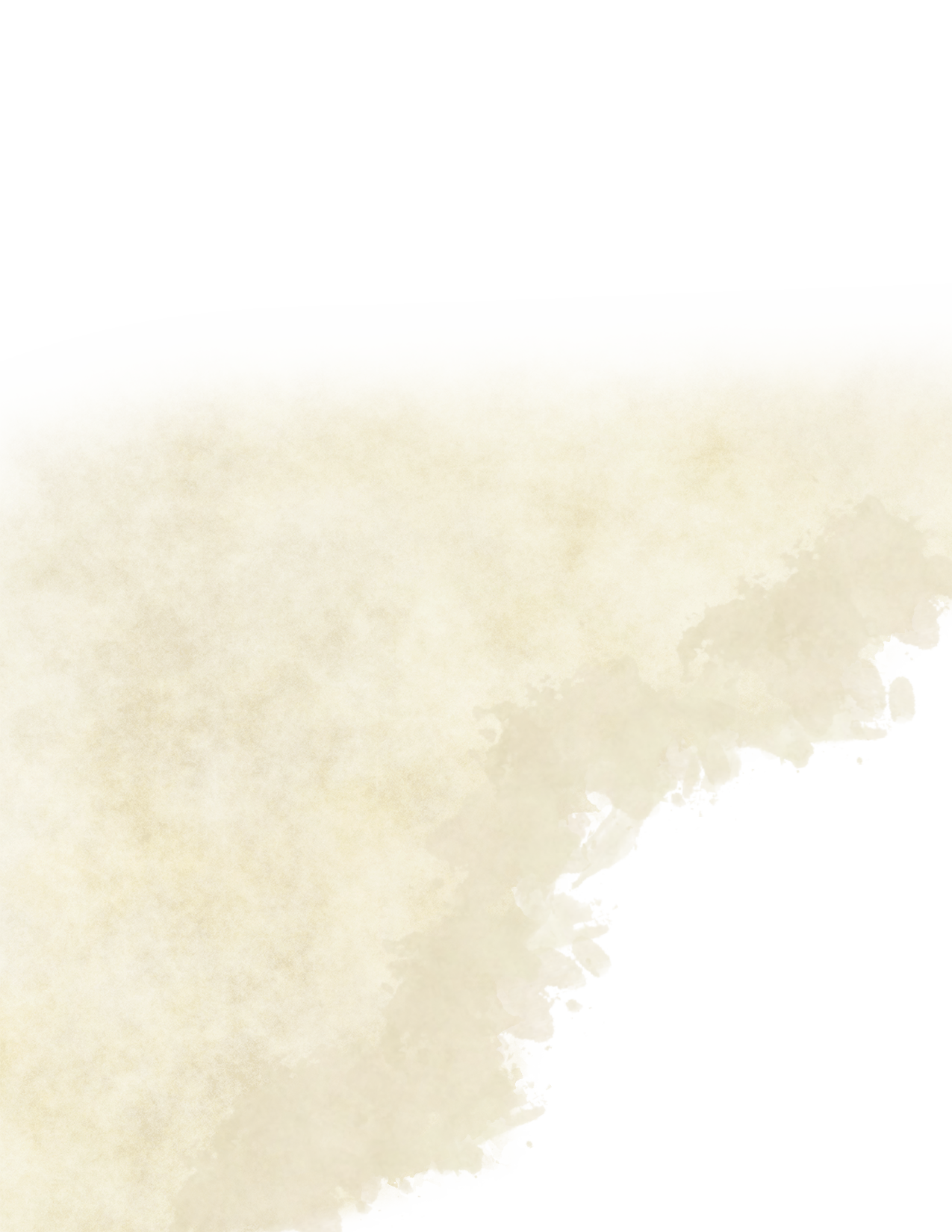

Monk
Way of the Force
Monks of the Way of the Force harness the very power of gravity. They have meditated on this natural force to be able to tap their ki into it and alter gravitation around them. They often see gravity not only as a force of nature, but as an extension of their arts.
Way of the Force Features
| Monk Level | Feature |
|---|---|
| 3rd | Gravitational Punches, Light as a Feather |
| 6th | Fluctuate |
| 11th | Low Gravity |
| 17th | Plummet |
Gravitational Punches
Starting when you choose this tradition at 3rd level, your blows are so heavy that they reform gravity around them. You gain the following benefits to your Flurry of Blows.
- Whenever hit two different creatures with the unarmed strikes granted by your Flurry of Blows, you can create a gravitational pull between the two creatures. Until the end of your next turn, the creatures can't willingly move while more than 20 feet away from each other.
- Whenever you hit the same creature with both of the unarmed strikes granted by your Flurry of Blows, you can create a vortex of high gravity within it, halving its speed until the end of your next turn.
Light as a Feather
Also at 3rd level, you gain the ability to reduce your own gravity. When you're prone, you can stand up by spending 5 feet of movement, rather than half your speed.
Fluctuate
At 6th level you gain the following abilities:
Catch. You can spend 1 ki point to cast feather fall without providing material components.
Heavy Stance. As a reaction to being forcibly moved, you can increase your gravity and not be moved instead.
Low Gravity
Beginning at 11th level, when you use your Step of the Wind feature, you gain a flying speed equal to your walking speed until the end of your turn.
In addition, when you affect a creature with your Gravitational Punches feature, it takes force damage equal to your Martial Arts die.
Plummet
Beginning at 17th level, once per turn, when you hit a creature with an unarmed strike, you can spend 3 ki points to attempt to change the creature's gravitational pull. If the creature is somehow anchored to the ground or other surface, this ability has no effect on it.
Otherwise, the creature's gravity is changed and it begins to fall in any direction of your choice. The creature must make a Strength saving throw against your Ki save DC. On a failed save, the creature falls up to 60 feet in the chosen direction. On a successful save, it falls up to 30 feet in the chosen direction. In either case, if a solid object is encountered in this fall, the creature strikes it just as it would during a normal downward fall. The creature's gravity returns to normal after the fall or after it collides with anything.


Way of the Iron Fist
One of the oldest monastic traditions, monks of the Way of the Iron Fist focus on the deep and unyielding truths that the ages have carved into stone.
Monks of the Way of the Iron Fist are taught the techniques of the unyielding mountain, harnessing it's resilience. They often train in unrelenting conditions to push their bodies beyond their normal limits. This training allows them to use their ki as a raw weapon in their punches and parries. In battle, these monks launch waves of ki energy at their foes while simultaneously bolstering their own defenses.
Way of the Iron Fist Features
| Monk Level | Feature |
|---|---|
| 3rd | Mountainous Resilience, Fist of Iron |
| 6th | Furious Strikes |
| 11th | Ki Wave |
| 17th | Perfect Fists |
Mountainous Resilience
Starting at 3rd level, you become resistant to the harsh conditions of the mountain. You are naturally adapted to cold climates and high altitudes as described in Chapter 5 of the Dungeon Master's Guide.
Fist of Iron
Also at 3rd level, you may expend 1 ki point as a bonus action to surround your fists with a glowing aura of raw energy that sheds bright light in a 5-foot radius and dim light for an additional 5 feet. This energy lasts until you dismiss it as a bonus action, use this feature again, unleash the energy as described below, or until 1 minute has passed.
While you have the aura, your unarmed attacks are considered magical and you can choose to deal force damage with them instead of their normal damage.
When you hit a creature with an unarmed strike you can choose to unleash the energy. If you do so, the creature must succeed on a Strength saving throw with DC equal to 8 + your proficiency modifier + your Wisdom modifier. On a failed save, the target takes 1d10 force damage and you may shove it up to 5 feet away from you. After this attack the energy dissipates and your Fist of Iron effects end.
You can spend 1 Ki Point to add any of the following modifiers to this unleashed attack. The points must be spent when unleashing the energy, before the Strength saving throw is made.
The number of Ki you may spend to modify the unleashed attack increase as you gain levels in this class. You may spend up to 2 ki points at level 5, 3 ki points at level 9, 4 ki points at level 14, and 5 ki points at level 17.
Hammering (1+ ki points)
The target takes an additional 1d10 force damage for each point spent.
Crushing (1 ki point)
The target is also knocked prone.
Hurling (1-3 ki points)
The target is pushed an additional 10 feet for each ki point spent.
Sweeping (2 ki points)
You target all creatures in a 5 foot radius of the original target with your unleashed attack.
Furious Strikes
Starting at 6th level, when you hit and damage a creature with both of your attacks granted by Flurry of Blows, it must make a Constitution saving throw or stagger under the heavy blows. Creatures that are immune to being stunned automatically succeed on this saving throw. A staggering creature's speed is halved, it can't take reactions, and has disadvantage on Dexterity saving throws until the end of your next turn.
Ki Wave
Starting at 11th level, you can punch the ground as an action and release a burst of energy that ripples outwards from you. Each creature on the ground in a 25-foot cube originating from you must make a Dexterity saving throw. On a failed saving throw, a creature takes 2d6 force damage and is knocked prone. Additionally, the ground in the area becomes difficult terrain to all other creatures except you until the start of your next turn.
You can increase the damage of this feature by spending up to 3 ki points as part of the action, increasing the force damage dealt by 2d6 per ki point spent. When you spend ki points in this way, the burst of ki energizes you and you gain temporary hit points equal to your Wisdom modifier plus an extra 1d4 per ki point spent.
Perfect Fists
Starting at 17th level, when you use your Fist of Iron feature you may spend 2 extra ki points. If you do, your fists are enveloped in a powerful, crackling energy for 10 minutes that sheds bright light in a 20-foot radius and dim light for an additional 20 feet.
While this feature is active, you gain all the benefits of your Fist of Iron as well as the following additional effects:
- At the start of your turn, if you have at least 1 hit point remaining, you may choose to gain temporary hit points equal to your Wisdom modifier.
- Your unleashed attack automatically gains the Sweeping modifier, you can apply other modifiers to it as normal.
- Reactions that parry or block to add Armor Class against an attack are ineffective against your unarmed strikes.
Way of the Moon Soul
Monks of the Way of the Moon Soul follow an ancient tradition, one in which adherents study the cycles of the moon. These monks often adorn themselves with tattoos of lunar symbols and moons, and believe that just as the moon changes form, so must they. Sometimes these monks are religious leaders or guardians of the night and all creatures that thrive within it. Other monasteries might focus on understanding the moon's effects on the world such as with madness, lycanthropy, or the shaping of the tides. Some of these monks might even be mad hermits, obsessed with the moon and basking in its glory.
Regardless of what their primary focus is, monks of this tradition learn how to best operate in the dark, develop unique abilities inspired by the phases of the moon, and can see through darkness and illusions.
Way of the Moon Soul Features
| Monk Level | Feature |
|---|---|
| 3rd | Moon Soul, Lunar Arts |
| 6th | Celestial Resilience |
| 11th | Brilliant Serenity |
| 17th | Lunar Beam |
Moon Soul
When you choose this tradition at 3rd level you gain proficiency in the Nature skill if you don't already have it. You also gain darkvision out to a range of 60 feet. If you already have darkvision, its range increases by 30 feet.
Lunar Arts
Beginning at 3rd level you have unlocked special ki techniques that are influenced by the moon. As an action, you can spend a number of ki points to perform one of the following abilities. If the ability allows you to cast a spell, you cast it without requiring material components.
Full Moon. You can spend 2 ki points to cast the moonbeam spell. This spell ends if you use any other option granted by this feature. You can spend additional ki points to cast moonbeam at a higher level. Each additional ki point you spend increases the spell's level by 1. The maximum number of ki points that you can spend equals half your monk level.
Half Moon. You can spend 1 ki point to make one unarmed strike each against any number of creatures within 5 feet of you. When you hit a creature with one of these unarmed strikes, the attack deals radiant damage instead of the bludgeoning damage.
New Moon. You can spend 2 ki points to cast the invisibility spell. When you do so, the spell has a range of self.
Celestial Resilience
At 6th level the magic of the moon flows through you. You gain resistance to radiant damage.
You can cause others to fall under your lunar spell. As an action, you can force creatures of your choice within 30 feet of you that can see you to succeed on a Wisdom saving throw or be charmed by you until the end of your next turn. Once you use this ability you can't use it again until you finish a short or long rest.
Brilliant Serenity
At 11th level your connection to the moon has made you become a calming presence to allies. When you use your Stillness of Mind feature, you can also choose to end one short- or long-term madness you are suffering from in place of the charmed or frightened conditions. Additionally, you can choose a creature within 5 feet of you that is charmed, frightened or suffering from a madness effect, ending one of those conditions on it instead of yourself.
Lunar Beam
At 17th level you can channel ki into a blast of lunar power. As an action, you can spend 4 ki points to project a beam of light at one creature you can see within 60 feet of you. The target must make a Constitution saving throw. On a failed save, the target takes 6d8 radiant damage and is blinded for 1 minute. On a successful save, it takes half as much damage and is not blinded. A blinded target can repeat the saving throw at the end of each of its turns, ending the effect on itself on a success. Shapechangers have disadvantage on this saving throw.
You can increase this effect's damage by 1d8 per each additional ki point spent on it.



Way of the Mountain
Although many paths of monastic traditions focus on the agility, flexibility and adaptability of the body and spirit, the Way of the Mountain learns to use unconquerable strength to take control of every situation. Through this tradition, monks come to embody the unmovable strength of the mountain, and the unstoppable might of the landslide.
Way of the Mountain Features
| Monk Level | Feature |
|---|---|
| 3rd | Stout Defense, Implacable Stance |
| 6th | Huge Presence |
| 11th | Landslide |
| 17th | Colossal Majesty |
Stout Defense
Starting when you choose this tradition at 3rd level, while you are wearing no armor and not wielding a shield, your AC equals 10 + your Strength modifier + your Wisdom modifier.
Implacable Stance
At 3rd level, you are considered one size larger for the purposes of grappling and have advantage on all your Strength checks.
Additionally, if you move 5 feet or less on your turn, you can anchor your heels into the ground. Until the beginning of your next turn, you can't be moved against your will, and, for the duration, you can spend a ki point whenever you take damage to reduce the damage taken by 1d8.
Huge Presence
By 6th level, your enormous silhouette causes even hardened warriors to take pause. You gain proficiency in the Intimidation skill. If you already had proficiency in this skill, you can add twice your proficiency modifier to ability checks made using it.
Additionally, attacks made against you before you have taken a turn in combat have disadvantage.
Landslide
Beginning at 11th level, you can drop your full weight on a foe like a falling meteorite. Once on each of your turns when you make a unarmed strike, you can deal twice the number of damage dice on a hit, but also knock yourself prone after the attack.
Colossal Majesty
By 17th level, you are an unmovable titan. Whenever you take damage, you can expend any number of ki points to reduce the damage by 1d8 per ki point expended.

Way of the Outcast
An Outcast is a monk that has lost their Way. Trained in the basics of the style, they have abandoned the rigorous discipline and philosophy of their tradition, and is usually now enrolled only in the school of hard knocks.
Having been trained in the fundamentals of the art of ki, these monks choose as often as not to apply that art to tavern brawls. Much to the horror many more formal monks, their rough and tumble lifestyle tends to be solid source of further training.
Way of the Outcast Features
| Monk Level | Feature |
|---|---|
| 3rd | Bonus Proficiencies, Pragmatism |
| 6th | Iron Jaw |
| 11th | Where it Hurts |
| 17th | Haymaker |
Bonus Proficiencies
At 3rd level, you gain proficiency in the Athletics skill if you don't already have it.
Pragmatism
At 3rd level, you embrace a more pragmatic view, gaining the following benefits:
- You have proficiency in improvised weapons. Improvised melee weapons now count as Monk weapons for you.
- Once per turn, when you deal damage to a prone creature, you can add 1d6 + half your Monk level (rounded down) to the damage.
- You gain proficiency in Light armor. If your Strength is equal to or higher than your Dexterity, you can gain the benefits of Martial Arts, Unarmored Movement and Unarmored Defense (AC = Armor's AC + Dexterity modifier + Wisdom modifier) while wearing light armor.
Iron Jaw
At 6th level, your extensive training in the art of getting hit grants you increased endurance. When you dodge with Patient Defense, you gain temporary hit points equal to your Proficiency bonus.
Where it Hurts
At 11th level, when you use Stunning Strike on a critical hit or on an attack made against an enemy that was unaware of you, the target has disadvantage on their saving throw against being stunned.
Haymaker
At 17th level, you have thrown your fair share of walloping hits, and know how to make them reliably. You can forgo adding your Proficiency bonus to an attack to add twice your Proficiency bonus to the damage it deals.


Way of the Sphinx
Even now, millennia after their construction, the dusty tombs and forgotten crypts of the god-kings are still sacred locations. The monasteries of the sun have endured, safeguarding the tombs from harmful interlopers, with generation after generation of stalwart guardians, ensuring the pharaohs’ rest is not disturbed. These monks are trained in the Way of the Sphinx, a fluid but aggressive style of martial arts, focused squarely on the use of scimitars, and take a sacred oath to guard the tombs until their deaths. These monks leave the bounds of the desert only if one of their number has failed in their duties, and a sacred artifact from the tombs must be recovered.
Way of the Sphinx Features
| Monk Level | Feature |
|---|---|
| 3rd | Claws of the Sphinx, Inscrutable |
| 6th | Divine Guardian, Flurry of Blades |
| 11th | Whirling Blades |
| 17th | Pharoah's Judgement |
Claws of the Sphinx
When you choose this monastic tradition at 3rd level, you gain proficiency with scimitars, which count as monk weapons for you.
In addition, when you engage in two-weapon fighting, you add your ability modifier to the damage of the second attack.
Inscrutable
Also at 3rd level, you are immune to any magical effect that would sense your emotions or read your thoughts. Wisdom (Insight) checks made to ascertain your intentions or sincerity have disadvantage.
Divine Guardian
Starting at 6th level, your monastery teaches divine magic. Some of the spells they practice hamper their enemies, others help the caster survive in their harsh surroundings. You can spend ki points to cast the spells create or destroy water, dust devil, or shield of faith.
When you cast a spell in this way, you must expend a number of ki points equal to the spell's level. If the spell can be cast at higher levels, you can spend additional ki points to cast the spell at a higher level, at a cost of one additional ki point per spell level. You can expend ki points equal to no more than one third of your monk level (rounded down) on any spell granted by this feature.
Flurry of Blades
Also at 6th level, when you use your Flurry of Blows feature while wielding a light monk weapon in each hand, you can use your light weapons for the additional attacks.
Whirling Blades
Starting at 11th level, as an action while you hold a light monk weapon in both hands, you can spend movement equal to your Unarmored Movement bonus to whirl around in a lethal flourish. When you do so, each creature within 10 feet of you must make a Dexterity saving throw. On a failed save, a creature takes damage equal to your Martial Arts die + your Dexterity modifier, and is pushed 5 feet away from you in a straight line. On a successful save, a creature takes half as much damage and isn't pushed away from you.
Pharaoh's Judgement
Starting at 17th level, your voice booms with divine authority, causing hostile creatures to freeze when you pass judgement upon them. As an action, you can spend a number of ki points up to your Wisdom modifier. You cast the spell hold person, targeting a number of creatures equal to the number of ki points spent. Once you use this ability, you can't use it again until you finish a short or long rest.



Way of the Void
Monks that follow the traditions of the Way of the Void look to the spaces between the stars for inspiration in their techniques. Their training emphasizes emptiness of mind and body, and monks of this tradition spend long hours in fasting and meditation.
Way of the Void Features
| Monk Level | Feature |
|---|---|
| 3rd | Void Techniques |
| 6th | Empty Soul |
| 11th | Empty Mind |
| 17th | Nothing |
Void Techniques
At 3rd level, you learn the techniques of the void. You gain the following abilities:
Vacuum Pull. When you hit a creature with a melee weapon attack, you can expend one ki point to create a vacuum centered on the target. Each creature other than you within 10 feet of the target must make a Strength saving throw or be pulled 5 feet toward the target and take bludgeoning damage equal to your Martial Arts die.
Deflect Spell. When you take damage from a spell, you can expend one ki point and use your reaction to reduce or nullify the magic. When you do so, the damage you take from the attack is reduced by 1d10 + your Wisdom modifier + your monk level.
Empty Soul
At 6th level, you learn to fight without being weighed down by your own life energy. When you have no ki remaining, your movement speed increases by 10 feet and you gain temporary hit points equal to your Wisdom modifier (minimum of 1) at the start of each of your turns.
Empty Mind
At 11th level, you learn to remove your presence. You are always under the effects of a nondetection spell. Additionally, you are immune to psychic damage.
Nothing
At 17th level, you can become so empty that not even magic can exist around you. You can use your action to spend 6 ki points to cast antimagic field, without material components.
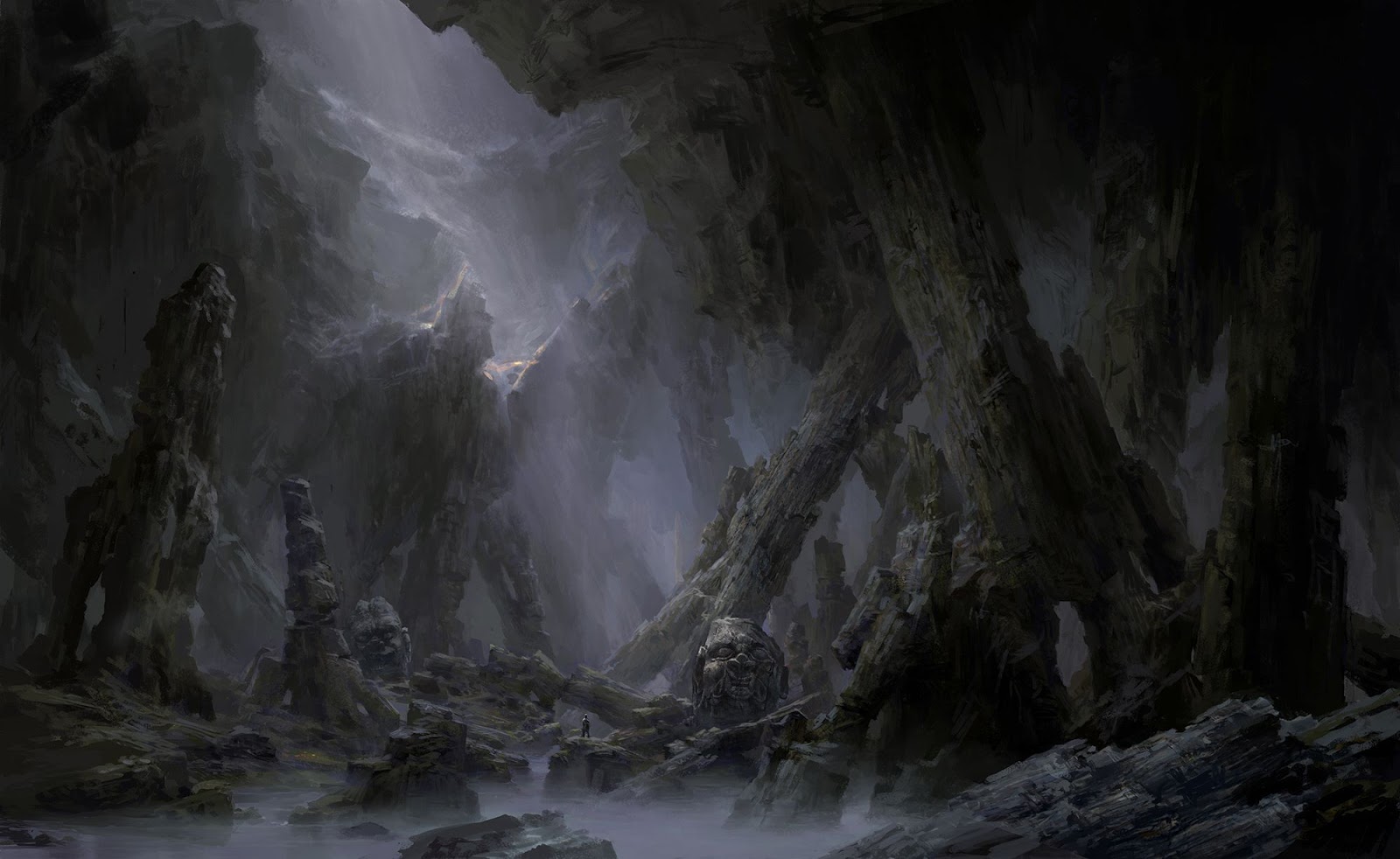

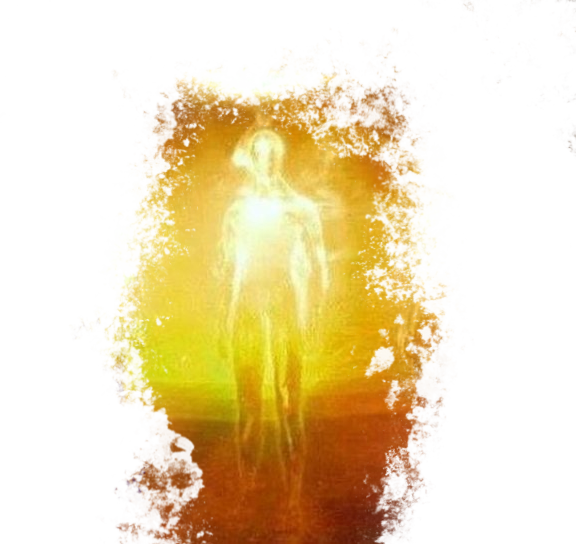
Paladin
Oath of Battle
While all paladins are, in one respect or another, the faith militant of their respective traditions, those who swear the Oath of Battle place themselves at the forefront of armed conflict. Crusaders of their faith, paladins that swear this Oath are often born leaders—chieftains, warlords, jarls, and khans—who stand resolute against all aggressors. More than just good in a fight, paladins who swear the Oath of Battle are champions of their people, and their presence inspires their allies to go that extra mile when weapons clash.
Tenets of Battle
- Honor. Seek opponents, not victims. Your weapons should only spill the blood of the strong in honorable battle.
- Courage. Never show cowardice in the face of adversity. There is no honor in waiting behind a barricade.
- Loyalty. Stay loyal to your allies, never let them down, and never let them stand alone. When an ally falls, it is your duty to pick them up and carry them to safety if need be.
- Discipline. Do not let anger, revenge, or despair come between you and your goal. Every battle is fought for a reason—always be prepared and remember your objective.
Oath of Battle Features
| Paladin Level | Feature |
|---|---|
| 3rd | Oath Spells, Channel Divinity |
| 7th | Aura of Action |
| 15th | Lead the Ranks |
| 20th | Exalted Warrior |
Oath of Battle Spells
| Paladin Level | Spells |
|---|---|
| 3rd | heroism, longstrider |
| 5th | earthbind, magic weapon |
| 9th | beacon of hope, enemies abound |
| 13th | find greater steed, freedom of movement |
| 17th | destructive wave, mass cure wounds |
Channel Divinity
When you take this oath at 3rd level, you gain the following two Channel Divinity options.
Channel Strength. As an action, you can imbue yourself with strength in the ways of the knight using your Channel Divinity. For 1 minute, or until you fall unconscious, you add your Charisma modifier to all your Strength ability checks and to the damage rolls of weapon attacks you make using Strength (minimum of 1).
Channel Agility. As an action, you can imbue yourself with agility in the ways of the skirmisher using your Channel Divinity. For 1 minute, or until you fall unconscious, your movement speed increases by a number of feet equal to 5 x your Charisma modifier (minimum of 5 feet), your reach increases by 5 feet, and opportunity attacks targeting you are made at disadvantage.
Aura of Action
Beginning at 7th level, your invigorating presence propels your cause forward. While you are conscious, you and friendly creatures within 10 feet of you add your Charisma modifier to initiative checks (minimum of 1).
At 18th level, the range of this aura increases to 30 feet.
Lead the Ranks
Starting at 15th level, you go gallantly and willingly to the front lines, placing yourself in danger to stir the hearts and minds of your companions and make your foes falter. When you succeed on a saving throw while under the effects of a Channel Divinity, you and friendly creatures within 30 feet of you gain temporary hit points equal to your Charisma modifier, and hostile creatures within 30 feet take radiant damage equal to your Charisma modifier (minimum 1).
Exalted Warrior
Starting at 20th level, as an action, you transform for 1 minute into the perfect avatar of battle told of in stories. For 1 minute, you gain the effects of both your Channel Divinity options, along with the following benefits:
- Your size becomes Large, unless you were larger.
- You shed bright light in a 30-foot radius and dim light 30 feet beyond that.
- Each of your ability scores becomes 22, unless it was already higher.
After taking this action, you must finish a long rest before you can do so again.


Oath of Enlightenment
Where most paladins swear Oaths to a divine cause or ideal, some swear an Oath to themselves, vowing to seek learning and growth. These paladins spend years in secluded places bettering themselves and trying to build up others. These warriors constantly seek to learn new things and ponder new discoveries. Some students eventually become teachers, and venture out into the world looking to bring enlightenment to all they meet.
Tenets of Enlightenment
- Prudence. Disaster awaits those who don't look before they leap. Be rational and logical in all your conduct.
- Learning. Knowledge is power. The unknown danger goes unstopped. Enlightenment can only be achieved by a humble willingness to learn.
- Teaching. Knowledge should not be kept to yourself. They ought to be shared with the world so that others might learn as you have.
- Understanding. Understanding others is more important than winning. Once you understand them, then you can teach them.
Oath of Enlightenment Features
| Paladin Level | Feature |
|---|---|
| 3rd | Oath Spells, Channel Divinity |
| 7th | Mystic Enlightenment |
| 15th | Active Mind |
| 20th | Awoken |
Oath of Enlightenment Spells
| Paladin Level | Spells |
|---|---|
| 3rd | comprehend languages, detect magic |
| 5th | detect thoughts, see invisibility |
| 9th | clairvoyance, dispel magic |
| 13th | divination, phantasmal killer |
| 17th | awaken, contact other plane |
Channel Divinity
When you take this oath at 3rd level, you gain the following two Channel Divinity options.
Psionic Smite. When you use your Divine Smite, you can invoke this Channel Divinity. The additional damage of Divine Smite becomes psychic damage, and the creature must make an Intelligence saving throw. On a failure, its unable to cast spells or use psionic abilities until the end of it's next turn.
Focus Mind. As a reaction to becoming Frightened, Charmed, or afflicted by negative mental status from failing an Intelligence, Wisdom, or Charisma saving throw, you may expend your Channel Divinity to immediately end the effect.
Mystic Enlightenment
Beginning at 7th level, you make your saves against effects that allow you to save at the end of end of your turn at the start of your turn instead.
Starting at 18th level, you can use your reaction to extend this benefit to another creature you can see that starts their turn within 30 feet of you and are under an effect they can attempt to make a save against at the end of their turn.
Active Mind
Starting at 15th level, you can no longer be surprised, and you can see and hear while unconscious as long as your have at least 1 hit point remaining.
Additionally, when you roll for Initiative, if the total result of your roll is less than your passive Perception, you can replace the result with the value of your passive Perception.
Awoken
At 20th level, as an action, you can fully perceive the world around you for what it is, piecing the veils that hide. You gain the following benefits for 1 minute:
- You gain truesight with a range of 120 feet.
- You are immune to psychic damage.
- You have advantage on saving throws against magical or psionic effects.
- When you strike an enemy with a Divine Smite you can choose to cast dispel magic on the target as a bonus action without expending a spell slot. If the level of the spell slot spent on Divine Smite was higher than 3rd level, you cast dispel magic at the level of spell slot spent.
Once you use this feature, you can't use it again until you finish a long rest.
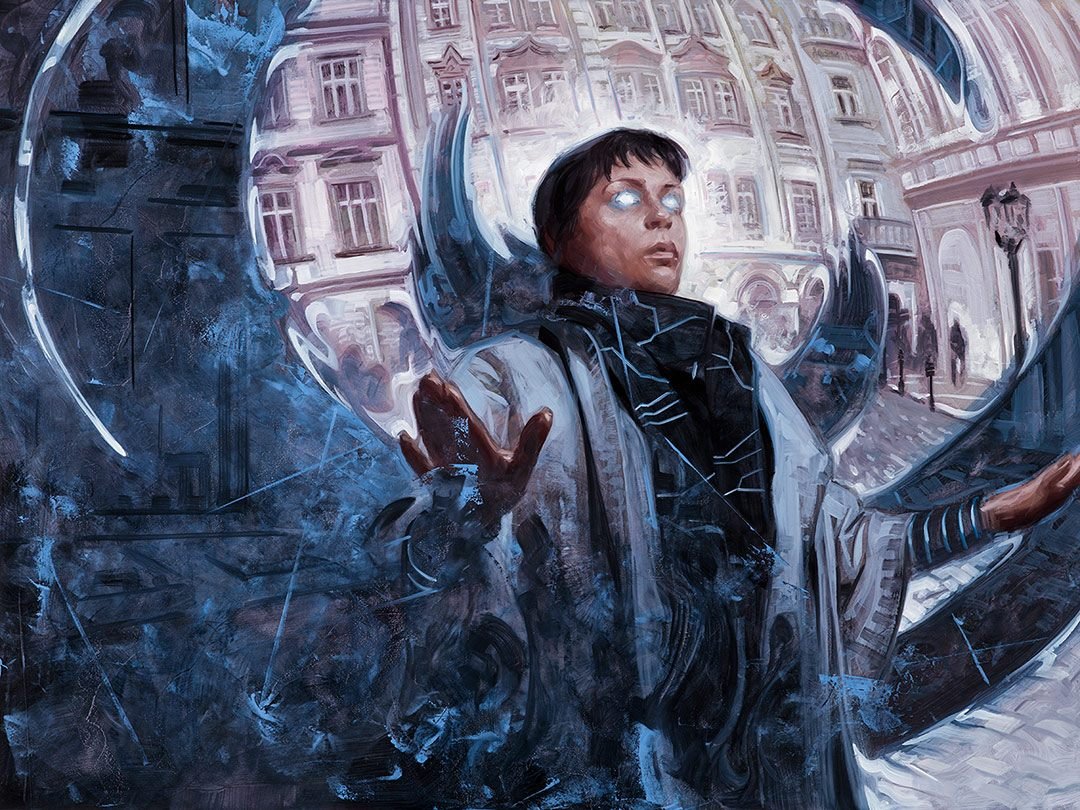



Oath of Freedom
Most paladins place great emphasis on duty, honesty, order and justice, believing that an orderly approach to life is the best way to keep their tenets and accomplish their objectives. The Paladins of Freedom, however, reject this approach. Instead, they stress that personal liberty is the most important thing an individual can have.
The Oath of Freedom ties paladins to the ideals of liberty and personal agency above all else. Paladins of this oath resemble skirmishers more than they do knights in shining armor. They use their skills to free the oppressed and defend them from oppressors. For this reason, kings, queens, and other rulers are often suspicious of Freedom paladins—for where these paladins go, revolution may soon follow.
Tenets of Freedom
- Liberty. Tyranny must be opposed. Chains imposed by unjust authority are meant to be broken.
- Revolution. Change is only brought through sudden transformational struggle.
- Independence. There shall be no lords over others. Power is best left in the hands of the people.
- Equity. Respect the autonomy and desires of others. Hierarchy only leads to injustice.
Oath of Freedom Features
| Paladin Level | Feature |
|---|---|
| 3rd | Oath Spells, Channel Divinity |
| 7th | Aura of Mobility |
| 15th | Free Spirited |
| 20th | Limitless |
Oath of Freedom Spells
| Paladin Level | Spells |
|---|---|
| 3rd | jump, zephyr strike |
| 5th | blur, spider climb |
| 9th | fly, sending |
| 13th | dimension door, freedom of movement |
| 17th | awaken, passwall |
Channel Divinity
When you take this oath at 3rd level, you gain the following two Channel Divinity options.
Freedom from Chains. You can use your Channel Divinity as a bonus action to inspire others to rise against their oppressors. All friendly creatures other than yourself within 30 feet of you can use their reaction to stand if they are prone or to make an ability check or saving throw to attempt to escape from being grappled or restrained.
Chaotic Strike. You can use your Channel Divinity when you hit with a weapon attack to strike with the powers of chaos. The attack inflicts extra damage equal to 1d6 + half your paladin level. The number on the d6 determines the type of the extra damage. A target that takes the damage must make a Constitution saving throw or also experience an additional effect based on the damage type.
Damage Type of Chaotic Strike
| d6 | Damage Type | Extra Effect |
|---|---|---|
| 1 | Acid | The target takes acid damage equal to half your paladin level at the end of its next turn. |
| 2 | Cold | The target's speed is reduced to 0 until the end of its next turn. |
| 3 | Fire | The target is blinded until the end of its next turn. |
| 4 | Lightning | The target is incapacitated until the end of its next turn. |
| 5 | Poison | The target is poisoned until the end of its next turn. |
| 6 | Thunder | The target is knocked prone and 15 feet directly away from you. |
Aura of Mobility
Starting at 7th level, you and friendly creatures within 10 feet of you are unaffected by magical and nonmagical difficult terrain while you are conscious.
At 18th level, the range of this aura increases to 30 feet.
Free Spirited
At 15th level, when you use your action to Dash or Disengage, you can make a single weapon attack as a bonus action.
Limitless
At 20th level, you break free of all bonds and restrictions. Using your action, you undergo a transformation. For 1 minute, you gain the following benefits:
- You gain a flying speed of 90 feet.
- You are under the effects of a freedom of movement spell.
- You are immune to enchantment spells you do not choose to be affected by.
- You can move through creatures and objects. You take 1d10 force damage if you end your turn inside an object.
- When you inflict damage on a creature, you ignore its damage resistances.
Once you use this feature, you can’t use it again until you finish a long rest.
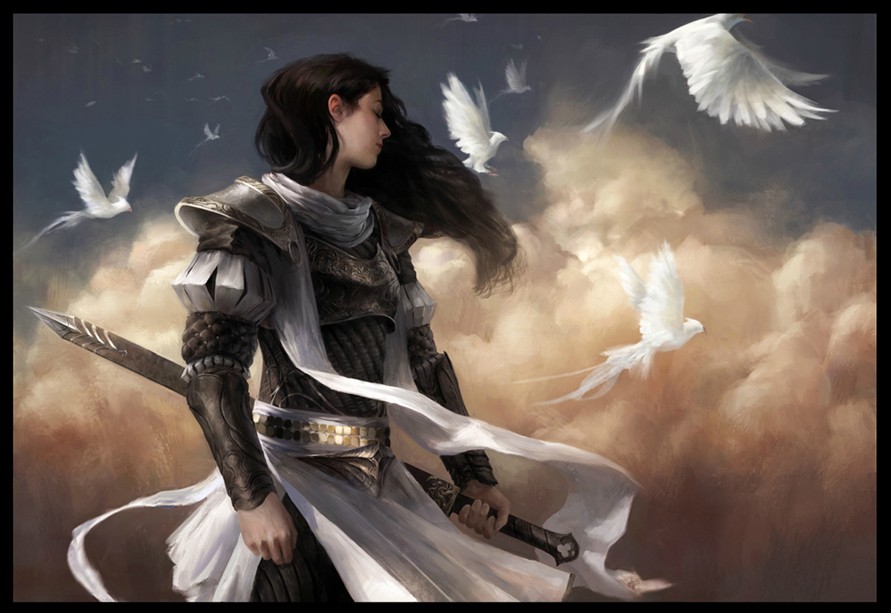


Oath of Friendship
Paladins take on many types of oaths, and not always towards a king or higher power. Some choose to be loyal to the people around them instead, swearing to uphold the force that binds people together in friendship. Those sworn to the Oath of Friendship dedicate themselves to their relationships, friendships, and even lifelong rivalries. These knights understand that sometimes the strongest thing one can do is ask for help. Transcending race and creed, the Oath of Friendship can be upheld as long as people are willing to stand by each other's side.
Tenets of Friendship
- Stand With Your People. Never betray your friends. Stand with them no matter what.
- Defend Your People. Nothing is more important than keeping the ones you swore to protect safe.
- Help Your People. Lend a helping hand when in need to keep your friends feeling strong and ready for battle.
- Die For Your People. If it comes down to it, you must lay your life on the line to keeping your friends safe.
Oath of Friendship Features
| Paladin Level | Feature |
|---|---|
| 3rd | Oath Spells, Channel Divinity |
| 7th | Supportive Presence |
| 15th | Unwavering Loyalty |
| 20th | Best of Friends |
Oath of Friendship Spells
| Paladin Level | Spells |
|---|---|
| 3rd | charm person, sanctuary |
| 5th | calm emotions, find traps |
| 9th | catnap, remove curse |
| 13th | aura of purity, charm monster |
| 17th | dawn, holy weapon |
Channel Divinity
When you take this oath at 3rd level, you gain the following two Channel Divinity options.
Help From Friends. As an action, you speak a message of unity in a loud voice. A hostile creature of your choice within 5 feet of you is considered to be distracted by the Help action from an unseen source at the start of each of your turns for a number of rounds equal to your Charisma modifier (minimum 1).
Turn the Unholy. As an action, you present your holy symbol and speak a prayer censuring fiends and undead, using your Channel Divinity. Each fiend or undead that can see or hear you within 30 feet of you must make a Wisdom saving throw. If the creature fails its saving throw, it is turned for 1 minute or until it takes damage.
A turned creature must spend its turns trying to move as far away from you as it can, and it can't willingly move to a space within 30 feet of you. It also can't take reactions. For its action, it can use only the Dash action or try to escape from an effect that prevents it from moving. If there's nowhere to move, the creature can use the Dodge action.
Supportive Presence
At 7th level, when you use your Lay on Hands feature, you can target a creature up to 10 feet away from you. You can cure the charmed and frightened conditions in addition to diseases and poisons by spending 5 hit points from your pool. The range of this ability increases to 30 feet when you reach 18th level in this class.
Unwavering Loyalty
Starting at 15th level, if you would drop to zero hit points while at least one allied creature is within 60 feet, you can make a Charisma saving throw with a DC equal to the amount of damage taken over your current hit points. On success, you instead drop to 1 hit point.
Each time you use this feature after the first, the DC increases by 5. The DC resets when you finish a long rest.
Best of Friends
At 20th level, whenever an allied creature makes an attack against a creature, you can use your reaction to take the Help action, granting them advantage on the attack.
If an allied creature is reduced to 0 hit points by another creature, you can use your reaction to move up to your movement speed towards them and make an attack against that creature. On this attack, you can use your Divine Smite feature at its lowest level without expending a spell slot.


Oath of Justice
The Oath of Justice is a commitment not the tenets of good or evil but a holy vow sworn to uphold the law. When lawlessness threatens the peace, those who swear the Oath of Justice intervene to maintain order and ensure that criminals are suitably punished. Sometimes called adjudicators, some of these paladins are patriots to a state, while others are sheriffs or vigilantes enforcing law in the absence of any civil authority—or even defying the authorities so as to pay obeisance to some greater governing principle.
Tenets of Justice
- Uphold the Law. Be true to the ideals of law, and yield to legitimate authority. Strike down chaos where it stands. Act with consistency, and be disciplined in your conduct.
- Justice is Fair. Provide all accused with a fair trial. The severity of justice should be in accordance with the severity of a wrongdoer’s transgressions.
- Justice is Impartial. Never let personal prejudices and opinions interfere with the administration of justice.
- Justice is Universal. The lowest begger is as deserving of justice as the greatest king.
Oath of Justice Features
| Paladin Level | Feature |
|---|---|
| 3rd | Oath Spells, Channel Divinity |
| 7th | Thief Catcher |
| 15th | Punish the Guilty |
| 20th | Bringer of Justice |
Oath of Justice Spells
| Paladin Level | Spells |
|---|---|
| 3rd | alarm, ensnaring strike |
| 5th | hold person, see invisibility |
| 9th | dispel magic, tongues |
| 13th | locate creature, mordenkainen's faithful hound |
| 17th | bigby's hand, planar binding |
Channel Divinity
When you take this oath at 3rd level, you gain the following two Channel Divinity options.
Turn the Lawless. As an action, you can utter a prayer that is painful to creatures of chaos. You display your holy symbol and speak your condemnatory prayer, using your Channel Divinity. Each aberration, demon, or fey that can see or hear you within 30 feet of you must make a Wisdom saving throw. If the creature fails its saving throw, it is turned for 1 minute or until it takes damage.
A turned creature must spend its turns trying to move as far away from you as it can, and it can’t willingly move to a space within 30 feet of you. It also can’t take reactions. For its action, it can use only the Dash action or try to escape from an effect that prevents it from moving. If there’s nowhere to move, the creature can use the Dodge action.
Shackles of Justice. As an action, you can use your Channel Divinity to bind a creature with your divine power. Choose a creature within 60 feet of you. They must succeed on a Wisdom saving throw or have their flying and burrowing speeds reduced to 0, and their movement speed halved for 1 minute. A creature can repeat the saving throw at the end of each of their turns, ending the effect on a success.
Thief Catcher
At 7th level, when an enemy moves within 10 feet of you, you may use a reaction to stop them during the move with an invisible hand. The enemy makes a Charisma saving throw against your spell save DC. On a fail, all of their movement speeds are reduced to 0 until the beginning of their next turn. You may also choose to pull a creature that fails this save up to 10 feet towards you. On a successful save, the creature is immune to this effect for 24 hours.
At 18th level, the range of this ability increases to 30 feet.
Punish the Guilty
Once you reach 15th level, when you are hit by an attack and receive damage, you may use a reaction to take half the triggering damage and cause the attacking creature to take the same amount of damage.
Once you use this ability, you can't use it again until you finish a short or long rest.
Bringer of Justice
At 20th level you can, as an action, become the very embodiment of law and justice itself. Your eyes begin to glow slightly with a dim light, and you are empowered to mete out justice against all criminals who would seek to escape the hands of the law. For 1 minute, you gain the following benefits:
- You have truesight out to 120 feet.
- Attacks against you are made with disadvantage.
- When you take the Attack action, you make all the attacks with advantage.
Once you use this feature, you can't use it again until you finish a long rest.





Oath of Prosperity
A wealthy benefactor can save a civilization, while a wealthy tyrant can turn the world on its head. The Oath of Prosperity merges the spiritual with the materialistic, benevolence with self-interest, and temperance with a hunger for power. No matter their background, those who swear the oath of Prosperity value gold above all else, and view their economic success as a sign of divine favor.
Tenets of Prosperity
- Ownership. The more you have, the more you can do. Belongings are sacred, and should never be given away without greater gain.
- Security. Every individual has the right to secure and protect themselves and their property.
- Investment. All the money in the world does nothing if you cannot spend it. Join with others and invest in their efforts, so that you may reap the rewards.
- Expansion. There is no such thing as having enough, do not become complacent with success. Constantly strive to build yourself, your investments, and your influence.
Oath of Prosperity Features
| Paladin Level | Feature |
|---|---|
| 3rd | Oath Spells, Channel Divinity |
| 7th | Aura of Investment |
| 15th | Hand of Greed |
| 20th | Gilded Guardian |
Oath of Prosperity Spells
| Paladin Level | Spells |
|---|---|
| 3rd | identify, unseen servant |
| 5th | knock, suggestion |
| 9th | glyph of warding, tiny servant |
| 13th | fabricate, leomund's secret chest |
| 17th | infernal calling, geas |
Channel Divinity
When you take this oath at 3rd level, you gain the following two Channel Divinity options.
Golden Suit. As an action, you can use your Channel Divinity to coat yourself in shining gold for 1 hour. You gain temporary hit points equal to twice your paladin level for the duration. Whenever a creature hits you with a melee attack while you have these hit points, gold sprays off your armor, causing the creature to suffer disadvantage on their first attack before the end of their next turn.
Hired Help. As an action, you can use your Channel Divinity to summon a simple magical construct for 1 hour. This construct has the statistics of a commoner, though it is a construct instead of its normal type. It cannot attack, cast spells, or activate magic items. If it dies or the duration expires, it fades into mist.
Aura of Investment
Starting at 7th level, you are surrounded by a 10-foot aura of mutual benefit. You and all friendly creatures within 10 feet of you gain temporary hit points equal to your Charisma modifier (minimum of 1) at the start of each of your turns.
At 18th level, the range of this aura increases to 30 feet.
Hand of Greed
Starting at 15th level, once per turn when you hit a creature with an unarmed strike, you can attempt to steal an object or weapon from the target. The target must succeed on a Strength saving throw against your paladin spell save DC or lose the chosen item. If you lack a free hand to steal the item, the attempt automatically fails.
Gilded Guardian
At 20th level, you call upon the debts that you are owed and empower yourself. For 1 minute, the rustling of your armor sounds strangely like the clinking of coins. You gain the following benefits.
- You gain 20 temporary hit points at the start of each of your turns that last for the duration of this feature.
- Whenever you steal a weapon using your Hand of Greed feature, you can immediately make a weapon attack using it. This does not require an action.
- When you hit a creature with a melee weapon attack, you can choose to unleash a blast of golden light. The target must make a Wisdom saving throw against your paladin spell save DC. If they fail, they are blinded until the end of your next turn.
Once you use this feature, you can’t do so again until you finish a long rest.
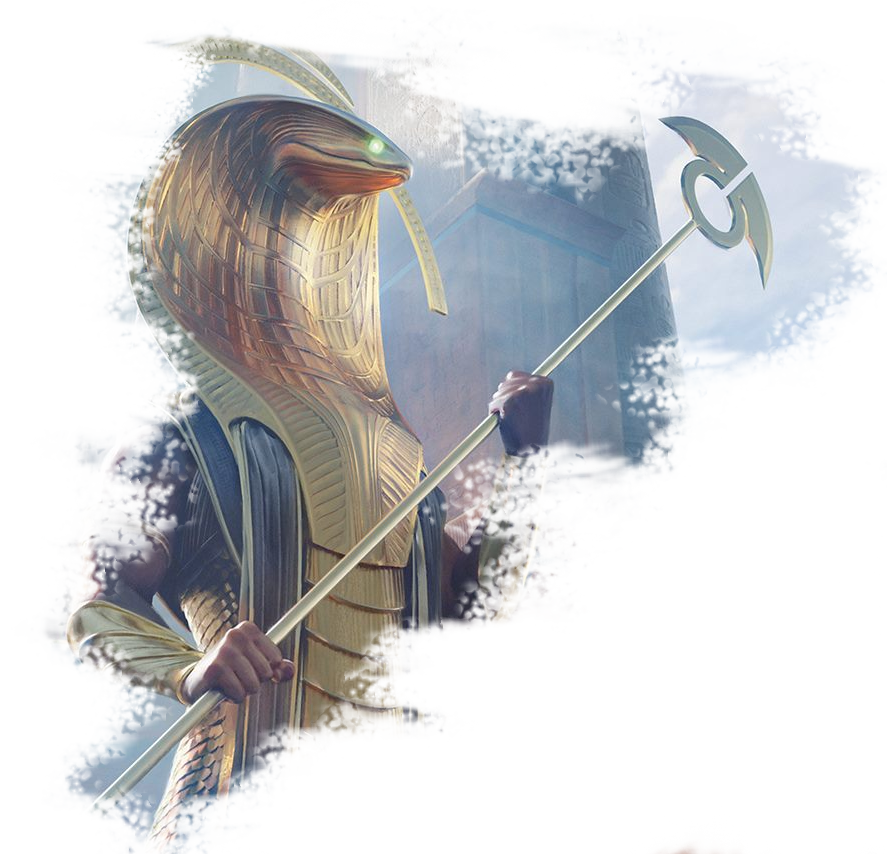


Oath of Shadows
The Oath of Shadows is a pledge to serve as the weapon of a dark patron that eschews the light of day. It is said the first paladins to swear this Oath swore it to the night itself, to defend night travelers from those that would prey on them.
Paladins of Shadows universally wear shades of brown, grey, and black, and are equally at home in leathers as they are in plate. Always a foreboding sight, paladins of this Oath sometimes find themselves the target of fear, suspicion, and prejudice from those afraid of who, or what they represent.
Tenets of Shadows
- Obfuscation. Whether your deeds are noble or nefarious, little good comes from drawing undue attention to oneself. Do not let your name or face be known; those that remain unrecognized live to fight another day.
- Calculation. Stumbling into situations is an easy way to die. Plan thoroughly for all contingencies, but do not be afraid to modify your plans should the situation change.
- Silence. Words carry power, and the wrong ones can end a life. Take great care in what you say and, when in doubt, say nothing at all.
- Loyalty. Whether those at your side are allies or assets, their utility and aid cannot be ignored. Look after them, assist them in their struggles, and make sure they profit from your presence just as much as you profit from theirs.
Oath of Shadows Features
| Paladin Level | Feature |
|---|---|
| 3rd | Oath Spells, Channel Divinity |
| 7th | Midnight Blessing |
| 15th | Umbral Jaunt |
| 20th | Living Nightmare |
Oath of Shadows Spells
| Paladin Level | Spells |
|---|---|
| 3rd | disguise self, dissonant whispers |
| 5th | darkness, silence |
| 9th | blink, fear |
| 13th | arcane eye, evard's black tentacles |
| 17th | mislead, modify memory |
Channel Divinity
When you take this oath at 3rd level, you gain the following two Channel Divinity options.
Ghostly Blade. When you hit a creature with an attack, you may also use your Channel Divinity, empowering your weapon with dreadful shadow. If you do, the target and each other creature of your choice within 5 feet of it must succeed on a Wisdom saving throw or be blinded until the end of their next turn, and all damage that you deal in this attack becomes either psychic or necrotic damage (your choice).
Night Cloak. As an action you present a holy symbol, begin concentrating and use your Channel Divinity, weaving your power around you to hide yourself from view. For up to 1 hour or until you break concentration, attack, or cast a spell, you are invisible, inaudible, and your armor does not give you disadvantage on Dexterity (Stealth) checks. You are also silent and incapable of speaking for the duration.
Midnight Blessing
Beginning at 7th level, the darkness grants you a boon, which you may pass on to those around you. For you and creatures you choose within 10 feet of you, armor does not impose disadvantage on Dexterity (Stealth) checks, and creatures within this radius gain darkvision out to 60 feet. If they already have darkvision, they increase their current darkvision by 60 feet. Further, any affected creature within the radius may telepathically send a message that can be heard only by other affected creatures within the radius.
At 18th level, the radius of this ability increases to 30 feet.
Umbral Jaunt
Starting at 15th level, you can slide through darkness to strike in retribution at those who threaten your allies. When a creature within 30 feet of you makes an attack against you or a creature friendly to you, you may use your reaction to teleport yourself through your shadow to a point within 5 feet of the attacking creature. You may then make one attack against the creature, resolving it after the creature resolves its attacks. You can teleport up to 60 feet if the attacking creature is standing in an area of dim light or darkness.
Once you use this ability, you require a short or long rest to use it again.
Living Nightmare
At 20th level, you grow ever closer to becoming one with the night. As an action on your turn, you can allow the shadow energy within you to overtake your physical form, turning you into a shifting, pitch dark humanoid horror. For 1 minute, you gain the following benefits:
- Your attacks deal an additional 1d8 psychic damage, and a creature hit by one or more of your attacks on your turn must succeed on a Wisdom saving throw against your spell save DC or become frightened of you until the end of your next turn.
- You are invisible to all creatures except the creature you have most recently attacked. This invisibility persists even after you attack or cast a spell.
- You can move through a space as narrow as one inch in diameter without squeezing.
- You have resistance to bludgeoning, piercing, and slashing damage from nonmagical weapons that are not silver.
Once you use this feature, you cannot use it again until you finish a long rest.
Ranger
Hellwalker Conclave
You are a Hellwalker, a ranger that is cloaked in the magic of the Lower Planes. A Hellwalker specializes in living in harsh, dry conditions of the world. These rangers are accustomed to the extreme temperatures of such environments.
Hellwalker Conclave Features
| Ranger Level | Feature |
|---|---|
| 3rd | Conclave Magic, Damning Strike, Cursed Tongue |
| 7th | Burning Constitution |
| 11th | Mark of the Damned |
| 15th | Fiendish Spawn |
Hellwalker Conclave Magic
| Ranger Level | Spells |
|---|---|
| 3rd | hellish rebuke |
| 5th | scorching ray |
| 9th | stinking cloud |
| 13th | wall of fire |
| 17th | dominate person |
Damning Strike
Starting at 3rd level, you imbue your strikes with the neverending flames of the Lower Planes. When you hit a creature with a weapon attack, you can force it to make a Constitution saving throw against your spell save DC. On a failed save, the target is marked for 1 minute and takes 1d6 fire damage at the start of each of its turns. At the end of each of its turns, it can repeat this saving throw, ending the effect on a success. A creature can only be affected by one instance of this feature at a time.
You can use this feature a number of times equal to your proficiency bonus, and you regain all expended uses when you finish a long rest.
Cursed Tongue
Also at 3rd level, your fiendish affinity allows you to speak, read and write Abyssal and Infernal.
Burning Constitution
At 7th level, you gain the resistance to the environment of the lower planes. You gain resistance to fire damage. If you already have resistance to fire damage, you can instead choose one from the following: cold, necrotic, poison, or psychic.
Mark of the Damned
Starting at 11th level, you are able to use your hellish power to brand a creature. As a bonus action, you can choose a creature that has been marked by your Damning Strike feature. While marked, the chosen creature suffers from the following effects:
- It takes 1d8 fire damage at the start of its turns instead of 1d6
- It becomes frightened of you.
- It loses resistance against your attacks and abilities that deal fire damage.
- You have advantage on saving throws against spells and other magical effects made by it.
You can only have one creature affected by this feature at a time.
Fiendish Spawn
When you reach 15th level, your hellish magic has granted you limited command over the damned creatures that inhabit the Lower Planes. You can cast summon fiend as a 6th-level spell without expending a spell slot or material components. When you cast in this way, the spell's duration becomes 1 minute.
Once you use this feature, you can't do so again until the end of a long rest.

Lightcaller Conclave
Since the dawn of time, mankind has feared the darkness. Ranger belonging to the Lightcaller Conclave draw their power from the positive plane to defend civilization against creatures that lurk in the gloaming. Each nurse a bright ember that burns against the night. What terror lays in the darkest corners of the night are the Lightcaller's quarry, for the night should provide solace and calmness, not fear. These rangers often ally with celestials, and wield their light like extensions of their body.
Lightcaller Conclave Features
| Ranger Level | Feature |
|---|---|
| 3rd | Conclave Magic, Light Motes, Radiant Armaments |
| 7th | Luminous Defense |
| 11th | Dawnstriker |
| 15th | Conjure Mote |
Lightcaller Conclave Magic
| Ranger Level | Spells |
|---|---|
| 3rd | guiding bolt |
| 5th | skywrite |
| 9th | blinding smite |
| 13th | locate creature |
| 17th | flame strike |
Light Motes
Starting at 3rd level, you learn to conjure motes of light. As a bonus action, you can expend a spell slot to conjure motes of light that encircle you. You conjure two motes with a 1st-level spell slot, creating one additional mote for each spell level higher than 1st. You can have a number of motes equal to half your ranger level. Any additional motes you create disappear. These motes last until they are used or until you finish a long rest.
If you have three or more motes remaining, they shed bright light in a 20-foot radius and dim light for an additional 20 feet. If you have one or two motes remaining, they shed dim light in a 20-foot radius.
You can expend a mote to make a ranged spell attack that you can use with the Attack action. The attack has a range of 120 feet, and on a hit the target takes 2d6 radiant damage and is pushed 10 feet away from you.
Radiant Armaments
At 3rd level, your strikes become imbued with the power of the dawn. You learn the three Radiant techniques.
Guiding Shot. As a bonus action, you can expend a mote to imbue a piece of ammunition with light. The ammunition sheds dim light in a 5-foot radius until the end of your next turn. When you hit a creature with this piece of ammunition, it takes an additional 1d6 radiant damage, sheds dim light in a 5-foot radius until the end of your next turn, and the next attack roll made against it before the end of your next turn has advantage.
Scattered Sparks. As an action, you can expend a mote and launch it at a point within 120 feet of you. Each creature within 10 feet of that point must make a Dexterity saving throw against your ranger spell save DC. A creature takes 2d6 fire damage on a failed save, or half as much damage on a successful one. This damage increases to 3d6 at 7th level, 4d6 at 11th level, and 5d6 at 15th level.
Luminous Redirection. When you miss a ranged weapon attack or ranged spell attack, you can expend a mote to use a bonus action to reroll the attack roll against a different target within 60 feet of the original target. On a hit, the attack deals an additional 1d6 radiant damage.
Luminous Defense
At 7th level, the power of the light comes to your aid in times of need. When a creature moves within 10 feet of you for the first time on a turn, you can use your reaction to make a mote attack at the creature.
Dawnstriker
At 11th level, your attacks become infused with light. Whenever you hit a creature with a weapon attack, it takes an additional 1d6 radiant damage.
Conjure Mote
At 15th level, you learn to create light motes with your own powers. You can use an action while you have no motes to create one mote.


Spellbreaker Conclave
Magic tempts, magic corrupts. Where there is power, there are those who would abuse it. Spellbreakers are a small, but dedicated conclave of ranger who specialize in hunting down evil spellcasters. While others may ignore the dangers of magic or succumb to its siren call of power, these rangers devote their life to rooting out witches and those who would wield magic for sinister and selfish means.
Trained in ways to both track and defend against mages, most spellbreakers operate in the shadows, only revealing themselves when success is a certainty. They know all too well the magical might that burns over the helpless or wrestles control from the mind. When one wrong move could end in disintegration, there is no room for error.
Spellbreaker Conclave Features
| Ranger Level | Feature |
|---|---|
| 3rd | Conclave Magic, Bonus Proficiencies, Mage Hunter |
| 7th | Arcane Defense |
| 11th | Spellbreaker Technique |
| 15th | Inquisitor's Resolve |
Spellbreaker Conclave Magic
| Ranger Level | Spells |
|---|---|
| 3rd | detect magic |
| 5th | mind spike |
| 9th | counterspell |
| 13th | otiluke's resilient sphere |
| 17th | hold monster |
Bonus Proficiencies
At 3rd level, you become proficient in your choice of two of the following skills: Arcana, History, Nature, or Religion.
Mage Hunter
When you adopt this archetype at 3rd level you gain the skills necessary to hunt spellcasters of all kinds. You can use a bonus action to mark a creature you can see within 30 feet of you as your quarry, heightening your abilities against them. For 1 minute, or until the creature dies, you die, or you are incapacitated, the following conditions apply:
- You learn the target's spellcasting ability (if it has one), and the level of the highest spell it can cast.
- The first time each turn that you hit the target with a weapon attack, you can force the target to make a Wisdom saving throw. On a failed save, the target has disadvantage on the next spell attack that it makes.
- You cannot be frightened or possessed by the target while you are conscious, and you have advantage on saving throws against being charmed by them.
You can use this feature a number of times equal to your Wisdom modifier (minimum of once). You regain all expended uses of it when you finish a long rest.
Arcane Defense
Starting at 7th level, your blood has developed an innate magical ward. When you are forced to make a saving throw for a spell or other magical effect, you gain a bonus to the roll equal to your Wisdom modifier (minimum of 1).
Spellbreaker Technique
At 11th level, you have learned how to render magical effects useless. You gain the following abilities that you can use once per turn to augment your weapon attacks.
Dispelling Strike. When you hit a creature that is under the effects of a spell or other magical effect with a weapon attack, the creature takes an extra 2d8 force damage and you can make a Wisdom check. The DC equals 10 + the spell or magical effect’s level. On a successful check, the spell or magical effect affecting the creature ends.
Disrupting Strike. When you hit a creature that is concentrating on a spell with a weapon attack, you deal an extra 2d8 force damage and force them to have disadvantage on the Constitution saving throw to maintain concentration.
You can use this feature a number of times equal to your Wisdom modifier (minimum of once). You regain all expended uses of it when you finish a long rest.
Inquisitor's Resolve
Upon reaching 15th level, your training as a Spellbreaker has reached its apex. While a creature is marked with your Mage Hunter feature, you get truesight against that creature and you are aware of their exact location as long they are within 300 feet of you.
Additionally, When a spell or other magical effect reduces you to 0 hit points but does not kill you outright, you can instead drop to a number of hit points equal to your ranger level. Until the end of your next turn, you have advantage on saving throws against spells and other magical effects.
Once you use this feature, you cannot do so again until you finish a long rest.
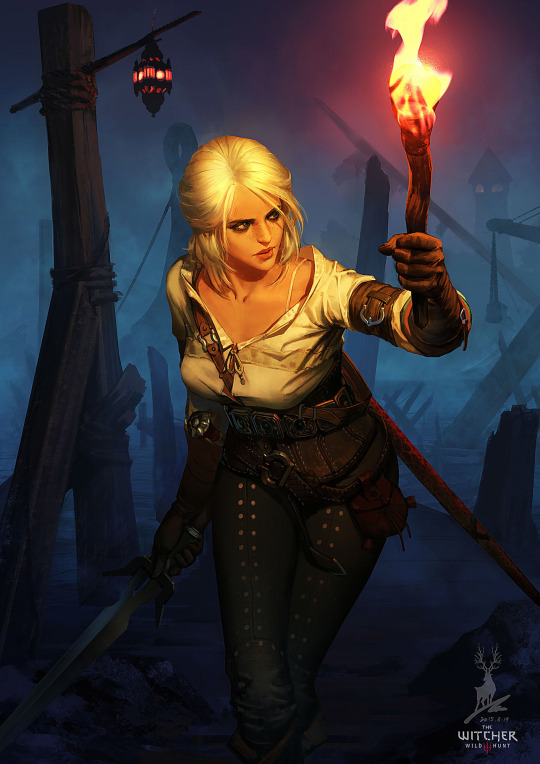

Rogue
Acrobat Archetype
Trained by circuses, certain temples, and the odd organization of criminals (or vigilantes), the archetypical Acrobat is light on their feet and incredibly agile, able to tumble, somersault, and walk across tightropes with ease. The skills of a gymnast find a myriad of applications in the adventuring world, so whether it be for dungeon diving, cat-burgling, or brawling in a busy tavern, acrobats are always great to have on your side.
Acrobat Archetype Features
| Rogue Level | Feature |
|---|---|
| 3rd | Natural Acrobat, Advanced Tumbling |
| 9th | Death from Above |
| 13th | Freerunning |
| 17th | Peerless Dodge |
Natural Acrobat
Starting at 3rd level, you have proficiency in the Dexterity (Acrobatics) skill if you did not already have it, and you have advantage on ability checks made using this skill on your turn. Additionally, when you are prone, standing up uses only 5 feet of your movement.
Advanced Tumbling
At 3rd level, you can move through the space of any creature without it costing extra movement. Once you have moved through a creature's space, that creature has disadvantage on opportunity attacks against you until the end of your turn.
Death from Above
At 9th level, you have resistance to damage from falls. If you land on a creature's space at the end of a fall and take the Attack action, you have advantage on your attack roll and you deal an additional 1d6 damage for every 10 feet you fell, up to a maximum of 6d6. Only melee weapon attacks can benefit from this feature.
Freerunning
Starting at 13th level, you ignore difficult terrain and climbing no longer halves your movement. You can spend up to half your movement speed on your turn climbing even difficult surfaces (such as vertical walls) without making an ability check.
Peerless Dodge
By 17th level, you are so nimble you can use your reaction to take no falling damage from falling any distance shorter than 100 feet. Additionally, you can dodge almost anything. When a creature you can see damages you with a spell, you can use your Uncanny Dodge to halve the spell's damage against you.


Cut-Throat Archetype
You've learned to fight dirty whenever you can, and that villainy—for better or worse—can open more doors than it closes. Yours is a walk of life shared by Thieves’ Guild enforcers, untrained brawlers, highwaymen, and crooked mercenaries. Quick thinking, versatility in action, and utter ruthlessness help you to shine in a skirmish, as well as corral strangers in the social world.
Cut-Throat Archetype Features
| Rogue Level | Feature |
|---|---|
| 3rd | Quick Witted, Dirty Tactics |
| 9th | Bully |
| 13th | Adaptive Defense |
| 17th | Expert Miscreant |
Quick Witted
Starting when you select this archetype at 3rd level, you are always prepared for trouble. You can’t be surprised while conscious, and gain proficiency with improvised weapons. In addition, clubs, light hammers, maces, sickles, and improvised weapons become finesse weapons for you.
Dirty Tactics
Also at 3rd level, whenever you land a Sneak Attack on a creature within 5 feet of you, you can activate a Tactic (listed below) before rolling for damage. To do so, you must forgo rolling a certain number of your Sneak Attack dice (based on the Tactic chosen), after which any remaining d6s are rolled for damage.
When you activate a Tactic, you must execute it on the target of your Sneak Attack and you cannot use more than 1 Tactic per attack. You can only use Tactics with costs that don’t exceed the number of d6s you’d normally roll for a Sneak Attack. For example, at 3rd and 4th level, you can only use Tactics which cost 2d6 or less.
If you wish to use a Tactic when you score a critical hit, double the amount of Sneak Attack dice to be rolled for damage first. Then, subtract the Tactic’s d6 cost from this total.
Your Tactics may force a creature to make a saving throw. If so, the DC is 8 + your proficiency bonus + your Strength modifier or your Dexterity modifier (whichever is higher).
Bully
At 9th level, you develop a flair for exploiting the panicked. Using your Cunning Action, you can make a Charisma (Intimidation) check contested by the Wisdom (Insight) check of a creature within 30 feet of you. On a success, that creature becomes frightened of you until the end of your next turn or until you and the target are more than 30 feet apart. You can use your Sneak Attack against frightened creatures without having advantage on your attack rolls.
You can use this feature a number of times equal to your Charisma modifier (minimum of once). You regain any expended uses each time you finish a long rest.
Adaptive Defense
From 13th level, you more quickly adapt to strategies. After failing a saving throw caused by a creature, you have advantage on the next saving throw caused by that creature that uses the same ability score. You cannot benefit from this feature against the same creature more than once per short or long rest.
Expert Miscreant
By 17th level, you have mastered every dirty trick in the book. If a creature succeeds on its saving throw against one of your Tactics, you can recover the d6s you spent to activate it. When you do so, you can use another Tactic as part of the same action or reaction, or roll the d6s for Sneak Attack damage.
You have two uses of this feature, and you regain any expended uses when you roll for initiative.
Tactics
The tactics are presented in order of sneak attack dice cost.
Throat Chop (costs 1d6). You attempt to crush a creature’s windpipe, forcing it to make a Constitution saving throw. On a failed save, until the start of your next turn, the target’s next saving throw to maintain concentration is made with disadvantage, and it can only speak falteringly.
Wound (costs 1d6). You try to cause a creature greater long-term harm, leaving it bleeding for 1 minute or until it is healed magically. At the start of each of its turns while bleeding, the target’s maximum and current hit points decrease by 1 due to blood loss. By succeeding on a Medicine check against your Tactic DC as an action, the target or one of its allies can stem this bleeding. You can spend additional d6s on this Dirty Tactic beyond its normal cost, increasing the hit point decrease by 1 per d6 spent.
Hobble (costs 2d6). You attempt to hit a creature with a hobbling blow, forcing it to succeed on a Constitution saving throw or have its movement speed reduced by 10 feet until the start of your next turn. During this time, the target cannot use the Dash, Dodge, Help, Search, Ready or Use an Object actions, nor can it take reactions.
Goad (costs 3d6). You attempt to draw a creature’s ire by infuriating it, forcing it to make a Wisdom saving throw. On a failed save, it has disadvantage on its attack rolls against creatures other than you until the start of your next turn.
Trip (costs 4d6). You attempt to trip a creature that is Large or smaller, forcing it to succeed on a Strength saving throw or fall prone.
Maim (costs 5d6). You attempt to cripple a creature, forcing it to succeed on a Constitution saving throw or drop whatever it's holding in an appendage of your choice. The target cannot use that appendage in any way until the end of its next turn.
Eye Gouge (costs 6d6). You attempt to curtail a creature’s vision by any means necessary, forcing it to succeed on a Dexterity saving throw or be blinded until the start of your next turn.
Divine Agent Archetype
Not all priests are clerics. Not all problems can be solved by prayer and preaching. Sometimes a more subtle touch is needed to steer the world as the faith dictates, and that is the roll of a Divine Agent. A blade in the night that commits the lesser evil for the greater good, or a quick end to someone that sniffed too close a cult's business, both could be the work of these divinely guided rogues.
Divine Agent Features
| Rogue Level | Features |
|---|---|
| 3rd | Spellcasting, Consecration |
| 9th | Benediction |
| 13th | Purification |
| 17th | Conviction |
Spellcasting
When you reach 3rd level, you gain the ability to cast spells. See chapter 10 of the Player's Handbook for the general rules of spellcasting and chapter 11 for the cleric spell list.
Cantrips. You learn two cantrips of your choice from the cleric spell list. You learn an additional cleric cantrip of your choice at 10th level.
Spell Slots. The Divine Agent Spellcasting table shows how many spell slots you have to cast your spells of 1st level and higher. To cast one of these spells, you must expend a slot of the spell's level or higher. You regain all expended spell slots when you finish a long rest.
For example, if you know the 1st level spell command and have a 1st level and a 2nd level spell slot available, you can cast command using either slot.
Spells Known of 1st-Level and Higher. You know three 1st-level cleric spells of your choice. The Spells Known column of the Divine Agent Spellcasting table shows when you learn more cleric spells of 1st level or higher. Each of these spells must be an abjuration or divination spell of your choice, and must be of a level for which you have spell slots. For instance, when you reach 7th level in this class, you can learn one new spell of 1st or 2nd level.
The spells you learn at 8th, 14th, and 20th level can come from any school of magic.
Whenever you gain a level in this class, you can replace one of the cleric spells you know with another spell of your choice from the cleric spell list. The new spell must be of a level for which you have spell slots, and it must be an abjuration or divination spell, unless you’re replacing the spell you gained at 8th, 14th, or 20th level from any school of magic.
Spellcasting Ability. Wisdom is your spellcasting ability for your cleric spells. You use your Wisdom whenever a spell refers to your spellcasting ability. In addition, you use your Wisdom modifier when setting the saving throw DC for a cleric spell you cast and when making an attack roll with one.
Divine Agent Spellcasting
| Rogue Level | Cantrips Known | Spells Known | 1st Level | 2nd Level | 3rd Level | 4th Level |
|---|---|---|---|---|---|---|
| 3rd | 2 | 3 | 2 | - | - | - |
| 4th | 2 | 4 | 3 | - | - | - |
| 5th | 2 | 4 | 3 | - | - | - |
| 6th | 2 | 4 | 3 | - | - | - |
| 7th | 2 | 5 | 4 | 2 | - | - |
| 8th | 2 | 6 | 4 | 2 | - | - |
| 9th | 2 | 6 | 4 | 2 | - | - |
| 10th | 3 | 7 | 4 | 3 | - | - |
| 11th | 3 | 8 | 4 | 3 | - | - |
| 12th | 3 | 8 | 4 | 3 | - | - |
| 13th | 3 | 9 | 4 | 3 | 2 | - |
| 14th | 3 | 10 | 4 | 3 | 2 | - |
| 15th | 3 | 10 | 4 | 3 | 2 | - |
| 16th | 3 | 11 | 4 | 3 | 3 | - |
| 17th | 3 | 11 | 4 | 3 | 3 | - |
| 18th | 3 | 11 | 4 | 3 | 3 | - |
| 19th | 3 | 12 | 4 | 3 | 3 | 1 |
| 20th | 3 | 13 | 4 | 3 | 3 | 1 |
Consecration
Beginning at 3rd level, at the end of a long rest, you can turn flasks of water into Holy Water through a special ritual. You can create a number of flasks of holy water this way equal to your proficiency bonus. Any flasks created this lose their divine power when you complete your next long rest.
You can throw Holy Water using the bonus action granted by your Cunning Action, and it counts as a ranged weapon you have proficiency with. Alternatively, you can use your Cunning Action to apply Holy Water to a weapon you are carrying. When you do so, your Sneak Attack damage becomes radiant damage for 1 minute.
Benediction
Starting at 9th, if you have no holy water from your Consecration feature when taking a short rest, you can use your Consecration feature to create a flask of Holy Water.
Purification
At 13th level, you can pierce the veil of treachery around your foes. If a creature within 60 feet is shrouded from your sight by a spell or magical effect (such as illusion, magical darkness, or invisibility), as a bonus action, you can make a Wisdom (Perception) check against the caster's spell save DC to see through the effect until the end of your turn.
Conviction
Starting at 17th level, 1st-level cleric spells you cast do not require concentration to maintain.
Medic Archetype
A different cut entirely, few things phase a rogue that has spent time seeing the worst that the battle field has to offer - roper bites, dragon burns, acid sprays and worse - and their in depth knowledge of anatomy can cut both ways on the battlefield. It would be unwise to underestimates the deadly precision of a medic, for cutting things open was never the hard part of their job.
Medics tend to be fastidious and educated, but where their moral compass points can vary widely on what brought them to their calling.
Medic Archetype Features
| Rogue Level | Feature |
|---|---|
| 3rd | Paramedic Procedures, Anatomical Assessment |
| 9th | Field Care |
| 13th | Medical Prodigy |
| 17th | Anatomical Expertise |
Paramedic Procedures
When you choose this archetype at 3rd level, you gain proficiency in the Medicine skill. If you already have proficiency with Medicine, you can choose to gain proficiency in one of History, Nature, or tool proficiency with the Herbalism Kit.
Additionally, you can use the bonus action granted by your Cunning Action to use a make a Wisdom (Medicine) check, administer or consume a Healing Potion, or use a Healer's Kit. When you use a Healer's Kit, the target regains additional hit points equal to your Wisdom modifier.
Anatomical Assessment
Starting at 3rd level, you can use the bonus action granted by your Cunning Action to make a Wisdom (Medicine) check targeting a creature to access its weaknesses. The DC is equal to the target's AC. You have advantage on this roll against humanoid creatures, and disadvantage against constructs and elementals.
If you succeed, you can use your Sneak Attack against that target even if you don't have advantage on the attack roll.
This benefit lasts for 1 minute or until you successfully use this feature against a different target.
Field Care
Starting at 9th level, during a short rest, you can clean and bind the wounds of up to six willing beasts and humanoids. If a creature you choose spends a Hit Die during this rest, the first hit die it expends is replaced by the maximum value of that die.
Medical Prodigy
Beginning at 13th level, you've incorporated a wider range of solutions to cures, to the point where your ability to cure patients borders on supernatural. You can make a Wisdom (Medicine) check on a creature within 5 feet to cure it of blinded, deafened, paralyzed, or poisoned conditions.
If the condition was the result of failing a saving throw, the DC of the check is equal to the DC of the saving throw. Otherwise the DC is 10.
Anatomical Expertise
When you reach 17th level, when you attack a target that you have succeeded on an Anatomical Assessment of, you can use that knowledge of their weakness to identify where stabbing them would do the most damage.
When you hit with a melee weapon attack against the target, you can inflict one of the following conditions:
- Legs. You cripple the creature's locomotion, reducing its movement speed by half.
- Neck. You open a critical artery, causing it to take 4d4 piercing damage at the start of its turns.
- Eyes. You strike the creature's eyes. The target is blinded.
At the end of a crippled creatures turns, it makes a Constitution saving throw (DC 8 + your Wisdom modifier + your proficiency bonus), ending the condition on a success. Once a creature has saved against a wound type, they are immune to that wound type for 24 hours.
You can do this a number of times equal to your Wisdom modifier and you regain expended all uses when you complete a long rest.


Ninja Archetype
Lurking in high mountaintop temples, darting amongst forest foliage, or haunting abandoned streets, a ninja is an elite rogue who has undergone intense training focused on stealth, infiltration, and survival. Some ninjas hire out their skills as mercenaries, but most owe fealty to a clan, and wander the world under specific directives from their leaders.
Ninja Archetype Features
| Rogue Level | Feature |
|---|---|
| 3rd | Ki, Ninjutsu |
| 9th | Immaculate Footwork |
| 13th | Rooftop Perch |
| 17th | Shadow Warrior |
Ki
When you adopt this archetype at 3rd level, you learn to harness the mystic energy of ki. Your access to this energy is represented by a number of ki points. You have a number of ki points equal to half your rogue level, rounded down, which you can use to fuel special techniques. This pool of ki points is cumulative and adds together with any other ki points from other classes or features.
When you spend a ki point, it is unavailable until you finish a short or long rest, at the end of which you draw all of your expended ki back into yourself. You must spend at least 30 minutes of the rest meditating to regain your ki points.
Ninjutsu
Also at 3rd level, you learn the arts of the ninja. You can use your Cunning Action to make an unarmed strike. Your unarmed strikes deal 1d4 damage and you can use Dexterity instead of Strength for the attack and damage rolls. Furthermore, you can make Sneak Attacks using unarmed strikes in addition to finesse and ranged weapons as long as you meet the other requirements of that feature. You also gain the following Ki abilities:
- Distract. Once on each of your turns, you can spend 1 ki point to distract a creature you can see within 5 feet of you. You have advantage on your next attack roll you make against this creature before the end of your turn.
- Smoke Bomb. As an action, you can expend 1 ki point to cast the spell fog cloud.
Immaculate Footwork
At 9th level, you are supernaturally fast and precise in your movements. When you use the Dash action on your turn, you may expend 1 ki point to increase the movement it provides by 15 feet. For the duration of the turn you may move up, down, and across vertical surfaces without requiring an ability check, and also treat the surface of any fluid as if it were solid for the purposes of movement. Choppy water or similar may be treated as difficult terrain, and fluids that would cause damage (such as acid or lava) will still cause damage on contact.
If you end your movement while standing on a vertical surface or fluid you cannot normally stand on, you begin falling or sinking at the start of your next turn unless you immediately take the Dash action and expend ki on this ability again at the start of that turn, and move at least 10 feet during the turn.
Rooftop Perch
At 13th level, you travel the heights of the world without fear. You have advantage on Dexterity (Acrobatics) checks to balance on any footing, and you can attempt to Hide from creatures more than 10 feet below you even if you are not otherwise in cover. You have advantage on your Dexterity (Stealth) checks when you attempt to Hide in this way.
Additionally, you can use an action and spend 2 ki points to magically become invisible for up to 1 minute. The condition ends early if you attack or cast a spell.
Shadow Warrior
When you reach 17th level, you are almost impossible to detect, even in the middle of combat. If you take an action that would normally cause you to stop being invisible or be revealed from hiding, you can spend 1 ki point to maintain your invisibility or remain hidden.


Spidertouched Archetype
There are many assassins, spies, and tricksters throughout the endless planes who take on the motif of a spider as their symbol, but you are one of the few for whom this symbol is truly accurate.
Deities that hold sway over the crawling creatures of the dark such as Lolth, Rovagug, Arachnae or Mazmezz, or guilds of assassins and spies may grant powers such as these, but no matter the origin, you will take these forbidden techniques to your grave. Cloaked in the faces of others and bearing the deadly toxins of your teacher, you crawl along the shadows at the edges of the world, hunting for secrets and spinning webs of treachery.
Spidertouched Archetype Features
| Rogue Level | Feature |
|---|---|
| 3rd | Tools of the Spider, Arachnid’s Fang |
| 9th | Subtle Stride |
| 13th | Twitch on the Web |
| 17th | Skittering Nightmare |
Tools of the Spider
When you choose this archetype at 3rd level, you discover the secrets hidden in truth and falsehood. You gain proficiency in the Deception skill, with disguise kits, and with nets. You can throw nets at long range without suffering disadvantage.
You can weave webs from your fingertips at will. You can use your bonus action to create a 50-foot silk rope or a net. When you create a rope, you may have it tether to a surface within 30 feet of your choice. You can climb a rope tethered this way without making an ability check.
Arachnid's Fang
Also at 3rd level, your blades whisper with toxins. When you would deal Sneak Attack damage, you can have the damage dealt be poison instead of its normal damage type. When you hit a creature that is restrained and change the damage type to poison using this feature, the target suffers disadvantage on Strength checks until the start of your next turn.
Subtle Stride
At 9th level, you learn the talents of the small arachnids and take their hidden power for your own.
You gain a climbing speed equal to your walking speed and can move along vertical and horizontal surfaces, including ceilings, while leaving your hands free. You are also immune to natural webbing and webs created by the web spell.
Twitch on the Web
Starting at 13th level, your words and deeds ensnare others. You can now throw a net as a bonus action, and this does not prevent you from making additional attacks. You count as one size larger when determining how much you can lift and carry and for the purposes of grappling.
Additionally, nets you use are more difficult for creatures to break out of. Your nets gain additional hit points equal to your rogue level, and the DC to break out of a net you throw is increased by an amount equal to your Constitution modifier.
Skittering Nightmare
At 17th level, you move with the eerie grace of the webbed ones. You can’t be knocked prone against your will. While you are prone, you can move at full speed as though standing, you do not have disadvantage on attack rolls, and attackers that are within 5 feet of you do not gain advantage on attacks against you.
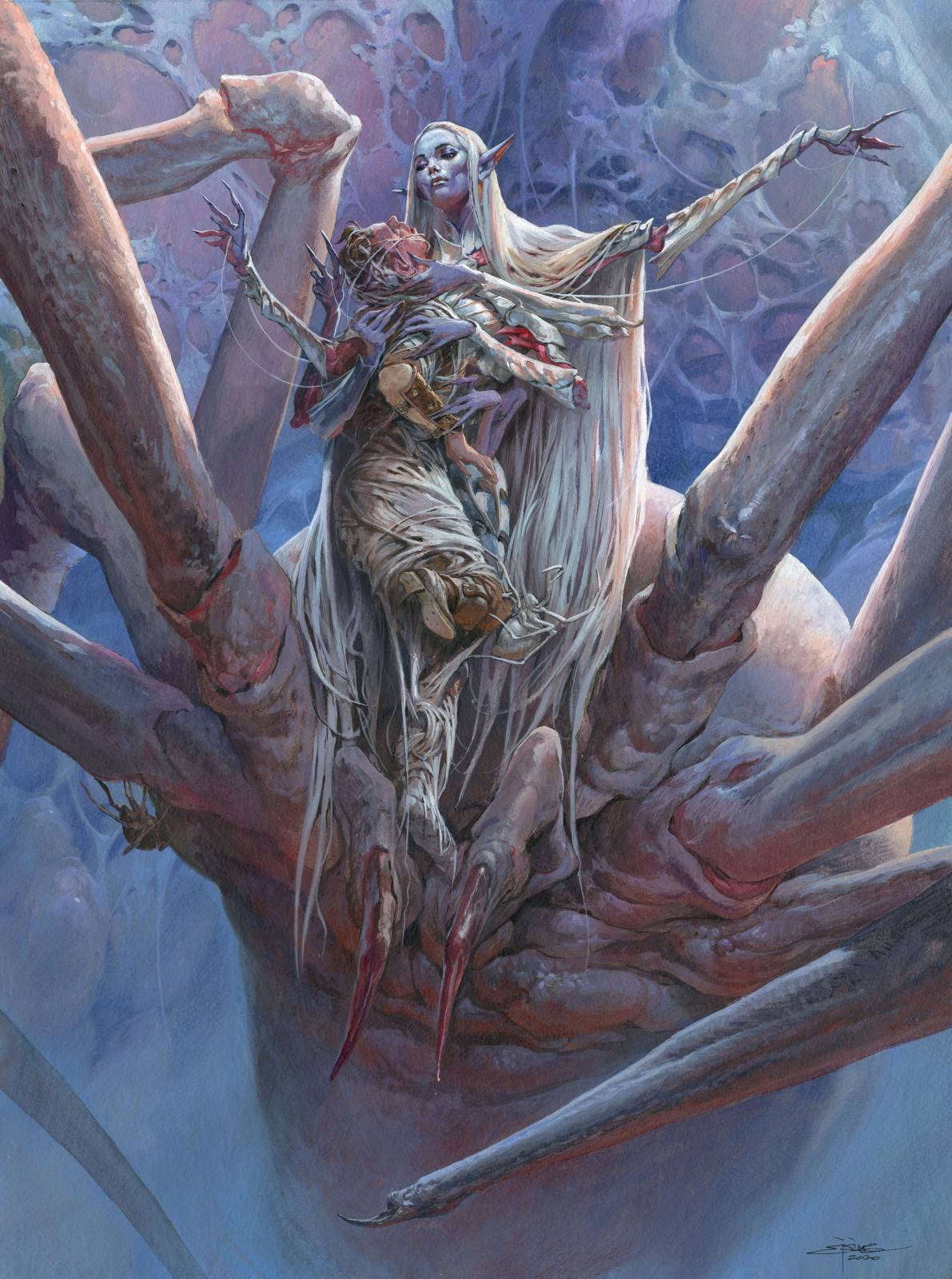

Sorcerer
Arcane Soul Origin
Some people are born inherently magical, recognized from childhood for their unusual nature. With such a potent source of magic imbued within them, strange, unpredictable events occur in their wake. Many paths can lead to such a fate. An alchemical attempt to raise the dead could leave the subject forever changed, implanted with a magical heart overflowing with power. Or, a creature could be born with an elemental spark within them, suffusing them with ceaseless energy.
However it got there, within every arcane soul sorcerer is a pulsing source of neigh boundless power that they struggle to control.
Arcane Soul Features
| Sorcerer Level | Feature |
|---|---|
| 1st | Origin Spells, Raw Magic |
| 6th | Overcharged Magic |
| 14th | Arcane Fuel |
| 18th | Strength Beneath the Skin |
Arcane Soul Origin Spells
| Sorcerer Level | Spells |
|---|---|
| 1st | magic missile |
| 3rd | nystul's magic aura |
| 5th | dispel magic |
| 7th | dimension door |
| 9th | wall of force |
Raw Magic
When you choose this origin at 1st level, you learn the prestidigitation cantrip and you can cast the detect magic spell at will, without expending a spell slot.
Additionally, your soul can serve as your Arcane Focus. You can ignore any material components of your sorcerer spells that lack a cost and aren't consumed by the spell.
Overcharged Magic
Starting at 6th level, you gain resistance to force damage. You also gain the Empowered Spell metamagic option, or another metamagic if you already have it. When you modify a spell that deals damage with your Metamagic options, you can add your Charisma modifier to one damage roll of that spell.
Arcane Fuel
At 14th level, when you cast dispel magic and remove a magical effect, you regain up to two expended sorcery points as you draw in the remnants of the broken magic.
Additionally, you can use a reaction when you would take force damage to absorb the magical energy of the attack. Instead of taking damage, you regain a number of hit points equal to half the damage of the attack, before resistances. Once you regain hit points with this ability a number of times equal to your Charisma modifier, a long rest is needed before you can do so again.
Strength Beneath the Skin
At 18th level, you can tap the power that surges through your blood to replenish your magic. As a bonus action, you can expend a hit die and regain Sorcery Points equal to the number rolled + your Charisma modifier. Once you do this, you cannot do so again until you complete a long rest.


Fey Lineage Origin
Your magic is influenced by the changeable nature of the feywilds, and your powers shift with the seasons themselves.
Fey Lineage Features
| Sorcerer Level | Feature |
|---|---|
| 1st | Seasonal Spells, One With Nature |
| 6th | Ecological Embodiment |
| 14th | Season's Zenith |
| 18th | Avatar of the Seasons |
One With Nature
Starting at 1st level, you gain proficiency in the Nature skill and you learn the druidcraft cantrip.
Seasonal Spells
At 1st level, choose a season to attune yourself to. You gain the cantrip from the attuned season. You prepare a number of spells from the associated spell list equal to your proficiency bonus of a level for which you have spell slots. They count as sorcerer spells for you. You can change your prepared spells, and the season you are attuned to when you finish a long rest.
Autumn
| Spell Level | Spells |
|---|---|
| Cantrip | gust |
| 1st | feather fall, zephyr strike |
| 2nd | gust of wind, warding wind |
| 3rd | create food and water, wind wall |
| 4th | blight, death ward |
| 5th | control winds, creation |
Winter
| Spell Level | Spells |
|---|---|
| Cantrip | frostbite |
| 1st | armor of agathys, ice knife |
| 2nd | moonbeam, snilloc's snowball swarm |
| 3rd | sleet storm, slow |
| 4th | control water, ice storm |
| 5th | cone of cold, hold monster |
Spring
| Spell Level | Spells |
|---|---|
| Cantrip | thorn whip |
| 1st | entangle, goodberry |
| 2nd | lesser restoration, spike growth |
| 3rd | speak with plants, plant growth |
| 4th | aura of life, grasping vine |
| 5th | commune with nature, wrath of nature |
Summer
| Spell Level | Spells |
|---|---|
| Cantrip | produce flame |
| 1st | burning hands, searing smite |
| 2nd | scorching ray, heat metal |
| 3rd | blinding smite, daylight |
| 4th | fire shield, wall of fire |
| 5th | dawn, immolation |
Ecological Embodiment
At 6th level, your chosen season grants the following benefits:
Autumn. When you cast gust, you can push a creature that is Huge or smaller, and the distance you can push them increases up to 5 x your proficiency bonus feet. A target knocked prone or pushed by your sorcerer spells takes an extra 1d6 magical bludgeoning damage. This increases by 1d6 when you reach 9th level (2d6) and 17th level (3d6).
Winter. When a creature within 30 feet of you moves at least 10 feet, you can use a reaction to force it to make a Dexterity saving throw against your spell DC or fall prone.
Spring. When you cast a seasonal spell of 1st-level or higher, you regain hit points equal to your Charisma modifier. You can spend 1 sorcery point to also grant this same benefit to one other creature within 30 feet of you.
Summer. When you cast produce flame, you can hurl it up to 60 feet, rather than 30, and produce flame deals extra fire damage equal to your Charisma modifier when you hit.
Season's Zenith
At 14th level your seasonal magic flares with the intensity of the peak of your season.
Blessing of the Equinox (Autumn/Spring). Whenever you finish a short or long rest, you can either grant twice your sorcerer level + your Charisma modifier amount of temporary hit points (Autumn) or restore that number of hit points (Spring), divided as you choose among creatures that you can see within 30 feet of you. Affected creatures are also cured of any diseases or poisons affecting it.
Blessing of the Solstice (Winter/Summer). Whenever you or a creature within 30 feet of you would take cold or fire damage, you can use your reaction grant resistance to that creature against the damage until the end of your next turn. In addition, once on each of your turns when you make an attack or cast a spell that deals cold damage (Winter) or fire damage (Summer), you can add your Charisma modifier to one damage roll of that attack or spell.
Avatar of the Seasons
Starting at 18th level, when you finish a long rest, you can prepare your seasonal spells from any season's spell list.
You can spend 6 sorcery points as a bonus action to magically transform. For 1 minute, you gain the benefits of each season's Ecological Embodiment feature, and you can cast 1st or 2nd-level spells from any season's spell list at its lowest level without expending a spell slot. For the duration, you also gain a flying speed of 60 feet, but you fall if you end your turn in the air and nothing else is holding you aloft.
Haunted Origin
Your innate magic comes from a past encounter with death. Most often, this origin is traced back to surviving an attack from an undead, such as a vampire’s bite, a ghost’s possession, or a specter’s life drain. Or, it could have originated from an imperfect revival or near-death experience. Regardless of the way you attained this dark magic, it now dictates your life and greatly augments your power.
Haunted Features
| Sorcerer Level | Feature |
|---|---|
| 1st | Origin Spells, Necrotic Affinity, Memories of the Fallen |
| 6th | Ghostly Body |
| 14th | Incorporeal Figure |
| 18th | Possession |
Haunted Origin Spells
| Sorcerer Level | Spells |
|---|---|
| 1st | dissonant whispers |
| 3rd | pass without trace |
| 5th | vampiric touch |
| 7th | death ward |
| 9th | antilife shell |
Necrotic Affinity
Starting when you choose this origin at 1st level, your body becomes imbued with dark power. Your hit point maximum is increased by 1, and increases by 1 again whenever you gain a level in this class.
When your Spellcasting feature lets you learn or replace a sorcerer cantrip or a sorcerer spell of 1st level or higher, you can instead choose a necromancy spell from any classes' spell list, provided the spell is of a level you can cast. You must otherwise obey all the restrictions for selecting the spell, and it becomes a sorcerer spell for you.
Memories of the Fallen
Also at 1st level, you gain the ability to access the memories of the deceased. By performing a 1 minute ritual on a corpse, you can gain insight into how that creature died. If you already witnessed that creature’s death, you instead gain another random memory from that creature, as determined by your DM. This feature can only be used once per corpse.
Ghostly Body
At 6th level, your body can slowly fade into invisibility. If you remain still for 1 minute while in dim light or darkness, you become invisible until you move, enter bright light, or use an action, bonus action, or reaction.
Alternatively, you can use your bonus action and spend 1 sorcery point to activate this feature without waiting a minute, causing you to immediately become invisible.
Incorporeal Figure
Starting at 14th level, you have the ability to become temporarily incorporeal. As a bonus action on your turn, you can spend 2 sorcery points to become incorporeal, gaining the ability to move through objects as if the objects were difficult terrain, and you become immune to the grappled and restrained conditions. For the duration, your movement doesn't provoke opportunity attacks, and your speed is increased by 15 feet.
The incorporeal effect ends at the end of your next turn. If you are inside an object when the effect ends, you are ejected to the nearest empty space and take 1d10 force damage.
Possession
At 18th level, you gain the ability to take control of another creature’s body. As an action, you can spend 5 sorcery points to attempt to possess a creature of size Large or smaller within 5 feet of you. That creature must succeed on a Charisma saving throw against your sorcerer spell save DC or be possessed for up to 1 hour. On a success, you then disappear, and the target is incapacitated and loses control of its body, but not its awareness. While you are possessing a creature, you can't be targeted by any attack, spell, or other effect, and you retain your alignment, Intelligence, Wisdom, and Charisma scores. You otherwise use the possessed target's statistics, but you doesn't gain access to the target's knowledge, class features such as spellcasting and extra attack, or proficiencies such as skills and armor.
The possessed creature can repeat the saving throw whenever it takes damage, ending the effect on a success. You may also end the effect using your bonus action. A target is immune to this feature for 24 hours after succeeding on the saving throw or after the possession ends.
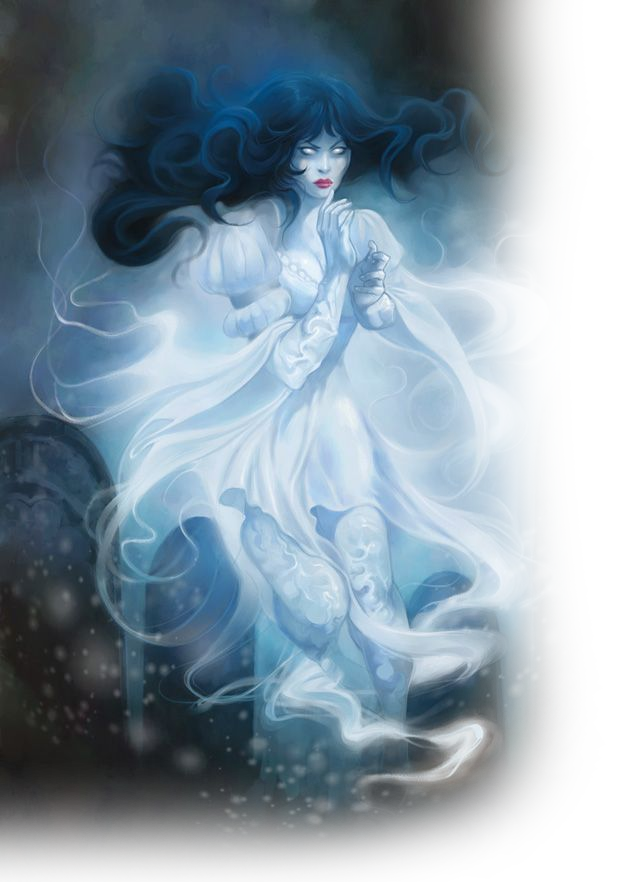

Hellspawn Origin
Somewhere in your bloodline, one of your ancestors made a pact with a powerful spirit of flame and predation. This creature may be an elemental, fiend, fey, or something else primal and otherworldly honored with ritualistic immolation and sacrifices of meat and metal.
With smoke and cinders pouring from your hands with each spell you cast and a layer of ash gradually creeping over your body, you are the incarnation of a smoldering ember thrown upon a dry forest.
Hellspawn Origin Features
| Sorcerer Level | Feature |
|---|---|
| 1st | Origin Spells, Born of Ember |
| 6th | Burning Fury |
| 14th | Wraith of Cinders |
| 18th | The Devil's Bargain |
Hellspawn Origin Spells
| Sorcerer Level | Spells |
|---|---|
| 1st | hellish rebuke |
| 3rd | heat metal |
| 5th | fireball |
| 7th | dominate beast |
| 9th | infernal calling |
Born of Ember
At 1st level, you can speak, read, and write Infernal, and you learn the produce flame cantrip, which counts as a sorcerer cantrip for you.
Whenever you are below half your hit point maximum, a thin layer of ash and char engulfs your skin and embers erupt from your hands. While you have this layer, you can cast the produce flame cantrip as a bonus action.
Burning Fury
Starting at 6th level, when you reduce a creature to 0 hit points with the produce flame cantrip, the burning fury empowering your attack surges through the creature, turning its vital organs to ash and granting you temporary hit points equal to twice your Charisma modifier.
Additionally, you can spend 1 sorcery point during your turn when you are below half your hit point maximum to cause the ash upon your skin to harden. Until the start of your next turn, you have resistance to fire and necrotic damage and your AC is 17 if it was lower.
At 14th level, you gain immunity instead of resistance.
Wraith of Cinders
At 14th level, your spark has grown to a flame, burning black with dark power. Any time you would inflict fire damage, you can choose to inflict necrotic damage instead, and vice versa.
Additionally, your ashen form allows you to move with unnatural ease, disintegrating and reforming with each step you take. You ignore difficult terrain, and you can move through any space at least 6 inches wide without squeezing.
The Devil’s Bargain
At 18th level, your power over the ancient and primal magics of flame and darkness is without peer.
As an action, you can spend 5 sorcery points to launch yourself skyward in a pillar of fire and smoke before crashing down at a location that you can see within 60 feet of your point of origin, unleashing a hellish blast of fire and cursed power at a creature within 5 feet of you. The target must make a Wisdom saving throw against your sorcerer spell save DC, taking 6d10 fire damage on a failed save or half as much damage on a successful one.
If the target is slain by this attack, it is consumed instantly by flame, and the ashes coalesce into a hell hound (Monster Manual p182). The hell hound obeys your orders without question and acts during your turn. You can't have more than two hell hounds at a time from this feature. Creation of a third hell hound destroys the oldest one still alive. Each hell hound remains in your service until slain or until the third dawn after it was summoned, at which point it disintegrates into ash.
Once you use this feature, you can’t do so again until you finish a long rest.


Imperial Bloodline Origin
There is power in king’s blood. Your innate magic comes from your royal ancestry. Whether you are a far flung cousin of a great house, the child of a deposed prince, a secret bastard denied legitimacy, or the rightful heir to a kingdom, your bloodline is that of kings and emperors. You might be unaware of your lineage and of the source of your power, or perhaps you have always known yourself to be the true inheritor of a throne now held by usurpers.
Imperial Bloodline Origin Features
| Sorcerer Level | Feature |
|---|---|
| 1st | Origin Spells, Ancestral Homeland, Commanding Voice |
| 6th | Majestic Presence, Royal Decree |
| 14th | Bend the Knee |
| 18th | Ancestral Title |
Imperial Bloodline Origin Spells
| Sorcerer Level | Spells |
|---|---|
| 1st | command |
| 3rd | spiritual weapon |
| 5th | conjure barrage |
| 7th | mordenkainen's private sanctum |
| 9th | geas |
Ancestral Homeland
Starting at 1st level, you gain proficiency in your choice of Intimidation, Performance, or Persuasion. You also learn a language of your choice and gain proficiency with a tool of your choice. You have advantage on Intelligence (History) checks to recall information about culture, people, and politics.
Commanding Voice
Also at 1st level, your bloodline has granted you a voice fit for a ruler, one that makes your enemies tremble and puts fire into the hearts of your allies. Whenever you cast a spell of 1st level or higher that has verbal components, you can grant temporary hit points equal to your Charisma modifier to a friendly creature other than yourself within 30 feet of you, which last for 1 minute.
Majestic Presence
Starting 6th level, you gain an aura of majesty that steels the hearts and minds of those who follow you. When you or a friendly creature within 30 feet of you makes a Charisma or Wisdom saving throw, you can use your reaction to grant them advantage on the saving throw.
You can use this feature a number of times equal to your Charisma modifier, regaining all expended uses when you finish a long rest.
Royal Decree
Also at 6th level, when you cast a spell with verbal components, you can spend 1 sorcery point to imbue your voice with magic. You can perform the verbal components regardless of any obstruction to your ability to speak, such physical restraints or the silence spell. If the spell involves speaking to a creature, that creature being deafened or not sharing a language with you does not prevent the creature from hearing and understanding you.
Bend the Knee
Beginning at 14th level, when one or more creatures fails the initial saving throw imposed by one of your spells, you can choose for them to also become frightened of you until the end of your next turn.
Ancestral Title
At 18th level, you adopt a title befit a legendary monarch, and gain permanent benefits associated with that title. Choose one of the following benefits:
The Great. Increase one ability score of your choice by 2. Your maximum for that score is now 22.
The Kind. You learn the spells sanctuary and protection from evil and good, which count as sorcerer spells for you. You can cast them at will, without expending a spell slot.
The Terrible. You are immune to being frightened and you have advantage on attack rolls against creatures that are frightened of you.
The Wise. Choose four of your skill or tool proficiencies. You gain expertise with them, which means your proficiency bonus is doubled for any ability check you make with them.
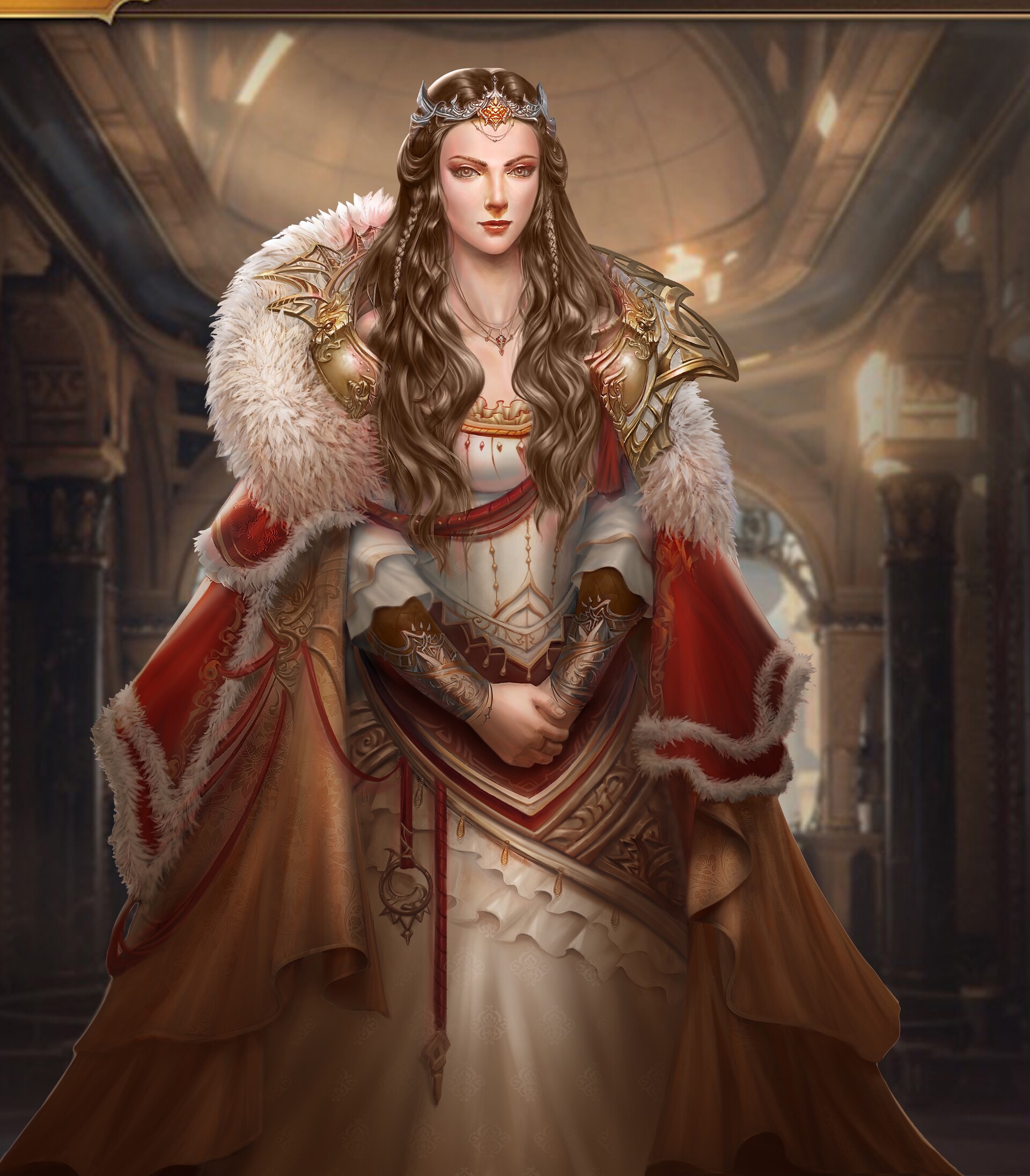

Phoenix Spark Origin
Your power draws from the immortal flame that fuels the legendary phoenix. You or your ancestors perhaps rendered a phoenix a great service, or you were born in its presence. Whatever the cause, a shard of the phoenix's power dwells within you. That power is a mixed blessing. Like the mythical creature, you can invoke fiery energy and gain the ability to cheat death itself. This power comes at a cost. The fire within you seethes, demanding to be unleashed. You sometimes find yourself absentmindedly feeding fires. You can't bear to allow a fire to sputter out. You feel most comfortable while holding a lit torch or sitting in front of a campfire.
Phoenix Spark Origin Features
| Sorcerer Level | Feature |
|---|---|
| 1st | Origin Spells, The Spark |
| 6th | Flames Ablaze |
| 14th | In Flames Reborn |
| 18th | Phoenix Unleashed |
Phoenix Spark Origin Spells
| Sorcerer Level | Spells |
|---|---|
| 1st | burning hands |
| 3rd | flaming sphere |
| 5th | fireball |
| 7th | fire shield |
| 9th | immolation |
The Spark
When you choose this Origin at 1st level, you have a spark within that burns more brightly when you use your magic. When you cast a spell of 1st level or higher that deals fire or radiant damage, the spark ignites and begins to blaze.
Upon casting the spell, you regain hit points equal to the level of the spell slot you expended. At the start of subsequent turns, you regain that amount minus 1 hit point per turn elapsed until it would restore 0 hit points, at which point the spark becomes dormant. If you are reduced to 0 hit points, the spark immediately goes dormant.
If you cast a spell that sets the spark ablaze while it is already ablaze, you regain hit points equal to the level of the spell you just cast and you can reset the amount of hit points the spark restores to the level of that spell if it is higher than what the spark would otherwise restore at the start of your next turn.
Flames Ablaze
Starting at 6th level, the spark within you strengthens, and you draw more deeply from its power. While the spark within you is ablaze, you gain the following benefits:
- You can add your Charisma modifier to one damage roll of spells that deal fire or radiant damage.
- As a reaction to taking fire or radiant damage, you can gain resistance to that instance of damage, and increase the level of your spark by 1.
In Flames Reborn
Starting at 14th level, when you ignite the spark within or while it is ablaze you can use a bonus action and expend 2 sorcery points to make the fire surge forth from you. Flames consumes your physical body leaving you as a winged shape of fire until the start of your next turn. You can extend the duration of this form for by expending an additional 2 sorcery points each round. In this form, you gain the effect of investiture of flame with following additional benefits:
- You have a flying speed of 30 feet and can hover.
- You become immune to the poisoned condition and to disease.
- The amount of hit points you regain from your Spark feature is doubled, however it still lasts for the same number of rounds.
- Your Spark does not go dormant if you reach 0 hit points.
When you return to your normal form, you gain one level of exhaustion.
Phoenix Unleashed
Starting at 18th level, as an action, you can take the form of a phoenix (MTF p199) for a number of rounds equal to your Charisma modifier. Your game statistics are replaced by the statistics of the phoenix, but you retain your alignment, personality, and Intelligence, Wisdom, and Charisma scores. You do not gain its Legendary Actions or Legendary Resistances. You can't cast spells, speak, nor take any action that requires hands. The equipment you wear merges into your new form and has no effect until you leave the form.
When the duration ends or you are reduced to zero hit points, the phoenix's Fiery Death and Rebirth feature is triggered, leaving behind your normal form instead of an egg. If you revert as a result of dropping to 0 hit points, any excess damage carries over to your normal form.
Once you use this feature, you cannot use it again until you complete a long rest.


Stoneheart Origin
Your blood comes from a steadfast lineage, touched by the elemental forces of the earth itself. Be it the blood of ancient dwarves first formed from stone or from a dao lineage, your heart beats more steadily than others.
Blessed with natural resilience and command over the ground you stand on, most Stoneheart sorcerers are solid and deliberate in both action and thought, slow to anger and often given to taking a long term point of view. However, if stirred to action, they are as stout and unwavering as rock.
Stoneheart Origin Features
| Sorcerer Level | Feature |
|---|---|
| 1st | Origin Spells, Bonus Proficiencies, Heart of Stone |
| 6th | Stone Aegis, Extra Attack |
| 14th | Stonewalk |
| 18th | Unity of Stone |
Stoneheart Origin Spells
| Sorcerer Level | Spells |
|---|---|
| 1st | earth tremor |
| 3rd | earthbind |
| 5th | erupting earth |
| 7th | stoneskin |
| 9th | wall of stone |
Bonus Proficiencies
At 1st level, you gain proficiency with simple and martial weapons.
Heart of Stone
When you choose this origin at 1st level, you can draw upon the earthen magic within you harden your physical form for a limited time. Starting at 1st level, you can use a bonus action to take on an elemental form, your physical form becomes covered in rock and stone, and you gain the following benefits:
- If you are not wearing armor, you armor class is equal to 13 + your Constitution modifier.
- When you cast a spell, you can use your Strength modifier in place of your Charisma modifier.
- When you make a weapon attack, you can use your Charisma modifier in place of your Strength modifier.
This transformation lasts for one minute, or until you end it as a bonus action or fall unconscious. You can use this ability a number of times equal to your proficiency bonus, and you regain all expended uses when you finish a long rest.
Stone Aegis
Starting at 6th level, as a bonus action, you can expend 2 sorcery points to create a visible aura of protection on yourself or another allied creature you can see within 60 feet on you. The shield lasts for 1 minute, until you use it again, or until you are incapacitated.
Once per turn, when the creature takes bludgeoning, piercing or slashing damage, the aegis absorbs some of the damage from the attack and empowers you with it. The damage the protected creature takes is reduced by 1d6, and you store that power in yourself.
Your next damage roll that deals bludgeoning, piercing or slashing damage is bolstered by the power you stored, and you add your stored number of d6s to the roll. You can store a maximum of two hits (2d6 total), and once the maximum is reached you must expend the stored power before the aegis can absorb more damage.
The maximum number of hits you can reduce the damage of and store energy from before expending it increases to three (3d6) at 11th level, and to four at 17th level (4d6).
Extra Attack
Starting at 6th level, you can attack twice, instead of once, whenever you take the Attack action.
Stonewalk
Starting at 14th level, you gain a burrowing speed of 15 feet, allowing you to travel through the earth. You can pass through nonmagical, unworked earth and stone, leaving no hole behind you. If you would end your turn inside of earth or stone, you are pushed back to where you entered the earth or stone's surface.
Unity of Stone
Starting at 18th level, whenever you transform with your Heart of Stone feature, you gain temporary hit points equal to your sorcerer level. The temporary hit points disappear when your transformation ends.
Additionally, your Stone's Aegis no longer requires sorcery points to use, and when you use it to protect someone other than yourself, you can create another aegis on yourself as part of the same bonus action. The maximum number of hits these shields can store are counted together as part of the same total.



Tideborn Origin
A lineage tethered to the deepest of depths, you trace your powers back to the heartbeat of the ocean. Perhaps your ancestor was born below the waves and ascended in search of the world above, or perhaps they were the survivor of a shipwreck, having struck a bargain with one of the great gods below the disappearing light. Perhaps even you, yourself, were born amidst the aftermath of a devastating tsunami, your feet treading water long before they touched the ground.
Tideborn feel the push and pull of the ocean much akin to their own heartbeat. They understand the incessant, relentless rhythm of their ancestry unlike any other. They may venture inland in search of fame, glory, or an escape from their coastal calling, but conscious or not, they will eventually respond to the pull of a homebound tide.
Tideborn Origin Features
| Sorcerer Level | Feature |
|---|---|
| 1st | Origin Spells, Born of Water, Ebb And Flow |
| 6th | Cascading Torrent |
| 14th | Riptide Core |
| 18th | King of the Tide |
Tideborn Origin Spells
| Sorcerer Level | Spells |
|---|---|
| 1st | create or destroy water |
| 3rd | misty step |
| 5th | wall of water |
| 7th | control water |
| 9th | maelstrom |
Born of Water
When you choose this origin at 1st level, your natural affinity for the sea grants you several gifts. You gain the ability to breathe underwater, and you have a swim speed of 30 feet. If you already have a swimming speed, your swimming speed is increased by 10 feet.
Ebb And Flow
Starting at 1st level, your body moves in time with the rhythm of the tides, allowing you to imbue your magic with powerful momentum. Whenever you cast a spell of 1st level or higher that successfully affected a creature other than yourself, you gain advantage on your next attack roll made against a different creature. This advantage lasts until the end of your next turn, and if you hit with this attack against a Large or smaller creature, you can choose to knock it up to 10 feet away from you. This distance increases by 5 feet at your 6th and 11th level in this class.
Cascading Torrent
Starting at 6th level, your attunement with the tide improves and your command over its unrelenting force increases. Whenever you forcibly move a creature, that creature takes 1d8 cold damage for every 10 feet it is moved (up to a maximum of 3d8), as a torrent of water bombards it along its trajectory. A creature can take this damage once on a turn.
Additionally, whenever you forcibly move a creature, you can spend 1 sorcery point to instead move them in any horizontal direction of your choosing.
Riptide Core
Starting at 14th level, the tides will answer your call no matter where you may be. As as action, you create a swirling mass of water that violently circles around you in a 30 foot radius for 1 minute. This area is considered difficult terrain. Any creature that starts it's turn in the area must succeed on a Strength saving throw. On a failed save you can force the tides to carry them up to 30 feet in any direction within the area of effect.
Once you use this feature, you cannot do so again until you finish a long rest or you expend 5 sorcery points to use it again.
King of the Tide
At 18th level, you exist in pure harmony with your aquatic heritage; you move as the sea does, fluid and unstoppable. You can use your bonus action to take on a watery form until the end of your turn, or spend 2 sorcery points to use this form as a reaction to taking damage.
While in this watery form, you have resistance to bludgeoning, piercing, and slashing from non-magical attacks. Additionally, you ignore difficult terrain and can move through any enemy's space but can't willingly end your move there. You can move through any space that is at least 3 inches in diameter and do so without squeezing.
If you move in this form while your Riptide Core feature is active, creatures within the area of effect must make a Strength saving throw against your Sorcerer spell save DC or fall prone and be dragged along with your movement.



Warlock
The Archmage Patron
Your pact is with an extremely powerful spellcaster, a legendary master of the arcane. Perhaps you have come into possession of a relic of theirs that holds a connection to their essence, or perhaps you have fallen under the tutelage of a demilich. Regardless of how you contact them, such spellcasters are immensely powerful, and are directly connected to the Weave. For your service, they can teach you the deepest secrets of arcana.
Arcane beings powerful enough to forge such a pact include Vecna, Elminster, Mordenkainen, Karsus, Iggwilv, Laeral Silverhand, Halaster Blackcloak, and Acererak.
Archmage Patron Features
| Warlock Level | Feature |
|---|---|
| 1st | Expanded Spell List, Arcane Storage |
| 6th | Unbreakable Spell |
| 10th | Spell Resistance |
| 14th | Induce Weakness |
Archmage Patron Expanded Spell List
| Spell Level | Spells |
|---|---|
| 1st | magic missile, tenser's floating disk |
| 2nd | melf's acid arrow, nystul's magic aura |
| 3rd | fireball, leomund's tiny hut |
| 4th | mordenkainen's faithful hound, otiluke's resilient sphere |
| 5th | bigby's hand, rary's telepathic bond |
Arcane Storage
Starting at 1st level, your pact allows you to prepare a spell for later usage. When you finish a long rest, you can choose one warlock spell you know, to a maximum of 5th level. You can cast that spell once without using a warlock spell slot, but cannot cast it otherwise, until you finish a long rest.
Unbreakable Spell
When you reach 6th level, if a spell you cast is dispelled, or if you would lose your concentration on a spell before its duration ends, you can use your reaction to maintain concentration on the spell or prevent its dispelling.
Once you use this ability, you can't use it again until you finish a short or long rest.
Spell Resistance
Starting at 10th level, your dealings with the arcane give you a measure of protection from spells. You have resistance to damage from spells.
Induce Weakness
At 14th level, as an action, you can weaken a creature you can see within 30 feet and make it more easily influenced and damaged by magic. The creature must make a Charisma saving throw against your warlock spell save DC. On a failure, the creature becomes vulnerable to damage from spells until the end of your next turn, and has disadvantage on saving throws against spells for 1 minute. The creature can repeat the saving throw at the end of each of its turns, ending the effect on a successful save.
Once you use this feature, you can't use it again until you finish a long rest.


The Blood Lord Patron
Your patron is an elusive, mysterious creature who thirsts for blood. Perhaps it is a fiendish creature from the nine hells, or a bloodthirsty abomination from the outer planes, or an elder vampire from Shadowfell. In exchange for mighty gifts, it demands ignominious rituals and grisly sacrifices.
Blood Lord Patron Features
| Warlock Level | Feature |
|---|---|
| 1st | Expanded Spell List, Village Rites, Grim Gifts |
| 6th | Blood Curse |
| 10th | Tainted Blood |
| 14th | Blood Sacrifice |
Blood Lord Patron Expanded Spell List
| Spell Level | Spells |
|---|---|
| 1st | cure wounds, inflict wounds |
| 2nd | lesser restoration, warding bond |
| 3rd | aura of vitality, feign death |
| 4th | death ward, dominate beast |
| 5th | contagion, dominate person |
Village Rites
At 1st level, your connection to your patron saint has granted you additional knowledge and abilities. You gain proficiency in the Medicine skill and you can use a dagger as the spellcasting focus for your warlock spells.
In addition, you learn the spare the dying and thaumaturgy cantrips. They are warlock cantrips for you, and do not count against your number of cantrips known.
Grim Gifts
Beginning at 1st level, as a bonus action, you can call upon the power of your dread patron. For 1 minute, or until you become incapacitated or die, you gain the following benefits:
- You have advantage on saving throws against the frightened condition and against curses and effects that affect your soul or possess your body.
- Whenever you deal damage with a warlock cantrip or a weapon attack, you can choose to deal necrotic damage instead of the normal damage.
- Whenever you regain hit points, you gain additional hit points equal to your Charisma modifier.
You can use this feature a number of times equal to your Charisma modifier, and you regain all expended uses when you finish a long rest.
Blood Curse
Starting at 6th level, you can punish those who would harm you with an unholy curse. When a creature makes an attack roll against you or an ally within 30 feet of you, you can use your reaction to force the creature to make a Constitution saving throw against your warlock spell save DC. On a failed save, the creature takes necrotic damage equal to your warlock level and is blinded. On a successful save, the creature takes half as much damage and is not blinded. A blinded creature can repeat its saving throw at the beginning of each of its turns, ending the effect on a successful save.
Once you use this feature, you can't use it again until you finish a short or long rest.
Tainted Blood
At 10th level, your body becomes altered by the power within your blood. You become immune to disease and the poisoned condition, and you gain resistance to necrotic and poison damage.
Blood Sacrifice
Starting at 14th level, you can use your action to sacrifice your own life force to have the power of your patron explode from your form. When you do so, you immediately drop to 0 hit points, though you are considered stable, and you gain a level of exhaustion. Choose from one of the following effects:
Renewal. Your blood reinvigorates other creatures. You can restore a number of hit points equal to five times your warlock level. Choose any number of creatures within 30 feet of you, not including yourself, and divide those hit points among them. Additionally, any curse, disease, or poison currently affecting the target creatures immediately ends.
Defilement. Your blood bursts outwards. All hostile creatures within 30 feet of you must make a Constitution saving throw against your warlock spell save DC. On a failed save, a creature takes 6d10 necrotic damage and is cursed for 1 minute. While cursed, a creature suffers from the effects of the bane spell. On a successful save, the creature takes half as much damage and isn't cursed.
Once you use an effect granted by this feature, you can't use either effect again until you finish a long rest.



The Great Ooze Patron
You have met with the fate of many an adventurer or dungeon delver; enveloped by a wandering cube of sentient ooze. You might have escaped death, but became forever altered by the hunger that dwells in the darkness. You might have even sought this entity out, seeking the patrons of elder oozes like Ghaunadaur and Juiblex, who have consumed great knowledge and powers beyond your ken over the centuries from their living prey, and from them too, gained desires beyond mere hunger. Or perhaps you were merely an Oblex spawn; a construct with old memories that remained behind after being separated from your tether.
Great Ooze Patron Features
| Warlock Level | Feature |
|---|---|
| 1st | Expanded Spell List, Family of Ooze, Consumed Memories |
| 6th | Cellular Division |
| 10th | Acidic Body |
| 14th | Ooze Assimilation |
Great Ooze Patron Expanded Spell List
| Spell Level | Spells |
|---|---|
| 1st | grease, tasha's caustic brew |
| 2nd | enlarge/reduce, melf's acid arrow |
| 3rd | meld into stone, water walk |
| 4th | stone shape, vitriolic sphere |
| 5th | acid slick*, contagion |
Extra Spells
If not using "Advanced Arcanum: Expanded Spells", acid slick can be replaced with cloudkill.
Family of Ooze
At 1st level, you gain the ability to speak with oozes and communicate simple concepts, even if they can't speak a language. You do not take acid damage that would be caused by a non-hostile ooze touching you.
Consumed Memories
At 1st level, you learn to absorb the bodies of the dead and learn from their lives. As an action while standing adjacent to a corpse, you can produce an iridescent acid that consumes the corpse over the course of 1 minute. Once the process has finished, you can reabsorb the acid to gain the memories from the creature's last 48 hours alive.
Once you use this feature, you can't use it again until you finish a long rest.
Cellular Division
At 6th level, your body becomes more flexible and fluid. Whenever you suffer damage, you can use your reaction to divide into a Medium swarm of Tiny oozes. Your hit points remain the same, and you function as a single unified swarm that occupies the same space as a Medium creature.
While in this state, you can't take actions other than the Dash action, your movement speed is halved, you gain resistance to bludgeoning, piercing, and slashing damage, immunity to acid and poison damage, you don't provoke opportunity attacks, and you can move through any space as narrow as 1 inch without squeezing. You can return to your normal form at will without using an action, provided there is room to do so.
Once you use this feature, you can’t use it again until you finish a long rest. Starting at 10th level, you can use this feature at will as an action. Using this feature as a reaction is still limited to once per long rest.
Acidic Body
At 10th level, your form is infused with caustic power and you gain resistance to acid damage. Whenever a creature starts its turn in a grapple with you, you can choose to have it take 2d8 acid damage.
Ooze Assimilation
Starting at 14th level, your otherworldly nature grants you advantage on all saving throws against being charmed. You also gain the ability to cast the polymorph spell, but the target can only be turned into an ooze. You can cast this spell using a warlock spell slot or without expending a spell slot. When you cast it without expending a spell slot, the spell is cast at its lowest level and you can’t do so again until you finish a long rest.
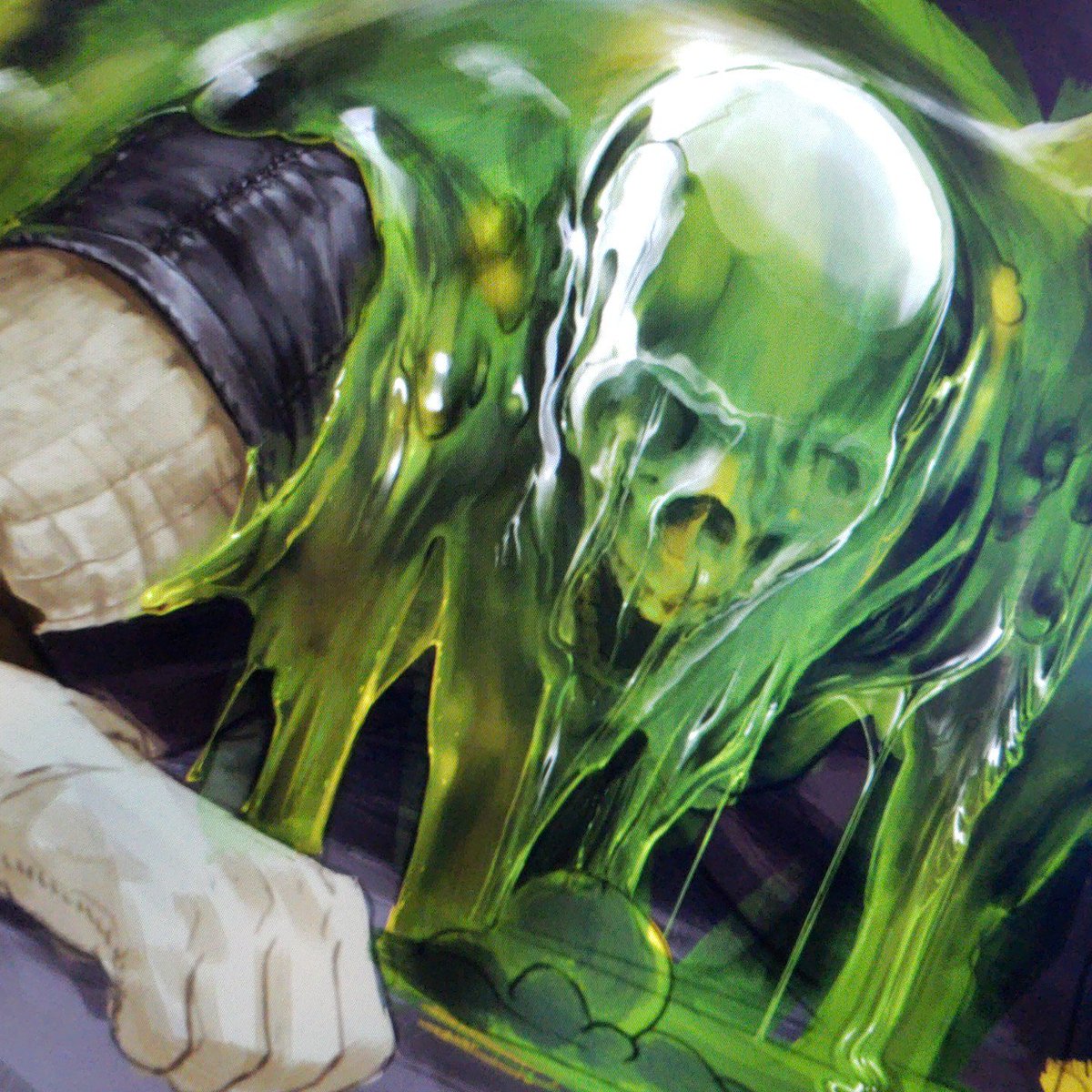


The Seer Patron
You have made pact with a being of ancient knowledge and foresight that sees through time and, perhaps, into different realms. Your patron may be a being of fate itself, said to be nigh omniscient and all-powerful. The actual nature of this being can vary greatly, it can be a Pact with an inscrutable sphinx, an ancient spirit, or perhaps even a sentient tome.
You can leverage this pact to forge your own fate, delve the secrets that others do not even know exist, and perhaps even understand the philosophical mechanics of existence.
Seer Patron Features
| Warlock Level | Feature |
|---|---|
| 1st | Expanded Spell List, Ancient Secrets |
| 6th | Architect of Reality |
| 10th | Seer's Mind, Gifted Sight |
| 14th | Fleeting Omniscience |
Seer Patron Expanded Spell List
| Spell Level | Spells |
|---|---|
| 1st | identify, tasha's hideous laughter |
| 2nd | detect thoughts, locate object |
| 3rd | clairvoyance, speak with dead |
| 4th | divination, leomund's secret chest |
| 5th | legend lore, skill empowerment |
Ancient Secrets
When you select this Patron at 1st level, you can access the ancient secrets your patron has granted you. By expending a pact magic spell slot of at least one level higher than the spell you want to cast (or a first level spell slot for a cantrip), you can cast a Divination, Transmutation or Abjuration spell from any classes' spell list. It counts as a Warlock spell for you when you cast it this way.
You can do this a number of times equal to your Charisma modifier, and regain all uses of this feature at the end of a long rest.
Architect of Reality
Starting at 6th level, your understand of the cosmic forces are developed enough that if you see a creature casting a spell, you can use your reaction to know what the spell is. If a spell you identify with this check would force you to make a saving throw, you can make that saving throw with advantage.
Additionally, your comprehension of magic allows you to access magic beyond your own power. You can cast from a Spell Scroll even if the spell isn't on your spell list, and you can add your proficiency bonus to the ability check to successfully cast from a Spell Scroll.
Seer's Mind
Starting at 10th level, when you make a concentration saving throw, if you are concentrating on a Divination school spell, you automatically succeed on the saving throw. If you are concentrating on a spell from another school, you can add your spell casting modifier to the result.
Gifted Sight
Additionally at 10th level, you gain the eldritch invocation Eyes of the Rune Keeper and it does not count against your Invocations Known. If you already have this invocation, you can select either Beast Speech or Eldritch Sight instead.
Fleeting Omniscience
Starting at 14th level, you can bind the knowledge of all magic past and future together into a single cohesive concept. As a bonus action, you can replace your spellcasting ability modifier with the sum of your Intelligence, Wisdom, and Charisma modifiers until the end of your turn.
Once you use this feature, you cannot use it again until you finish a long rest.
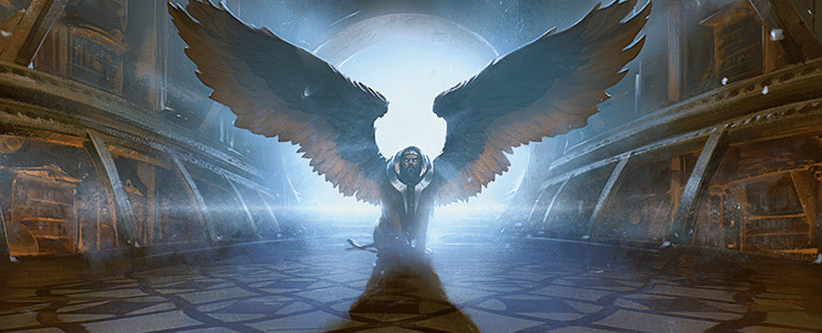




The Soul Broker Patron
Hushed whispers fill your mind, informing you that your life is not entirely your own. You are a cog in the machine, with a contract, rules, and powers given and taken. You have bargained away life and soul to some dark dealer to gain some measure of power from the broker with whom you've made your pact. Sin is debt, and absolution is paid in tithes of gold and blood.
Soul Broker Patron Features
| Warlock Level | Feature |
|---|---|
| 1st | Expanded Spell List, Interplanar Trader, Magic at a Price |
| 6th | Question the Soul |
| 10th | Paid in Blood |
| 14th | Soul Puppeteer |
Soul Broker Patron Expanded Spell List
| Spell Level | Spells |
|---|---|
| 1st | command, identify |
| 2nd | arcane lock, knock |
| 3rd | glyph of warding, tiny servant |
| 4th | compulsion, fabricate |
| 5th | dominate person, teleportation circle |
Interplanar Trader
When you choose this patron at 1st level, you can conceal currency you possess in a pocket dimension, which you can access using a bonus action. If you die, the currency reappears on your corpse.
As an action, you can open a small portal to purchase items directly from your patron. You may purchase items listed in the Player's Hand Book Weapons, Armor, Shields, Mounts, Vehicles, Adventuring Gear, and Tools section at their listed price. You may also purchase any material components with a gold cost for your warlock spells.
Once you open a portal this way, you cannot do so again until you finish a long rest.
Magic at a Price
Also at 1st level, you can capture souls with gold and with blood. When a humanoid you can see within 60 feet of you dies, you may use your reaction to capture that creature's soul and create a soul coin. Once a soul is captured, the dead creature it came from can't be revived.
As an action, you can sacrifice a soul coin to your patron to purchase magical protection. For 8 hours, if you are wearing no armor and wielding no shield, your base AC becomes 10 + your Charisma modifier + your Dexterity modifier.
You can have a maximum number of soul coins equal to your Charisma modifier at any one time. When you finish a long rest and have no soul coins, you gain one soul coin.
Question the Soul
At 6th level, your mastery over souls allows you to read your servants and adversaries alike. As an action, you can touch a creature and force them to make a Wisdom saving throw against your warlock spell save DC. On a failed saving throw, the target is paralyzed until the start of your next turn as you demand answers of their soul. While the target is paralyzed, you can ask them up to five questions (no action required) and receive brief telepathic answers, which you can understand regardless of the language used. The soul is limited by its knowledge, but must answer you truthfully and to the best of its ability. The answer is no more than a sentence or two and might be cryptic.
Once you use this feature, you cannot use it again until you finish a short or long rest.
Paid in Blood
At 10th level, your captured souls buy even greater magic. While you are protected by your Magic at a Price feature, you may use an action on your turn to partially shift onto the ethereal plane. Until the start of your next turn, you have resistance to all damage and become invisible to creatures more than 10 feet away from you.
Additionally, if you would be reduced to 0 hit points and you are protected by your Magic at a Price feature, you may immediately sacrifice the remnants of the soul (no action required), ending the effects of Magic at a Price to instead drop to 1 hit point. Once you use this ability, you cannot do so again until you finish a long rest.
Soul Puppeteer
At 14th level, as an action, you can attempt to magically ensnare a creature you can see within 60 feet of you. The target must make a Wisdom saving throw against your warlock spell save DC. If they fail, you ensnare the creature. You can see and hear through an ensnared creature's senses, gaining the benefits of any special senses that the target has. As part of the action when you use this feature, and as a bonus action on subsequent turns, you can command it to take the Attack, Dash or Help action. When you do, the creature immediately uses its reaction to take the commanded action targeting a creature or creatures of your choice if applicable.
You must concentrate on this ability as though concentrating on a spell. A creature repeats this saving throw at the end of each of its turns and whenever it takes damage, ending the effect on a success.
Once you attempt to magically ensnare a creature, you can't do so again until you finish a long rest.

The Sovereign Patron
Your patron is a king maker, an emperor-creator, and is the architect behind some of the greatest rulers existence ever has known. Perhaps they were a king of a forgotten line, only appearing before beings considered 'worthy'. Perhaps they were an indescribably ancient sage who has watched over and guided monarchs into the brightest of golden ages and through the blackest of dark ages. Whoever the Sovereign is, this being beckons and yearns for a worthy successor who embodies the chivalric values of their lands.
Sovereign Patron Features
| Warlock Level | Feature |
|---|---|
| 1st | Expanded Spell List, Chosen Heir |
| 6th | Knightly Steed |
| 10th | The Lord's Will |
| 14th | Long Live the King |
Sovereign Patron Expanded Spell List
| Spell Level | Spells |
|---|---|
| 1st | command, heroism |
| 2nd | calm emotions, zone of truth |
| 3rd | crusader's mantle, tiny servant |
| 4th | aura of purity, leomund's secret chest |
| 5th | dispel evil and good, dominate person |
Chosen Heir
Beginning at 1st level, you can delve into reserves of might bestowed by your patron to overcome your enemies. As a bonus action or as a reaction when you would become frightened, you become immune to the frightened condition, gain temporary hit points equal to your warlock level, and benefit from the bless spell for 1 minute without requiring your concentration.
Once you use this feature, you cannot do so again until you finish a short or long rest.
Knightly Steed
At 6th level, you gain proficiency in the Animal Handling skill if you do not have it already. Additionally, you can use your action to expend a warlock spell slot to cast the spell find steed, and you can summon the creature beneath you, automatically riding it.
At 13th level, you can cast the spell find greater steed through this feature.
The Lord's Will
At 10th level, you can activate Chosen Heir whenever you fail a saving throw that causes you to be charmed, grappled, poisoned, prone, restrained or stunned. When you do so, you automatically succeed on the saving throw.
You can activate Chosen Heir this way once, and regain the ability to do so after a long rest. This does not stop you from activating Chosen Heir normally.
Long Live the King
At 14th level, your natural lifespan is doubled. Additionally, while under the effects of Chosen Heir, you gain the benefits of the shield of faith spell without requiring concentration and have advantage on Wisdom saving throws.


The Stormbringer Patron
You have made pact with a tempestuous being; born of wind, shrouded in rain, and heralded by thunder. An ancient elemental, powerful storm giant, or perhaps a demigod of disagreeable weather. Most of these patrons are obscure and volatile. What they sought through you may vary, but the magic they grant will prove to be a powerful asset in times of tribulation. Such powers tend to be far better at calling the chaotic power at their disposal than calming it, and many who ride the tempest will find the same is true for them, leaving destruction in their wake.
Stormbringer Patron Features
| Warlock Level | Feature |
|---|---|
| 1st | Expanded Spell List, Building Storm |
| 6th | Rolling Thunder, Heart of Thunder |
| 10th | Whispering Winds |
| 14th | Everstorm |
Stormbringer Patron Expanded Spell List
| Spell Level | Spells |
|---|---|
| 1st | feather fall, thunderwave |
| 2nd | gust of wind, levitate |
| 3rd | lightning bolt, sleet storm |
| 4th | ice storm, storm sphere |
| 5th | control winds, maelstrom |
Building Storm
Starting at 1st level, when you cast a spell of first level or higher on your turn, a storm begins to brew around you. The storm gains Storm Levels equal to the level of the spell slot used.
If you cast a spell while the storm is active, the storm level is increased by the level of the spell slot used. While a storm is active, you gain the effect of the storm's current level as well as all lower levels.
Your Storm Level can never exceed your maximum Storm Level, which is equal to 5 or half your warlock level (minimum of 1), whichever is lower.
| Storm Level | Effect |
|---|---|
| 1 | You can cast gust as a bonus action. |
| 2 | You can use your reaction to impose disadvantage on a ranged weapon attack made against a target within 15 feet of you. |
| 3 | You are under the effect of levitate. |
| 4 | If a creature ends their turn within 10 feet of you or strikes you with a melee attack, you can use your reaction to deal 1d8 lightning damage to them. |
| 5 | You gain flying speed equal to your movement speed. |
The storm loses 1 level each time you end your turn without casting a 1st level or higher spell. You can prevent the decay of storm by concentrating on maintaining the storm as if it were a spell for a duration of up to 1 minute, provided you aren't concentrating on any other spells. If you lose concentration on your Building Storm, you cannot start concentrating again until you cast another spell or take an action that increases Storm Levels.
Rolling Thunder
Starting at 6th level, you learn the spell call lightning. If you cast call lightning by expending a spell slot, your storm level does not decrease while you are concentrating on it. If your Storm Level is 3 or higher, you are considered under "stormy conditions" as per the spell, even if you are indoors.
Heart of Thunder
Also at 6th level, whenever you deal damage with the eldritch blast cantrip or a weapon attack, you can choose to replace the damage type with lightning or thunder damage.
Whispering Winds
Starting at 10th level, you can hear a whisper on the winds that tells you where they go what they do. You can predict the weather accurately up to 8 hours away, and know if any weather effect is natural or magical in nature.
Additionally, you may hear other things on the winds by way of what they hear; you can cast scrying without expending a spell slot or requiring any verbal or material components, but when cast in this way, your sensor can only hear and not see. A target gets a -5 to the save if they are in a place open to the wind (such as outdoors), and a +5 to a place that the wind could not reach (such as the Underdark).
Once you cast scrying in this way, you cannot cast it again until you complete a long rest.
Everstorm
Starting at 14th level, you can spend an action to start building a storm around you, or increase the storm level by one if you already have a storm.
Additionally, while you have a Storm Level of 1 or higher, you can use your action to conjure bolts of lightning as per a 3rd level call lightning spell, treating your Building Storm as the storm cloud.



The World Tree Patron
Your patron is an ancient and powerful tree, its fathomless consciousness dwarfing the minds of most other creatures. Its needs might be simple, or so complex as to be unable to see the forest for the trees. Oftentimes they seek out warlocks as agents to guard them and their home from would be ne'er-do-wells. Beings of this kind include unimaginably old trees in the feywild, particularly powerful treants or dryads, or even beings like Yggdrasil, the world tree.
World Tree Patron Features
| Warlock Level | Feature |
|---|---|
| 1st | Expanded Spell List, Leeching Vine |
| 6th | Mind of Thorns |
| 10th | Path to the World Tree |
| 14th | Force of Nature |
World Tree Patron Expanded Spell List
| Spell Level | Spells |
|---|---|
| 1st | entangle, longstrider |
| 2nd | barkskin, spike growth |
| 3rd | plant growth, speak with plants |
| 4th | grasping vine, stockade sprouts* |
| 5th | tree stride, wrath of nature |
*If not using "Advanced Arcanum: Expanded Spells", stockade sprouts can be replaced with guardian of nature.
Leeching Vine
At 1st level, you may use your action to have a life-stealing vine burst from your chest. Make a melee spell attack against an enemy within 15 feet of you. On a hit, the vine stabs into the creature and drains them of vitality. The creature takes magical piercing damage equal to your warlock level, and you regain hit points equal to the damage dealt.
Additionally, whenever you fail a death saving throw, the vine automatically lashes out and makes this attack against the nearest hostile creature within range.
After you recover hit points using this feature, you cannot make this attack again until you finish a short or long rest.
Mind of Thorns
At 6th level, your mind takes on the unyielding nature of your patron. When you make an Intelligence, Wisdom, or Charisma saving throw, you can use your reaction to gain advantage on the saving throw. The creature that provoked the saving throw must succeed on a Constitution saving throw against your warlock spell save DC or become poisoned until the end of their next turn. While they are poisoned, they are also blinded.
You may use this feature a number of times equal to your Charisma modifier, regaining expended uses after a long rest.
Path to the World Tree
Starting at 10th level, you can create a seed of your patron over the course of a 10 minute ritual. You can place this seed upon a dead creature as an action, consuming the seed. The creature rises as a zombie with 1 hit point.
The zombie will seek a path towards a destination you name when you plant the seed, as if under the effects of the find the path spell. It will ignore any creatures it encounters and will not stop unless it is destroyed. Once the zombie reaches its destination, it will fall to the ground and a sapling will sprout from the corpse. If you create a new seed the previous one ceases to function, and the zombie crumbles to the ground, a lifeless corpse once more.
Force of Nature
At 14th level, as an action, or whenever you are reduced to 0 hit points, you can choose to sprout a growth of thorns around you. The area within a 30-foot radius of you becomes difficult terrain as vines spread from you.
Creatures of your choice within the area at the start of its turn must make a Constitution saving throw against your warlock spell save DC. A creature takes 4d6 magical slashing damage on a failed save, or half as much damage on a successful one.
If created as an action, it lasts until the start of your next turn. If created when you are at 0 hit points, it lasts until you recover 1 hit point, or becomes permanent if you die.
This feature can be used once as an action, and once when you are at 0 hit points, and you recover these uses whenever you finish a long rest.



Wizard
Generalist Tradition
While many wizards focus on mastering a particular school of magic, there are a handful of wizards who want to master as much of the arcane arts as they can. These wizards, often called ‘generalists’, focus on acquiring spells and learning as much as they can regarding the arcane. These wizards learn how to eventually change their prepared spells, cast more spells, and increase their focus with spellcasting.
Generalist Tradition Features
| Wizard Level | Feature |
|---|---|
| 2nd | Arcane Repertoire, Recycle Magic |
| 6th | Adaptive Spellbook |
| 10th | Double Spell |
| 14th | Spell Expert |
Arcane Repertoire
Beginning when you select this tradition at 2nd level, your knowledge of magic has increased, as well as your skills at acquiring magic. You gain proficiency in the Arcana skill, and whenever you gain a wizard level, you can increase the number of spells that you add to your spellbook by 1.
Recycle Magic
Also at 2nd level, you have learned how to replenish your magical reservoir. When you cast a wizard spell of 1st level or higher, you can use your bonus action to regain an expended spell slot up to that spell's level (minimum of 1).
Once you use this feature, you cannot use it again until you finish a short or long rest.
Adaptive Spellbook
At 6th level, you have learned how to prepare at a moment's notice. As an action, you can swap out any number of your prepared spells for spells you do not have prepared.
Once you have used this feature, you cannot do so again until you finish a long rest.
Double Spell
By 10th level, you have learned enough about the mechanics behind spells to know how to push your limit with casting them. Whenever you cast a wizard spell of 1st level or higher, as part of the same action, you can cast another wizard spell with a casting time of 1 action provided that both spells do not require concentration and you have the appropriate spell slot necessary for both spells.
Once you have used this feature, you cannot do so again until you finish a short or long rest.
Spell Expert
By 14th level, whenever you lose concentration on a spell, you can use your reaction to instead maintain your concentration by expending a spell slot of the same level, or a number of lower level spell slots with a total number of levels equal to or greater than the level of the spell you are concentrating on.


Pathology Tradition
Curious minds delve in the mysteries of the world, and few hold more morbid fascination than the inner workings of diseases and plagues. Those that understand the nature of disease and pathogens are precious to any society, but are at the same time, they are feared by many for what they might deal in—for some of those that delve into the mysteries of disease do so for their own dark purposes. Appearing during plagues, whether of their own making or not, the reputation of the wizards of this tradition often leaves them as scapegoats for the superstitious.
Pathology Tradition Features
| Wizard Level | Feature |
|---|---|
| 2nd | Study of Medicine, Malignant Magic |
| 6th | Inoculation |
| 10th | Transmission |
| 14th | Pandemic |
Study of Medicine
Beginning when you select this school at 2nd level, you gain proficiency with the Medicine skill and the Herbalism kit. You have advantage on Wisdom (Medicine) checks to identify the nature or effects of disease.
Malignant Magic
Starting at 2nd level, your magic can leave a lingering touch behind. When you cast a spell of 1st level or higher that causes one or more creatures to make a saving throw, you can choose to transmit a minor disease to one or more creature that failed their saving throw. Each creature you choose counts as one use of this feature.
Roll a d4 at start of each of the affected creature's turns to determine the symptom for that turn. An affected creature can make a Constitution saving throw at the end of each of their turns, ending the disease on a success. Creatures immune to disease are immune to this feature.
| d4 | Symptom (Effect) |
|---|---|
| 1 | The target immediately spends their reaction sneezing and coughing. |
| 2 | The target feels fatigued, and their movement speed is reduced by 10 ft. until the start of their next turn. |
| 3 | The target feels dizzy and lightheaded. They have disadvantage on ability checks and saving throws until the start of their next turn. |
| 4 | The target suffers the effects of being poisoned until the start of their next turn. |
You can use this feature a number of times equal to your Intelligence modifier, and you regain all expended uses when you finish a long rest.
Inoculation
Starting at 6th level, you add the spell lesser restoration to your spellbook, and it counts as a wizard spell for you.
Additionally, your frequent exposure and intricate knowledge about the subject you study grants you advantage on all Constitution saving throws against being poisoned or affected by diseases, and you are immune to any disease you have contracted or successfully saved from in the past.
Transmission
Beginning at 10th level, you add the contagion spell to your spellbook if it is not there already. You know this spell by heart and it is always prepared, but does not count against your number of prepared spells.
Once per long rest, you may cast contagion once at its lowest level without expending a spell slot.
Pandemic
Starting at 14th level, your extensive experience with the nature and spread of disease allows you manipulate it. When a target within 30 feet is under the effect of a disease or the spell contagion, you can expend a spell slot as an action. All creatures within a range determined by the level of the spell slot expended of the target must make a Constitution saving throw or become affected by the disease or the contagion spell as if it were cast on it.
Once a creature passes this Constitution saving throw or recovers from the disease, they are immune to a Pandemic originating from the same disease or casting of the contagion spell.
| Spell Level | Radius |
|---|---|
| 1st or 2nd | 5 ft. |
| 3rd or 4th | 10 ft. |
| 5th or 6th | 20 ft. |
| 7th or 8th | 40 ft. |
| 9th | 1 mile. |




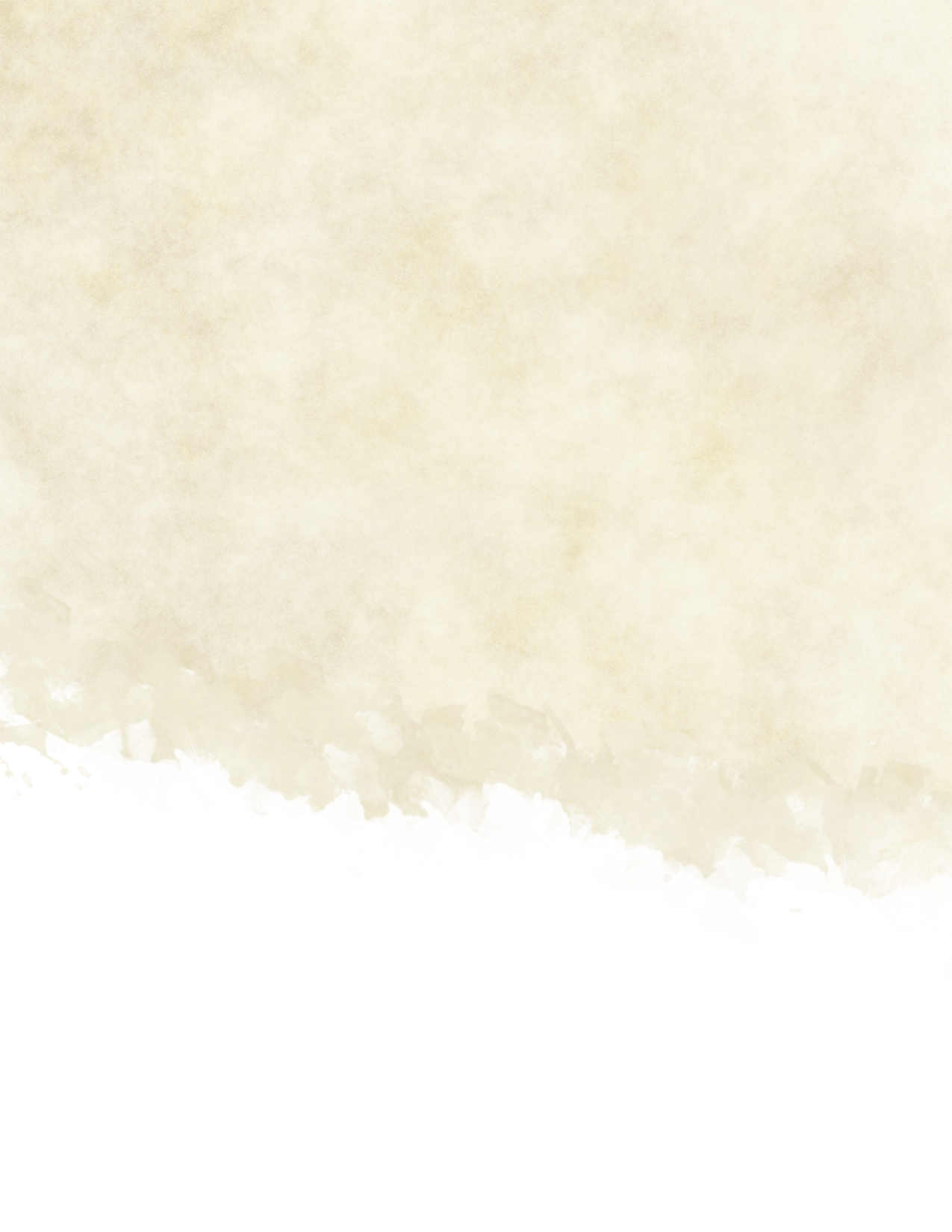
Shaman Tradition
Shamans have gained a spiritual connection with animals, ancestor spirits, supernatural creatures, and all elements of nature. They are in constantly linked with the spirits of the Spirit World. They call upon the spirits of the lost and ancient to grant them knowledge and power, seeking to gain from them. Shamans are obliged and required to offer prayers and services to the spirits in order to receive favors in the form of spells and aid to the natural world.
Shaman Tradition Features
| Wizard Level | Feature |
|---|---|
| 2nd | Spirit Guide, Spirit Magic |
| 6th | Ghost Touch |
| 10th | Spiritual Connection |
| 14th | Spirit Summoner |
Spirit Guide
When you choose this tradition at 2nd level, you can call upon the knowledge of spirits to gain insight on a variety of subjects. You add the find familiar spell to your spellbook if you don't already know it.
When you finish a long rest, you choose one skill of your choice from any of the following: Arcana, History, Religion, or Nature. You gain proficiency with that skill, or if you already have proficiency in the skill, your proficiency bonus is doubled for any ability check you make with that skill, until the end of your next long rest.
Spirit Magic
Also, at 2nd level, you can conjure forth spirits to cast spells. These spirits can be in the form of animals, spiritual ancestors, or spectral balls of light. When you cast a spell of 1st level or higher, you choose an unoccupied space within range of the spell, and a spirit appears at the point. The spirit remains there for up to 1 minute and provides bright light in a 10-foot radius and dim light for an additional 10 feet. You can have a number of spirits at once equal to half your wizard level. If a spirit you conjure would make you exceed your maximum, an existing spirit of your choice disappears.
Whenever you cast a spell, you may choose a spirit to deliver that spell instead of you. You treat the spell as if it originated from the spirit's space.
Additionally, you can use your bonus action to cause any number of spirits within 60 feet of yourself dissipate in a burst of magic. Each creature within 5 feet of a spirit must succeed on a Dexterity saving throw against your wizard spell save DC or take 2d6 force damage. A creature in the area of more than one spirit burst is affected only once.
Ghost Touch
At 6th level, as a bonus action on your turn, you can command a spirit within 60 feet of you to move up to 30 feet in any direction. You can have the spirit move into another creature. If you do, the spirit disappears and that creature must make a Dexterity saving throw against your wizard spell save DC. On a failed save, the creature takes 2d6 force damage.
Spiritual Connection
Starting at 10th level, you can channel magic between your spirits and have them echo your spells. When you cast a spell with an area of effect, you can choose an existing spirit within 60 feet of you to also carry the effect. Each creature within 10 feet of the chosen spirit is also affected by your spell. Once a spirit channels a spell this way, it disappears.
Spirit Summoner
At 14th level, you can channel your arcane energy to conjure spirits in an instant. As an action, you can expend a spell slot of 1st level or higher to create a number of spirits equal to the slot level, calling each into an unoccupied space you can see within 60 feet of you.


